TAPE 78/SB/08
THIS TAPE HAS BEEN RECORDED ON JANUARY 27TH 1979 AT 13 WHITEHEAD STREET, RAWTENSTALL. THE INFORMANT IS JOHN GREENWOOD, FORMER MANAGER AT SPRING VALE MILL. THE INTERVIEWER IS STANLEY GRAHAM.
Did you ever go away for a holiday when you were young?
R- Only ever once that I could remember. The first time we went away for a full week with the wakes except for this one occasion was when I was 18 years of age. And .. shall I tell you the story about the first holiday we ever had?
Yes, certainly John.
R- Because it arose in very peculiar circumstances, in as much as I've already said my father was a bit of a gambler. Well, he was more than a bit of a gambler you know. But there was a particular horse, and it was running in the Lincolnshire handicap, in March, and it was named Soranus. [1921]
What year would this be John, any idea? (50)
R- Oh it would be about 1920. And of course my mother's name was Sarah Anne and my father always called her Sarranny, and so the association of Sarranny and Soranus .. he fancied this gee-gee with the result that time and time again he bet on it before the Lincolnshire and of course it was a rank outsider, and by some quirk of fate it came in at about 100 to 1. Now however much he won we never knew. The only thing that I can remember about it particularly was that all the family got new clothes, and of course I got a new suit, my father got a new suit, mother got new clothes, and like it was quite an event. The thing was of course, as soon as he got the money he started giving it them back and of course he drunk very heavily while he had the money but there was enough left anyway to take us to Liverpool actually for a holiday. So my mother wrote to her sister who lived in Liverpool, and of course the great day arrived and we set off. Now we went to Liverpool on the train, they came and met us at the station and quite honestly my mother wept because my auntie had I don't know whether there was four or five children and they were there in bare feet and rags. (100)
Aye?
R- Yes. And we went up to their house in Old Swan in Liverpool and they hadn't a thing in the house. Her husband was a docker and he’d been out of work for weeks and weeks and weeks, and they'd nothing in the house. And the first thing I can remember my mother did was to go out and buy some bread and some ham and eggs, and you can believe me it were a real picnic cooking for about 10 or 11 of us. And that was the first thing we did. And then she took them out and bought these children a pair of pumps. Now that was more or less the start of this holiday, and it's lingered in my memory for so long because the thing is they lived in a terraced house, and we used to walk it down actually into Liverpool and these kids you know, like what you might call urchins, some people would class them as urchins, knew their way about like nobody's business. (150) And we used to set off and they took me to the Walker Art Gallery in Liverpool, and the Liverpool Museum, and the Museum of Anatomy, I can still see in my mind's eye a horse, half skeleton and half imitation skin and of course I was very much interested in that. And then the highlight of the holiday was on the Monday afternoon we went across to New Brighton on the ferry.
That's it.
R- First time of course mind you that I had seen so many big ships. As you went across to New Brighton on the ferry you could see the docks you know, all these big ships in the docks and of course the very fact of going on the, well it was the River Mersey, but I mean it (5 min) might have been the Mediterranean as far as I was concerned do you know, it was such an event. And we went to New Brighton in the afternoon but the thing was as I say, the occasion stuck well in my memory in as much as I've never seen really such abject poverty as there was there. And he said he, I think he hadn’t worked for seven weeks and he’d about five children.
And how many were there of you?
R- There were four of us.
Yes, three children and your mother.
R - So there were nine children and four adults. And I just can't remember the sleeping arrangements. I know that we…
They’d be fairly desperate.
R - Aye. But yet that was the first time I ever went away from home you see.
Was that the first time you ever went out of the valley?
R- Well, more or less yes, more or less.
At 11 years old.
R- Thereabouts, aye, thereabout.
Yes. Your mother had chosen to go to Liverpool because she had relations there obviously ...
R- Well her sister were there you see and the thing is that she'd written to her and they said we could go there. I mean there were no board and there were no lodgings to pay for, it were that kind of thing.
That's its aye.
R- But mind you it was an event and that's the first time really.
Do you think your mother expected such poverty when she went?
R- No I don't, I don't. Because, as I say, my mother cried. Of course mother was inclined to be a little bit you know, soft hearted, but she cried when she saw all the .. and particularly when they hadn't a thing in the house you see so of course ...
Yes, I can imagine that.
R- I can see it now. They came out of this terraced house and went to a shop at the top of the street, and they'd have a buying in you know. We had a fair number of jam butties you know.
Oh well, I still like jam butties now. Did either or both of your parents ever take you on outings or visits when you were young? (250)
R- No, the thing is that ... or only to relations. Well like we’d go to relations and the thing is up to being 11, during the first world war you were very restricted. You were very restricted and, I mean the first time I went to the seaside I'd be what, about 13 ... 14?
Where did you go then?
R- Southport. Half a day and I never saw the sea.
Aye, that's the trouble with Southport! Aye.
R - And it was, I've related the occasion when the class teacher took me on what they used to call a painters picnic. And there used to be iron railings round the chapel and the men used to get together and paint these railings every year. And of course it's bred this spirit of camaraderie that they all got together and they said right, we’ll have a picnic now. And it used to be half a day, Saturday afternoon to Southport or somewhere like that. And as it happened there was one seat vacant so he went, this class leader came to see my mother, to see if I could go. Well I had no, I had a Sunday suit but I had no proper clothes, like we never wore pyjamas or anything like that. And anyway he said he can stop at my house and, you know, it'll be late when we get back. So it was agreed but there was another chappie who took his son so two of us had to squeeze on one seat, and that was how I went. But I can remember she gave me a shilling, and she said “Now, if you don't spend it, bring it back you see? (300)
Did you bring any back?
R - Oh yes, aye. Oh he wouldn't let me pay for anything actually, he gave me my collection for ... See, he went to chapel at Sunday morning and I had to go to chapel with him then I had to go back to the house to me dinner. You see they had no children and I think he kind of took to me, well he did take to me because I mean he showed me a lot of little things, you know, like little favours in a way that .. he had quite an influence on my life. But the thing is that I went back to his house to my dinner and then I went back to Sunday School in the afternoon, and then I went home. (10 min)
So when you said class leader, that was a class leader at Sunday School.
R- Yes, oh yes, class leader at Sunday School aye.
Were, was it quite common for a class leader at Sunday School to be, say a person like that that had no children of their own? Would you say it was quite common that?
R- Oh well, no I wouldn't say so, I wouldn't say so because there were quite a lot of classes you know. This chap, he only took lads of say, 11 to 14. That was his particular range you see? And I mean the other ranges, age ranges, the respective teachers in the Sunday School had their own classes, you see. In other words it was a Bible class and you used to have these weekly class meetings kind of to keep you together.
Yes. Were there any qualifications for being a teacher at Sunday School? Do you know? I mean internal qualifications in the church. Say you decided that you wanted to be a class leader at Sunday School what qualifications would you need. Would you need recommendations from the elders or who appointed you?
R- Well there used to be, the thing was that you had, there was no educational qualifications as much as sincerity and integrity. And then again, a lot of them, they used to select like people they knew because I mean I wasn't asked to be a teacher until I was about 18 or 19 you see. And it was a big thing when I was asked to be a teacher. But at the same time there were a lot even younger than me who were already teachers. Of course when you think about it, in those days you'd happen have about anywhere up to 20 different classes you see in the senior school. And then in the primary department there'd be another 12 and then in the junior there’d be happen another 12 or 13, probably more, classes. You know each with about 6 or 7 and it was quite a big thing in those days. I mean there were lots of teachers.
So, when you were asked to be a teacher, would you regard that as a mark of favour from the chapel? A recognition of your qualities you know, an honour. Would it be regarded as an honour?
R- Well, yes up to a point. Oh yes. I mean the thing is that you were thought worthy to be a teacher.
Yes, that's it, yes.
R- But so often you had a feeling of frustration when you saw that so and so had become a teacher and you have been passed over. And as I have already mentioned about the Girl Guides ... one of the leader of the Guides was the leader in the primary, you see, and she asked me if I’d like to go and join with the primary department. And again you got this attitude that once you were a teacher you were always a teacher, in as much as they never wanted to lose you, they always wanted to keep the same class if you follow what I mean. And it used to be that on the odd occasion, I remember when I was going through the school the teacher moved up with you and we’d have loved a change.
Yes that's it. I were just going to say if say somebody who was teaching children of 11 to 14 died, or for some reason stopped teaching, would they move somebody from one of the lower classes up and start a new person in one of the lower classes or did they start people straight away in a class, say 11 to 14s?
R- Well it used to work that they used to move them up you see. But then again as I say some didn't want to move or they didn't want to move out of department you know. They didn't want to come in the junior, because like, there was a higher standard of teaching necessary say in the juniors than it would be in the primary where the little toddlers were you know, up to about 7.
Yes. Did you ever go out with just your father?
R- Occasionally. But it was mainly, if ever I went out with my father it would be school holidays when he’d take me on the cart, when he was coal bagging. Mind you, in those days when you got 40 bags of coal, 2 tons on a lorry with two horses you had to walk at the side, there was no room to ride on the top. But at night, the only time I can really remember going out with my father, occasionally like I’ve said before on another tape, that he used to get free passes to go in the local theatre and he used to take me occasionally. But that was about it you know.
Well, were any of the family connected with the Temperance Movement? Obviously not you father, but anybody else?
R- No, not directly I mean that as children we all went to the Band of Hope.
Signed the pledge.
R- Oh yes.
And your mother, what was her attitude to drink?
R- Oh well, lets say this, mother was very prejudiced against it because I mean, she saw what it did, what effect it had on her family and the thing is that my father used to get drunk you know. And I mean, in drink of course he, you know it wasn't always pleasant.
Yes, I can well believe that John. Did anybody ever lecture you on the evils of drink?.
R- Oh well yes. Like as I say, at the Band of Hope this was, it was temperance you see. And they specialised in total abstinence and I mean you got these, the leaders of the Band of Hope who, well I mean you used to have all kinds of things in as much as you'd have speakers from different places, different speakers, and sometimes you'd have a slide show, there were no cinematographs then you know, you'd have a slide show. I mean the thing is that there's one, it sticks in my memory now 'You’re your own cherries.’ a slide show, a story illustrated by slides. And it sticks in my memory you know where the chappie spent all his money in the pub. Then he went in one time and the woman had a bowl of cherries on the bar and he was taking one, or he took one and she rounded on him to the effect that .. 'Buy your own cherries.’ and with that of course it struck his conscience, and after that he said ‘Right, he'd buy his own cherries.” He went home and bought his children all this, that and the others instead of spending money at the pubs and that’s it. I think the last line was where the woman in the pub accosted him and asked “When are you coming back?” and all this kind of thing. He says he’s never coming back, he was spending his money on cherries for his children you know. Aye. We used to have these slide shows, and then of course they threw a lot of these coffee and bun evenings, social gatherings you know to get the children to come. And I know one particular thing was that they once had at a do for a prize for them what brought the most children over four weeks. You know, fresh children. They’d have to be fresh. I won that prize, I rounded up all the kids I could think of.
Can you remember seeing women going into pubs when you were a lad?
R- Oh yes, aye.
And what was the general attitude to women going into pubs?
R- Well they were kind of looked down on in the main. And mind you, me grandma used to go into the pub for a pint but she'd bring it out in a jug, you see?
Aye, jug and bottle aye.
R- Aye, jug and bottles under her shawl you know? But women going and sitting in pubs, it was rather frowned upon in the early days of course, and as kind of, the emancipation came in, in point of fact now, I think you see more women in pubs than you see men. (550)(20 min)
Of course the first world war would make a lot of difference to that wouldn't it?
R - Oh it did indeed, yes.
How about women smoking?
R- Well you used to see the old ladies sat at the door on hot days in summer time with a clay pipe, and I've seen lots of these smoking tobacco. Oh they used to smoke did the old dames and you know, they used to enjoy their pipe. And then it kind of went out and like it got a bit frowned upon, and then after the first world war, let’s see, when would it be? Well, round about the 1930s there seemed to be an upsurge, you knows women smoking. But anybody seen in the street smoking you know, particularly young women, they were regarded as fast. And of course when they got into the mills it got quite common and it built up until, well it's an accepted thing now.
Yes, yes.
R- In point of fact I was at a do the other night where there was a woman smoking cigars.
Oh yes, you quite often see that, cheroots and cigars now, yes. And so, generally speaking, if a woman went into a pub on her own she was, well in those days she was more or less a fallen woman straight away.
R- Well yes that was the general idea. And there used to be a lot of going in at the back door you see. There used to be a lot of going in at the back door, because where we lived there was a pub within 25 yards and of course as you used to play in the streets as children you’d see these folks you know, nipping in and also nipping out. And it was quite, shall I say a not done thing, because this particular pub it had three (600) doors, one at the front one at the back and one at the side. And you used to see these folks you knows just sneaking in, aye.
Would you say there was more drinking then than now or the other way round?
R- I wouldn't say there's much difference actually in as much as, I don't just know how to put this, in as much as the pubs were always warm and well lit comparatively speaking and they were a kind of centre for the social activity. Now how much drink they consumed whilst they were in I do not know but I've heard people say “Well he sat there all night with a pint.” With one pint whereas today I mean you'll hear some of the people say “Well, I’ll just go in to the pub or the club for the last hour.” You see now how much they consume in that last hour I don't know, compared say to the chappie who sat there all night with a pint.
That's it, aye. And I think that's a very important point actually John, that in less affluent days the pub was probably the most comfortable place people ever went into.
R- Yes, I suppose so.
And warm, sociable.
R- I mean in winter time they always had, you know, roaring fires and in summer time of course the beer was always cool you know so they had a double excuse, one to get in and get warm in winter and two, to have a cool drink in summer.
I've heard old people in Barnoldswick talk about, saying that it was quite common in the sort of times we are talking about and earlier in the century, for people to save up to go on the rant.
R - Oh yes.
And .. is that your experience? Have you any experience of that? (650)
R- Oh yes. I mean the thing is you'd see somebody drunk and then say “Hello, he’s struck t’rant again!” And then he’d drink and drink till the money was done and then he'd go back to work. Of course in those days it used to be that you could change your job very easily you know. There wasn't the degree of unemployment that there is today. And you read your local paper and they'd want weavers here or spinners there, or carters here, or .. but there wasn't the same degree of unemployment, at least, let's say it wasn't as pronounced. Today we have all these statistics and we know, in those days they didn't.
Yes. I think that there again John you've probably made a very important point there . I often think that attitudes nowadays are very largely governed by the fact that the media, the newspapers, television and radio give importance to certain things. I means such as unemployment figures, and I've often wondered if there'd be as much worry about unemployment if we weren't told every month just how many people were out of work. And I mean, we all know that they're largely fictitious figures anyway, because there's a lot of people who are actually unemployed that it doesn't take into account.
R- True, it's true.
Things like married women and things like [those] that don't pay a full stamp. But I think that's a very important point, John.
R- Well, the thing was that in those days of course .. I can remember the dole coming in, the unemployment pay.
When was that John?
R- Oh I can't just tell you the year but I can remember it coming in, because afore time there used to be one chappie, he was called Holt, Thomas Holt, better known as Tom o’ Fanny. And if you were destitute you used to have to go to him you see and he would give you a voucher to go and get food, and he was the sole judge of whether you got anything or nothing.
Was that ‘The Parish’?
R- Yes, aye. And I mean, I used to take his paper you see and I knew him very well.
He'd be a powerful man then. (700)
R- Oh yes. And a right nasty piece of work to everybody who went to see him. You know he’d say “Well, sell your watch.” and that kind of attitude. And again he used to say “Right, well if you've nothing to eat you'll have to go in't workhouse.” And he used to be the chappie who used to send people to the workhouse.
Where was the nearest workhouse to here John?
R- Well it’s now part of the Rossendale General Hospital.
Yes, that's quite common.
R- That was the workhouse.
Yes. Whereabouts is that?
R- It's on the way to Haslingden, about a mile out of the centre of Rawtenstall on your right, on the hill.
Yes, that’s it, I’ve seen the place. It’s quite clear that the fact that your father drank did have an effect on the family finances but I don't think that it would be, from what I’ve seen of you anyway, I wouldn't think that it was correct to say that your family was ruined by drink. But did you have any personal knowledge of any families who were ruined by drink? I mean, had to sell up or split up?
R- Well I couldn’t answer that without thinking. You know, you have to cast your mind back to try and recollect. But at the same time, there used to be a lot more poverty. Like children coming to the school and that kind of thing than is apparent today.
When you say children coming to the school, do you mean coming without shoes or badly dressed?
R- Shoes, yes. Well, they were clogs in them days in the main.
Yes, that’s it, yes.
R- Only the better off wore shoes.
Yes. How important was it. I don’t quite know how to put this, were people concerned about what their neighbours opinion of them was? In other words if say a woman like your mother was suffering from the effects of her husband drinking and the money wasn’t coming in, Would your mother be concerned in anyway to present a good face to the outside world, even though she was working under difficulties?
R- Well yes. I mean the thing is she’d never plead poverty. This is one of the reasons why of course she kept her work as much as she could, because she was sure of her wages, my father didn't get that you see. But at the same time she always put a face on. But you see so often people were very critical in as much as it was often said “Well, if they've money for booze they should have money for this that and the other.” People tended to be very critical in those days of your behaviour. (30 min)
If somebody, I’ve often found it very interesting this, if your mother was in the company of one or two other women, and say one of these women started to denigrate your father's character because of the fact that he drank too much and gambled, what do you think would your mother’s attitude have been?
R- Oh well she’d have defended him. Oh aye, she’d have defended him. I mean the thing is even to the effect of telling them to mind their own business and that would be that.
Yes, what do you think is the reason for that John? I mean, do you think that's because of any regard that she held for your father or from the old family thing, you know that the family must stick together.
R- Well, both those points have merit. In as much as when she'd got four children you see, I mean the family more or less had to stick together. And on the other hand I mean she must have had some feeling for him in the first place to marry him you see?
That’s it, yes, obviously.
R- I mean, you can’t account for the feeling of one person for another. You know, to say why or how, it just happens.
That’s it yes. It would have been very natural though for your mother to agree with somebody that [criticised your dad] That’s really the point that intrigues me. You would think that in adverse circumstances it would be very natural. It shows a great strain of loyalty doesn’t it, inside the family. (800)
R- Oh yes. Now let's just get one point straight, he wasn’t shall I say an out and outer. I mean he had his good points, in as much as he’d always work you see. He’d always go to work even many a time when he was ill he went to work. Oh no, I mean he would work. Although what he gave me mother was his business, but at the same time he’d work. Well I don’t know really how to put it, although he spent a lot of time at the club there was always an affection to his children. And particularly one, the youngest girl, she was his favourite as I've said before but at the same time there was an affection to the family. Because I mean, we had one brother who, when he was ill, he was seriously ill, and he ran from the house to the doctor's to get some medicine for him and when be came back he semi collapsed through palpitations. You see what I mean?
Yes.
R- Oh no, he wasn't all bad. And he had a feeling for his fellow man, in as much as, I think I've related before about one chap that he worked with, they worked in pairs. He died and he left his family destitute with no money to bury him. And of course he went round and begged and cajoled from all the coal merchants and people that he knew, until he got enough money to bury the chappie you see. I mean, he wasn't all bad and he was a type of person who would give anybody a lift you see.
In the local pub were certain rooms kept for certain people, you know were there different rooms in a pub?
R- Well, let’s say this, there was always a tap room which was the room where the ordinary folk went and then you used to get the snug which was a little more posh, a littler more plush and upholstery. And then you used to get what they called the best room where you couldn't go in there with your clogs on because they'd have carpets down and what have you. You see in a lot of these pubs in the tap room they used to have sand or sawdust on the floor and spittoons. And the tables used to be like iron tables, wrought iron legs, that kind of thing. I can see them now. Of course, where they had a carpet down you couldn’t go in there with your clogs on because you’d cut it up you see. (850)
Can you remember, in Rawtenstall when you were young, any street performers or people selling stuff who entertained passers by.
R- Oh yes, aye. There used to be an Italian come round with an organ. You know, one of these where you turn the handle.
Yes. Was that on two wheels or on a…
R- Yes, on two wheels, he used to push it aye.
Yes. Barrel organ, yes.
R- Barrel organ. And then I can remember down at the bottom where the market stands now there used to be Rawtenstall Fair, and there were one chap who used to come with a bear, a performing bear.
Now that's interesting, what year would that be now?
R- Oh I should say that it would be about 1913, something like that. I know I was very small.
That's very interesting because I was amazed when I came across the first reference to a performing bear in Earby. I thought that was something that went out in the Middle Ages.
R- Oh no, he used to have this bear and he had a chain on. Now what did he have? Was it a hurdy gurdy? And it used to dance on its back legs. Yes, and they used to have a circus, the circus used to come down on the fair. Yes it used to come on what they used to call Tup Meadow which is where the market stands now.
When you say that the fair used to be there, the word fair is sometimes used for a cattle auction, a cattle sale. Was there a cattle auction in Rawtenstall?
R- No, you see with them all being hill farms here the nearest auction was up at Bank Gate in Haslingden.
That's it, Haslingden.
R- There's been a cattle auction there for oh ever since I can remember.
Yes. Which is still a big dairy auction now, yes.
R- Yes. But there were no cattle [at the fair]. They used to have a show on May Day. I mean why they think May Day particularly applies to Russia I don't know because Kirk Show as it was called was always held on May Day going back to my earliest recollections.
How about street singers or street musicians? (900)
R- Well let’s say this. There used to be a lot of beggars who used to sing in the street, you know. And you'd give them a penny and that kind of thing but as for buskers as you might say, there weren't very many of them. Particularly after the General Strike, I think it was 1921, [1926] there was a bit of an upsurge then, when they used to come round and I have an idea that they were miners. Like they formed musical groups and they went through these towns collecting and I can remember that. But like mind you we have always had the Britannia Coconutters and Pace Eggers [at] Easter time.
Aye. We'll come on to that, we'll come on to Pace Egg Sunday and things like that. How about street cries John?
R- Well yes. I can't ever remember a bellman, and yet they used to say there was one because you know, from the old talk, ‘When t’Bellman come round’ you see. But I mean all the hawkers, you know, these chappies who went round with the cart used to have their cries. Like there were one chap and he didn't sell anything only kippers and he used to come round and he carried this box on his head. ‘Lovely kippers, new kippers, bonny kippers’ and they called him that. You know he came regularly and they called him Bonny Kippers, and then of course you got the rag and bone chaps, they always came round. And then you used to get the street hawkers, you know, greengrocery, fishcarts, they'd ring a bell and that kind of thing. But I think that's as far as it went. (40 min)(950)
Yes. Now, about services. When I say services, I mean how common was it to see say a sweep going round, you know, with the brushes.
R- Oh it was quite common. I mean how many had we? We had Mindenhall, we'd Flynn ... oh there were quite a few sweeps up and down. There is a bit of a classic story told, you know, of a parson that we had at Newchurch called Hopkins and his church was on a hill, known as Turnpike and it's very, very steep. And the thing is that Parson Hopkins saw a sweep pushing his barrow - he hadn’t his dog collar on, he hadn't his dog collar on, and he saw a sweep pushing his barrow. You know it used to be a two wheeled hand-cart, up Newchurch, up Turnpike. So he helped him to push it to the top. And when he got to the top he turned round to the sweep, he said “You wouldn’t think a parson would help you to do, to push that up there.” And of course the chap turned round with a mouthful and said “What so and so parson'd ever think to give a sweep a lift?” you see, and Hopkins said “Well, this one has done!” And I don’t know the outcome of it, but I'm sure that that conveyed more to that fellow than any sermon Hopkins might have preached in all his life. But he was a [army] Padre was Hopkins in the first world war and of course he made a great impression at Newchurch. In point of fact he started the scouts there and they're still going and that was in the 1920s, early 1920s.
What did you think ... I'm speaking of younger days, say up to about 14, 15, 16 you know, what did you think of Rawtenstall as a place to live?
R- Well you didn't think anything really, because you had never travelled much you see, you had never travelled much so you had never seen other areas to make a comparison. In point of fact the thing is that it was people outside the valley who came in who you got in touch with that kind of impressed on us - well, impressed on me anyway – the beauty of the valley. Because my mother made friends with some Salvationists in Manchester and this was after my father'd died, yes father died. And they used to come up to Rawtenstall from Manchester, they lived in Cheetham Hill district, and Ernest he was called, and he used to get up at six o'clock every morning and make a point of going on top of Cribden you know, which is the highest hill round here, that's the one over there. And he used to say that coming into the valley did him more good than a week at Blackpool you see. Bit like outsiders made us appreciate the valley more than we appreciated it from the inside. He said you don't know how well off you are having these hills and being able to get on the moors, and you know you've got all the birds and not many trees. But you’ve got the birds and the live stock and you've got the grasses and the flowers such as they are. And we didn't appreciate them and we don't appreciate them to this day.
SCG/29 August 2003
6,329 words.
LANCASHIRE TEXTILE PROJECT
TAPE 78/SB/09
THIS TAPE HAS BEEN RECORDED ON FEBRUARY 24TH 1979 AT 13 WHITEHEAD STREET, RAWTENSTALL. THE INFORMANT IS JOHN GREENWOOD, FORMER MANAGER AT SPRING VALE MILL. THE INTERVIEWER IS STANLEY GRAHAM.
Right, we’ll go on this week John with, we are an about social life. Do you remember going to a wedding when you were young?
R- Not really. The thing was that there were so many, shall I say relations on, well on both sides actually, that if there was a wedding only the nearest went which in most cases did not include distant children if you follow what I mean. For instance, say one of my aunties was getting married, and of course she had a sister who had children, her brother did, well those children were invited, but not children of aunts and uncles. So that what you might call family functions were very, very rare. Because, I mean like we were the children of my mother and father, and we were more or less all of an age, so that nobody ever came up to getting married.
Aye. And then another thing, would it be, how much money would people have to spend on things like big wedding breakfasts and what not?
R-Well, the thing is that the practice was of course to have a meal. If there was a meal at the home, where it was convenient, either the bride or the bridegroom or something like that. But as today, they have, you know, they hold functions in restaurants and what have you. In those days it was all done at home. And I can remember there being weddings like round and about for the neighbours, and they always had a feed and unless they were Methodists there was plenty to drink. Because it's a bye word amongst Methodists that they were teetotallers. I'm not saying that that's strictly true, but those were the only weddings that I ever really saw. But funerals were more or less in the same vein. I went to a few funerals because I can remember when me maternal grandfather was buried, there were quite a few children of theirs and all the grandchildren walked it in front of the cortege. And it was just like a Sunday School procession. And we’d to walk what, approximately oh, well over half a mile to the church, probably three quarters of a mile. Well all the grandchildren walked at the front. And I can see us know, because I was only small and we had to go up this right steep hill into Newchurch. Well, you know, little legs were lagging by the time they'd got to the church. (100)(5 min) But I do remember afterwards that there were so many they had the funeral tea in the Unitarian Sunday School although he was buried in the Church of England, in the Church of England Chapel yard. Yes, I can remember that. And I mean, all those children, there must have been about thirty or more. It was just like a Sunday School Procession before the cortege. And then of course the mourners came behind. And I’m not sure now in my mind but I believe they walked behind the hearse. I think they might have had one carriage for my grandma because she was getting on but like all the children and the spouses walked behind the cortege, and the friends of course.
That'd be horse drawn of course John?
R- Oh yes, there were no motors.
Black plumes?
R- Yes, aye. There used to be one firm in Bacup who specialised in this. You know they kept them, the Rossendale Carriage Company they were called. I'm not sure whether they are still going. Of course they have coaches today but I'm not sure whether they're still going.
Interesting thing about that John, nowadays we’re used to things like funeral undertakers, in other words somebody who undertakes to conduct the whole thing, you just give them the job. Now was it different in those days? Did you have an undertaker, or did you see to the laying out yourself, and things like that you know? What was the actual procedure with a funeral? (150)
R- Well, amongst the working classes at any rate, they used to lay them out themselves. Because I can remember that in our area there were two women, or three women who undertook the job of laying people out. And I mean they used to come for them and fortified them with a shot of whisky or their tipple before and then they'd undertake them, they’d wash the body and lay it out on sheets. They'd get the boards and trestles from the undertaker or on the other hand they might have had a couple of planks you know?
Yes, or a door, I've heard of them being laid out on a door.
R- Yes. Well, they used to cover it with a white sheet you know, trailing right down to the floor.
And then who, who'd provide the coffin? Would it be the undertaker or the joiner?
R - Well the undertaker would. Well no, the undertaker provided the coffin and of course he came and saw to the body. Because, you know in those days when they had them under the window for three days, particularly in hot weather you know, I mean it was, it used to start putrefying you know. There wasn't the hygiene that there is today of course, and you used to be able to go into a house and you could smell death. And this was a thing. In point of fact it used to be that underneath the sheet they used to have a couple of basins full of Izal you know, which was a disinfectant. I know, I know we had that for me father, and I know it happened in quite a few cases, where they used to put this under of course, to counteract any odour that might be coming from the body.
That smell will bring back unhappy memories to a lot of people then of that generation won't it. Aye.
R - Oh well, it does aye. But today of course you see the thing is the modern methods there is, you can hardly smell a corpse. (200)
Well that's it, modern methods of embalming and chapels of rest with good ventilation systems. I mean it was then the practice, the universal practice, wasn't it, to have the body at home until the actual interment?
R- Oh yes.
And, in those days am I right in saying that everybody was buried?
R - Oh yes, there were no cremations.
Yes. When did cremations start John?
R - Well I couldn’t really give you a date but it became more popular around the 1930s. Where it became more and more popular to the extent that they built crematoriums. I should say 1930's. But up to then none of our family were being cremated, I mean they've all been buried.
What's your own opinion about cremation John, what are your own thoughts about cremation?
R- Oh well, I very much prefer it. Although I have some queer ideas you know, I've told my son that when my time comes he can please himself what he does with the body in as much as he can give it to the hospital for practice on, by students. I mean the thing is that I'm told that these students in the hospitals can't get enough bodies to practice dissection on you know?
Quite possible nowadays, aye.
R- Well I'm told it is so.
Andy so you don't hold any strong views as regards burial versus cremation, anything like that?
R- Oh no, not at all because if we're going to look at it in that light, I'm convinced that once you're dead that’s the end of your physical body. (250)
Yes.
R- You see? And contrary to the belief that was held shall I say 60 years ago, that you read in your Bible that the trumpet shall sound and the dead shall be raised.
That’s it. Yes, and the dead shall rise, that's it yes.
R- Everybody expected the graves to open up and everybody come out in the physical form which is, of course, it’s taboo. Because I mean, those who have been buried, I mean they've decayed and you know, rotted away. But I mean, this used to be a belief that was prevalent you know when I was a child, well a young man.
Taking it literally from the Bible, yes.
R - Literally, that's right. Well that's not the case and to me, if you put a body into the ground… I don’t, or very rarely go to visit the grave of my wife. For the simple reason she is not there.
That's it.
R- Her earthly remains might be ...
I agree with you John.
R- ... but they are of no consequence, you see?
Yes, I agree with you. Yes.
R- They are of no consequence at all.
No, I must say that I agree with you completely, everything you say about that. And I take it that it’d be the same as now. There’d be a service in the church and then the actual .. or chapel, and then the actual interment. Or straight to the grave? (300)
R- Well, the point is in Rawtenstall cemetery there were three chapels you see. There was the R.C. the Church of England and the Non-conformist. Well if you weren't a prominent church person, and only the very prominent were ever taken in church or chapel. Oh, I must qualify that, except the Roman Catholics because some of them used to be taken into the church the night before you see? Take the body into the church and leave it there overnight. But even then they were mainly what you might call prominent church people. But the procedure was that the parson came to the house and just said a few words, then the body was taken up the cemetery chapel, and then you had your service in the cemetery chapel, you see? And then from there to the graveside.
That's it, for the actual interment. And of course, a lot of these graveyards, not necessarily in the cemetery, but I mean there'd be some at the cemetery as well which were family graves. Like double deckers and in come cases three deckers weren’t there. Dug down, bricked up and you could buy a plot and you know, say there were two in the family, whoever died first could he put in and then the next one put on top.
R- Oh well, our family grave held six you see. And they were fairly deep. Well, it held six. And of course, say for instance there was a distant relative who had nobody, they used to inter them in the family graves. But our family grave, how many are there in? There are four in now, five if you reckon a still born child, a more or less still born infant that we had. And there is supposed to be room for another two.
They'll not need to worry about you, John.
R- Oh no.
But, a lighter subject now. Where did you enjoy going most when you were a child? Now that can mean anything.
R- Well, let me say this, it's rather a big subject is that in as much as the enjoyment was mainly confined to taking walks. As I've said before, we didn't use to get away for holidays or anything like that. But say to go up Whitaker Park, that was an event. (350)(15 min)
Whitaker?
R- Yes it was the big park where there were swings and this kind of thing. But it's very hard to kind of qualify is that in as much as there was no specific place. I'm speaking now of the age of having to go out with my mother and father, there's no specific place. And my mother, on a Sunday afternoon if it was nice, would take us for a walk you see. And of course, living as we do so near the hills, we’d go round what they used to call Marl Pits which is still in being because the sport complex is built on part of it now.
Yes I remember you talking about that when we were talking about going for walks, yes, that's it. And would you say that that’s a thing that’s certainly nowhere near as common nowadays? I can remember when I was young my mother taking us, if we were on holiday for instance you know, she'd take us to the local park or to a local beauty spot, things like that. I don't really think that those things happen as much now, do they?
R- Oh no. Well, by the speeding up of travel. For instance, now I mean, children will get on a bus and they'll ride to Whitaker Park. You see what I mean? They, I mean today they've forgot what their legs are for.
Well, yes.
R- And they can be there in a tenth of the time that it used to take as to walk there. It used to be quite an event to go into Whitaker Park on the swings and running about in the grass and that kind of thing.
Did you have any pocket money then John?
R - Oh no. No, pocket money was out.
So the question ‘What did you spend it on.’
R- Oh aye.
If, just say for instance, due to some tremendous stroke of luck, just for arguments sake you found a three penny bit in the gutter, what would you spend it on do you think? (400)
R- Well let me say that, when you talk about pocket money, as we got a little bit say, shall I say five or six, sometimes we got a Saturday penny if that's the type of pocket money you're meaning. And it was a penny. Well, in those days you see, you could buy quite a lot, a selection of things for a ha’penny. You know you could get black Spanish, liquorice you know. You used to get what they used to call Turnovers which was a sugar confection shaped like a little heart or something like that you know. You'd eat it and there’d be a little bit of a trinket inside, like a little wire ring or something like that. On the other hand you used to get, you could have a happorth of sweets in those days when they were only twopence a quarter you know. You got an ounce for a ha’penny you see. And of course you used to vary it, you used to get that which would last longest. I'll tell you one thing that I used to enjoy and they were these liquorice strips you know, they were about a foot long, and you used to be able to tear them up in narrow strips of about an eighth of an inch, you know they're about an inch wide, flat.
Yes, ribbed.
R- Aye, ribbed. Tear them up. Well you know you got one of those you could make it last for a long time.
Aye. I know just exactly what you mean. Tell me something John. You talk about Spanish. Now, we used to, Spanish was black Spanish, there were different kinds of liquorice that we could get. For a start off there was liquorice root, dried liquorice root, now you'd be able to get that wouldn't you.
R - Yes. Oh yes.
Now we used to be able to get that fresh as well. There was a shop called Mather’s near the school that I used to go top and you could get it fresh. Did you ever buy it fresh, before it was dried, it was the soft root and it was beautiful.
R- No.
Oh it was beautiful. It was like a parsnip root nearly you know and well you can imagine what a liquorice stick's like you know. Now as well as that we had black liquorice, we used to call it black liquorice, not Spanish because the black liquorice is like the one you've been talking about, that you tear up in strips, liquorice allsorts, things like that. And then as well as that you could get some stuff, we used to call it Spanish and it was very hard, almost like pitch.
R - Oh yes, aye. That’s right.
Can you remember that?
R- Oh indeed, yes you can still get it. (450)
I didn’t know that.
R- Oh aye, go down to the herb shop, you'll get some off Fitzpatrick. [Rawtenstall had one of the last 'proper' herbalist's shops in the country. I've bought concentrated Sarsaparilla and Dandelion and Burdock there myself. There was one in Stockport as well until the 1950s.]
Aye that's it.
R- And I’ll tell you what. We used to get a pennorth of Spanish between us and you’d have a medicine bottle. Chop it up, put it in the bottle with water and shake it up until it dissolved and you got a drink, yes.
That’s it. We used to do the same thing, we used to do the same thing, aye, that's it, aye. Talking about bottles, we were on the bottles there, mineral water bottles then, had they got on to screw tops, or were they still the ones with the alleys in?
R - Oh no, pop-alleys, pop-alleys.
Pop-alleys in?
R- Aye. In point of fact we used to…
Never!
R- Break it, break them to get the alleys out. And I mean, we used to play like marbles, aye. Glass alleys, aye.
Yes, that's it. Living at home. Did friends call in to the house often?
R- Well let me say occasionally. But as I got older, well, always you know, wherever we lived you always got neighbours dropping in. I mean I've mentioned this before you know, like neighbours come into your house and my mother would go into their house and this kind of thing. But as you got older, say my teens like, my mother made her friends and the thing is that I can bring to mind one couple who used to come from Accrington, they always arrived at Sunday dinner time. And particularly when my mother joined the Salvation Army, the officers used to come you know because they were very hard up for money. Again, like my older sister made a friend, well she nearly lived at our house in as much as she'd come at Saturday and Sunday and several nights through the week and this kind of thing.
Would you say, just interrupting you there John, would you say that in some cases the practice of inviting somebody round to your house, something like that, could be a sort of very nicely concealed but very nicely presented sort of charity?
R - Well if you could put it that way. You could put it that way yes.
You understand what I mean don’t you.
R- Well, the thing is my mother had always kept open house, this is after my father died of course you see? In as much as anybody could come. For instance I would, let me put it this way, and it applied mainly to my mother rather than to myself. She’d go to the service at the Salvation Army on Sunday afternoon, just for arguments sake. And there was somebody there who had come to the service who would like to come at night, but they couldn't go home. For instance I have in mind a family who came from Crawshawbooth which is two miles away. Now they'd come at Sunday afternoon. Well, to go back to Crawshawbooth and back to Rawtenstall…
Made it eight miles in the day, didn't it? Yes.
R- And to walk it you see as it was in them days. Well she used to bring them to their tea. And mind you they had to have what was going. I mean, there were no special preparation made. You know, a tin of salmon and a tin of chunks, that kind of thing.
Yes but you can just imagine somebody in a neighbourhood who was, you know, temporarily for some reason, sickness or bereavement or unemployment, something like that, temporarily on hard times. It could be very handy to be able to pop round to a neighbour for a cup of tea and a slice of jam and bread, you know. I mean just as a social occasion but it could be a very good thing couldn’t it, a life saver.
R- Well, this is a point because, again, I’m speaking now of the time when I would be about 17 or 18 and working and I had another sister working. My mother used to work you see and I had two sisters working till one of them died. But I have in mind a family and he was an outdoor worker and they were only young, but they got three children in very short time. Now there were times in the winter when they were frozen out you know. When I say outdoor worker, he was a building worker. Well, they couldn't do any building when the ground was frozen hard and they couldn't do anything and of course the unemployment pay was very, very little and sometimes they couldn't go on the dole, because they weren’t out of work you see, it were a case of temporary stoppage. In that if it thawed they'd he working and this kind of thing. Now they had a very rough time and of course these three children, well I've nursed them all you know and they used to, as a special treat we used to have them all up to our house at Sunday. But at the same time, if my mother was making a meal you know she'd have made that bit extra. Or for instance, you'd had a joint and there was cold meat left. Rather than give it to the cat it always found a good home. There was a great spirit of camaraderie about in those days compared with what there is now.
Yes, ah well, I’m going to interrupt you again I think John. I think you have hit on something there. It's an impression that I've got from talking to a lot of people of your generation that there was more of a spirit of camaraderie or neighbourliness, of concern for other people. I think, from my impression, that there was more of it then than now. Do you think that’s because everyone was in the same boat?
R- Quite so. The thing is that today we are more affluent and of course we’re not, but we are not as dependent on one another because there is always our friend social security now and it’s taken away that dependence.
Yes, that’s it. What I’m thinking is that in the circumstances, say like your mother’s, obviously not an affluent family if your father was sick for a month or something like that, she could very easily be in the position where roles were reversed and she’d have been very glad for a bit of help from somebody else.
R- Oh yes.
And I mean, the impression I get is that sort of knowledge at the back of your mind was a very strong incentive to do something for other people because it might be your turn next. Do you think there is any truth in that? (600)
R- Oh there definitely was because I mean it works both ways. Many a time, particularly during my father’s last illness, well I say last illness, it lasted three years, but there were times when we were very, very grateful when somebody brought something in. Like I mentioned before when they used to make broth. They'd have this great big pan, washing pan, and everybody, all the neighbours got a bit you see? And it's been very nice sometimes to be on the receiving end. You see, let me give you a case in point now. When my wife was ill, which is not all that many years ago, a matter of about fourteen years ago, we lived in a rather posh area you know. Well they thought it was, they thought themselves that little bit better. And the thing is that she had been ill, and there was a knock at the door and I went to the door it was one of the neighbours from up the street. She said “I know Mrs Greenwood hasn’t been able to do any baking, and I know that she always made cake and that kind of thing so I've just brought you a few buns.” I've never forgotten that and I hold that woman in esteem even to this day you see?
Yes that's it.
R - Because it was totally out of the blue. Now that was just an example of this spirit, but it’s not very prevalent today. For instance I mean, here, no neighbours ever come in here except the lady next door you see? Now she is very good. But, on the other hand you could be starving and I don't think anybody else would bother. I'm not saying they wouldn't.
We get instances of that don't we, of old people especially, who have falls or something like that and nobody discovers them for days
R- That's true.
Sometimes, in particularly bad cases, I mean you read of people not being discovered for weeks and months in such circumstances.
R- True, yes.
Very sad really. How did you spend Saturday when you were young John?
R- When you say young, what age? Because I mean, it differed. (30 min)
Well, first of all I’ll say that what a lot of people don’t realise nowadays was that to all intents and purposes, Saturday, when you were five, six or seven years old, was a working day up to dinner time at any rate.
R – Oh yes.
I mean nowadays we associate Saturday as being one of the two days of the week end, but in those days Saturday was a working day and a day of preparation for Sunday wasn't it?
R- True, yes. (650)
So, say when you were five or six year old, when you first started to really take an interest in what was happening.
R- Well Saturday was the day when my mother use to take us to the market if it was fit. On the other hand you used to, you'd have had your bath at Friday night and of course your hands and face were washed and you were tidied up you see. And you could play out but you hadn't to play you know in no water or no mud pies or anything like that.
Aye. don't get witchered. [Corruption of 'wet shod']
R- Now that's a word that's gone out. But like it used to be something special, your mum was at home you see. You could run into the house and your mother or your father was there for that matter. And like it was different to the remainder of the week. And it used to be that, as I said, she'd take us perhaps to the market or on the other hand she might take us for a bit of a walk if she hadn't chores to do.
Now bearing in mind that, because this really comes in with this question about Saturday, bearing in mind that you would be going to a Methodist Chapel for a fair time in your early days wouldn't you, you know, you'd be a Methodist. And bearing in mind as I understand it that in those days the really strict Methodists, I mean, what was it, drink, music halls, theatres and things like that were totally abhorrent to a strict Methodist weren’t they.
R- Well, I wouldn't go so far as what you say. I mean the theatre was all right. But I mean drink was out. Drink was the main one and gambling at first. Drink and gambling were the two main things that they used to preach against. I mean the music-hall, because let's face it, I mean the Sunday School concert you know was the highlight of many a child's Sunday School going.
That's interesting, John, because I was talking to a gentleman who is 90, and he is a very strict Methodist. And he was saying that in his younger days in Darwen it was actually Darwen and then Blackburn, the taboos were drink, the theatre, the music halls and there was another one of course, gambling would be one of them wouldn't it. Gambling was probably the one he mentioned. But he said that they were very strict, it was very strictly observed. And he said that it wasn't until later years when the theatre began to gain a better reputation that the theatre became acceptable to a strict Methodist. Would, would you say that that had been the case in Rossendale?
R - Oh yes, oh very much so. Because I've mentioned before that my father used to take me to the theatre when he was delivering coke he used to kind of get a kind of free pass. And that there were certain weeks when he said he was going to the theatre and my mother’d say “Well you are not taking him!!” I mean there was something on that might have been ...
What sort of things were on at the theatre when you went with your fathers John?
R – Well mainly kind of variety shows, reviews. I can remember seeing Dracula ... Frightened me to death ... I used to look through my fingers. (35 min) But then of course you see, they'd have a season of repertory and there’d be plays on. Mind you, I would only be about seven or eight. I couldn't understand a lot of it. But I used to like to go. I’ll tell you who I believe once came, Harry Houdini, you know the escapologist. I used to like things like that, I used to like variety shows. And some of these so called now famous names used to come, George Formby came and quite a few of what you might call, they were minor celebrities in those days, but they'd be top of the bill. Aye, but pantomimes you know.
Oh that used to be a major event didn't it, I mean I think just about everybody went to the pantomime didn’t they at Christmas, aye.
R- Yes. Oh aye.
And can you remember the names of any of these plays in repertory? Can you remember any of the names of the plays? Do any of then strike your mind?
R- Yes there was one chap, I believe the name ... I know the second name's right, was, I’m not sure whether it were Derek Hamilton but they used to come and they’d stop for a season, about two months or three months. They were Hamilton, and I’m just trying to think, there was another one that used to come and stay for a while. Derek Hammersleigh. Hamilton and Hammersleigh.
They were like the names of the companies, the repertory company?
R - Oh yes. Aye, the repertory company.
And how about the plays that they did John, can you remember any of the titles? (750)
R- Oh, East Lynne.
Mrs Gaskell.
R - 'Passing of the third floor back', that sticks in my mind. Now whatever it was about I couldn't tell you a word, but these are, East Lynne, Passing of the third floor back ... oh dear.
.Does Red Barn strike a chord?
R- Oh Maria Martin, oh yes, oh they were melodramas.
That's it, aye.
R- Aye, I can remember seeing Maria Martin, the murder in the Red barn and there was another famous one, what was that called?
Was there a Face at the Window, was that one of them?
R- That’s it, the Face at the Window, yes aye, that was one.
Not to be confused with the Face on the Bar Room Floor.
R- Oh no. The face at the Window, the Passing of the Third Floor Back, Maria Martin, East Lynne. I’m just trying to think, besides Dracula.
Tell me John, were these plays done in the local theatre or did they bring their own theatre with them?
R- No, they were done in the local theatre.
Yes. Which was?
R- The Palace at Rawtenstall.
Yes because there were some stock companies going round, some repertory companies going round who actually took their own wooden touring theatre with them and it was set up in one place for a couple of months and then dismantled and taken somewhere else. You know, that seems to have been quite common at one time.
R- Well, I can't just remember any theatres like that, but there used to be the circus, you know the travelling circus. And I have an idea that I've a very old print of where the market now stands, Rawtenstall Fair. In point of fact there is a song about that, you know?
Is there?
R- Oh aye, Mike Harding sings it. Rawtenstall Fair. I've forgotten just how it goes but it's about Rawtenstall ‘Come and see the fat girl’ and all this kind of thing. Oh, it's quite a good one, in point of fact we have a record of it, and we played it when we were with the disco as a diversion.
How about cinema, the cinematograph, or the kinematograph I mean…
R- Yes. In point of fact the thing is that there were two, there was one originally you see, which is the Pavilion now a Bingo hall and of course you used to go there. And then they built this plush picture house. When that was built it was quite something you know, it was the most up to date cinema in East Lancashire, specifically built do you know.
What year was that John, can you remember?
R- Pardon? (800)( 40 min)
What year?
R- Well, now then, it would be in the 1920's. I’m just trying to think. No it would be in 1919, the war had finished it was just after the first world war, perhaps I should say early 1920's.
So when would you see your first film. Can you remember?
R- Well, the thing is that originally we used to get to go the Saturday afternoon matinee, 2d, occasionally. But, just after the first world war we had a minister at Longholme who was very progressive, a chap called Speight. Now, what he did ... In point of fact I believe he went to Padiham after he left here, but he was a very progressive kind of minister, and what he did he got on to the local education authorities, and asked if the school children could come into Longholme schools and he’d show educational films. Oh yes, and he, actually in the school we had a proper chamber built to house a cinematograph.
What year was that John',
R- Oh, 1919 or 1920.
That must have been a very early use of educational films mustn’t it?
R- Well it was. And the thing is they used to bring like all the children of the upper classes from standard six and seven or depending on how many there were to get them all in. They used to come from St Mary's which was a Church of England school and St John's at Cloughfold, another Church of England school, Alder Grange which was the school that I went to, and St Paul's up the road you see? I mean it was as many as the room could accommodate. But he used to show them educational films. Now then it wouldn't be 1919 because I used to get rather annoyed, because the headmaster at the school he selected me to sit for a scholarship you see? And we used to have special tuition, you know these who were going in for scholarship, and always, well not always but on a lot of occasions when there was a film showing, he used to have them about once a month, you see we had to stop behind to do this special studying.
Aye, that would go hard.
R- So that would be eleven, I would be eleven then so that’d be 1920.
What sort of films would they be John? (850)
R- Well they were educational films in as much as they'd be say about animals or about the sea. He might have say a film on Scotland or a film on Wales or a film on India or something like that. And then, occasionally he’d throw a two reel comedy in you know, just for spice. But in any case it was an event to go and see these films free. Well, it was a diversion from going to school nine till four which you did and you were busy all the time except for fifteen minutes. You see you had a fifteen minute break in the morning and fifteen minutes in the afternoon, but I mean you were busy all the time.
Yes and of course obviously those were silent films.
R- Oh yes, aye.
Was any commentary read with them or were they just shown?
R- Oh yes, he’d give the commentary would Speight. I mean somebody would be showing the film, or in many times he showed the film himself of course. Your teachers were with you so you were well behaved. And the thing is that he’d more or less a full size screen. It was nearly as big as that wall, and the projector was at the back of the room and it was quite a large room. (45 min)
Would that be electric, would it be an electric projector? You know, electric light.
R- Oh yes.
So well I mean, 1918 is fairly early for electricity.
R- Well as I say they had to have this special chamber built. You know the films were celluloid in those days you know.
Yes, that’s it.
R- And they had this special chamber. He had, he was a very progressive bloke. In point of fact we had a cricket team, we’d a football team, we’d hockey, we’d tennis and we had our own field.
At the chapel?
R- Yes, they had their own field. Let me say they rented it and one chap wanted to give it to them but they wouldn't accept it.
Why ever not?
R- Well because of the upkeep you see.
Aye. Yes.
R- Oh they’d hockey, he was a very progressive bloke.
Very good John.
SCG/31 August 2003
6,470 words.
LANCASHIRE TEXTILE PROJECT
TAPE 78/SB/10
THIS TAPE HAS BEEN RECORDED ON FEBRUARY 24TH 1979 AT 13 WHITEHEAD STREET, RAWTENSTALL. THE INFORMANT IS JOHN GREENWOOD, FORMER MANAGER AT SPRING VALE MILL. THE INTERVIEWER IS STANLEY GRAHAM.
Right, we'll put the cat among the pigeons now John. We'll move from interesting subjects like films, to politics. Can you ever remember your family discussing politics?
R- Not in this strict, I'm speaking as a very small child. They never took any active part in politics but at the same time as a small child I can remember a chappie putting up called Maiden who was a Liberal. In point of fact he became Sir Henry Maiden. and the children used to sing a ditty ‘Vote vote vote for Mr Maiden, he is sure to win the day. We’ll get a salmon tin and we’ll put his rival in.’ I've just forgotten the last bit. But this is what we used to go round singing you see. And Maiden was a Liberal. Of course there were only Liberal and Tories then you know, I mean in as much as Labour hadn't really come to the fore up to the first world war. But there used to be great rivalry between the Tories and Liberals because the Liberals were very strong. We had a Liberal MP and I think it was about 1930 when we got a Conservative in.
How would you say the parties were split up John? The usual thing seems to have been, it's a very broad generalisation but land owners and gentry were Tory, manufacturers and say upper-middle class tradesmen were Liberals. Would you say that was the same here?
R- Oh no. Oh I mean there were some quite wealthy Liberals. I mean, Sir Henry Maiden, Maiden’s Slipper Works, but I can't just bring them to mind.
Yes but manufacturers, you know what I mean, I'm making a distinction between. I'm not making a distinction in wealth but a distinction like between land owners and manufacturers if you will. You know, would it be true to say that land owners were usually Tory and manufacturers were usually Liberals. Would you say that that was a fair thing to say?
R- Well yes, I should think that’s nearer the mark. I’m just trying to think what the Whitehead family were. And see, now it comes to me that when Miss Carrie who was the first Lady Mayoress of this borough, put up - she always put up as an independent. But they didn't express any particular bias in politics didn't the Whitehead family. Not my recollection of them and I knew Miss Carrie and Mr Harry because Sir Harry was the president of the Boy Scouts Associations you see, when I was in the Scouts. But I don't think they expressed any particular party politics.
What politics did your father follow?
R- Well, that's something I can't really tell you, because he never took an active interest in politics in as much as he was a politician or anything like that. I mean he just seemed to be one of those what they classify today as 'don't know'. But I do remember what my first contact with politics was. I'd be about what, 13-14 and there, there was an element in the town of what today we would call left wing influence. And there were certain people, a chappie called Bryce and Pat Steens, and one or two more who kind of formed a branch of the Labour Party. (150)
That'd be the I.L.P. then wouldn't it? (5 min)
R- Aye, the Independent Labour Party. And what they used to do, they had a room and they used to have socials for young folks. They'd got the right idea in those days, catch 'em young. And of course they'd have these social evening which were free you know. Well I mean, anywhere for a free do, and there we used to go and they used to have them in a place called Hobson’s Rooms. Now, Hobson’s is, one of the Hobson brothers was a real out and out Methodist Reformer, he used to stand at street corners preaching you know. Tom Hobson, aye, Tom and Sam, two brothers. And they owned this building and it were known as Hobson’s Rooms, but they let it out to the Independent Labour Party.
Which almost seems to indicate that they had I.L.P tendencies themselves. (200)
R- Well I wouldn't say they'd any particular leanings at all because particularly Tom Hobson, Sam Hobson was a builder you see and this was old Sam. And then Tom, I mean Tom was a very old man, but I know he used to come round speaking to the churches and local preacher and he’d preach at, he’d join the Salvation Army if they were having an open air meeting you know. Just stand with them and help them on, he were what you might call a bit of a hot gospeller you see. But the I.L.P. had their meetings there and then the thing is that from that the Labour Party took up the ideal and I used to go to their gatherings you know?
So you make a distinction between the I.L.P. and what we now know as the Labour Party?
R - Oh yes. Aye because there used to be a paper, and if my memory serves me right it were called the Clarion you see. And having to do with a paper shop at that time you see they used to get the Clarion, and I think, I'm not sure whether the Clarion was a forerunner of the Tribune. But anyway they used to get the Clarion, they were Bill Byce and eh, I were trying to think of some of the others but anyway they used to instruct us kids in…
Something you said that's very interesting there, John. You said that when you were delivering papers you used to deliver the Clarion. Have you any idea how that newspaper, the Clarion, got to the newspaper shop? It’s a long shot is this, did it get there in any different way than any of the other papers did?
R - Oh no. (250)
No. I tell you the reason I asked. A lot of people nowadays don't realise this and I think you'll know it, but you know these clubs, the Clarion Cycling Club ...
R- Aye.
Yes. Well now, those clubs were formed as a means of distributing the Clarion paper because at one period, and I'm not really sure just exactly when it was, the distributors of newspapers refuse to distribute the Clarion and the only way that they could distribute it was by people like the Clarion Cycling Clubs. You know, distributing it. Now, whether they distributed it to the newsagents or local agents you know, or I.L.P. clubs or whatever it was I don't know enough about it. But at the same time they formed what were known as ‘The Clarion Houses’. Have you ever come across any of those?
R - No I haven’t, no. (10 min)(300)
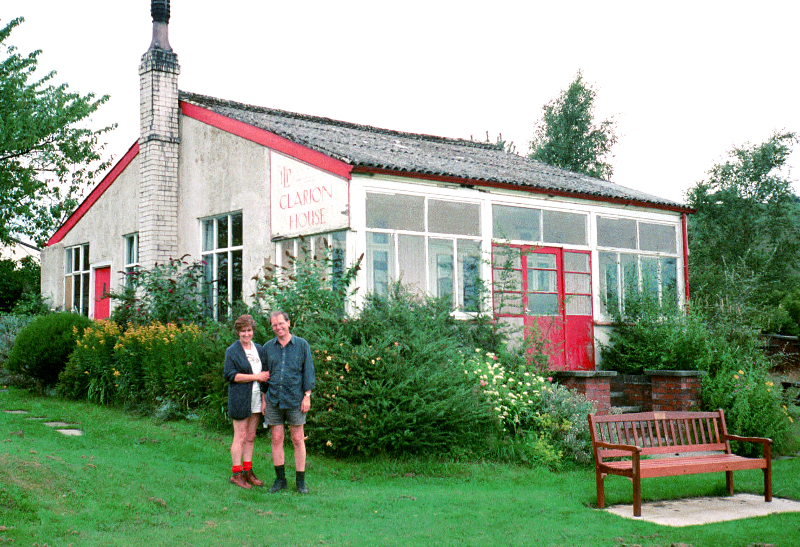
The Clarion House at Dimpenley near Nelson. Still going strong in 2013.
No. There is one left that I know of at Dimpenley near Barley which is near Nelson. And what it was it was a hut out in the countryside and the practice was - and still is there - you can still go for a walk on a Sunday afternoon, finish up at the Clarion House and have a mug of tea sat underneath a photograph of Kier Hardie. There's some toilets outside and they were built by the apprentices in 1920 or something like that, and you can tell they were and all because there isn't a brick laid straight in them. But things like that and the old I.L.P. has always struck me as in some ways a very human, very ... how can I put it? Social as opposed to Socialist orientated organisation. You know, they seemed to go in for things like what were almost Sunday Schools and things like that.
R - Yes. Well this is what I was saying, the thing is we used to go because they used to have these socials you know. You'd have game and well no dancing but there’d be games, and it would be an interesting evening. Somebody would give you a talk and you could ask questions you know and this was the thing. Although like the thing is when Byce died Mrs Byce kept it on for a while but it folded up. Well then the Labour Party came in you know, it came in in about 1920.
That’s it aye.
R- And they kind of worked in together.
Now we are talking about politics. Can you over remember hearing any reference or knowing anything yourself personally of an organisation with initials the SDF?
R- SDF?
The Social Democratic Federation.
R- No I can't ever remember there being anything like that in Rawtenstall.
No, it’d earlier if there were anything of it about. It was a man called Hyndman founded it. Actually he was a lawyer and he read a French translation of Marx’s Das Capital when he was coming on a boat across the Atlantic and he was so taken on with it that he formed his own political party. He was a very strange character actually. And the Fabians, they were the other socialist…
R - Oh the Fabians, there was a Fabian Society. (350)
Now, was there a Fabian Society in Rawtenstall?
R- Oh yes, aye there was a Fabian society. Yes now, I can't just tell you like any of the names of the people who attended but there was a Fabian society, I remember that.
Up to when John. Have you any idea?
R- Well, oh I should say it carried on until, oh the second world war.
Because they were they actually the three forerunners. They were the three foundations of the Labour movement as we know it in this country. The Social Democratic Federation, the I.L.P., the Independent Labour Party, and the Fabians. The Fabians are really the upper class end you know. The people who did more talking than action but nevertheless people who were interested in socialist principles. Now while we are on about that 1922 is the year the Communist Parties were first formed in this country. Was there ever a Communist Party in Rawtenstall?
R- I can't just remember any particular branch of the Communist Party but we have always had what today we term left wingers, extremists, but I don't just know when the Communist Party was formed. There is a party now you know, Communist Party.
1922.
R - But I mean, here, in Rawtenstall there is a fairly strong Communist Party now. Which has developed really since the end of the second world war. Because the thing was that, and even to this day the people of Rawtenstall, well Rossendale I should say, will not accept Communists in any office. Such as councillors or anything like that. I mean they, for instance there were about four put up at the last election three years ago, and I don't think between them they polled above three or four hundred votes. (15 min)(400)
At the opposite end of the spectrum nowadays to come right up to date, is there any evidence of the National Front making headway in this area?
R- Oh yes, aye. We had a branch of the National Front in Rawtenstall but just what's happened to it, it's like in very low key at the moment, but there were members of the National Front, and one or two were quite active, in as much as they wrote letters to the paper, and they had a march one time and the thing is. now who was it? There was a Communist inspired march at the same time and I know the police bad difficulty and they had to draft extra police in to keep them apart. You see the Communists you know, they jump on the band wagon to anything where they can get publicity. For instance, I mean we have had a case in this last two years of a social centre where the thing is that some of the local manufacturers found them some work, these physically handicapped - you'll have read about it in the paper - and it's been going, oh for quite a few years. Then suddenly a member of the Communist Party's husband started to go into this centre and of course then she started to stir it up, they were only getting 15p a week for doing this particular job. Well it was a therapy rather than a job but they made it out that they were employed and they had bosses and this that and the other which was far and away exaggerated. I mean because the work was entirely voluntary, if they wanted to do it. And they got £1.15 a week, you see. Well their meals cost £1 a week, they didn't do originally but you know, with the rise in cost over this inflation this last year or two it got to £1 a week and they were actually said to be working for 15p. But, with the Communist Party jumping on the wagon I mean it raised quite a furore. I mean they lobbied the County Council at Preston and then of course the local M.P. who is a left winger, he jumped on the band wagon, he asked questions here and questions there, all prompted from the Communists, because what I was interested in, this place has been open seven years, but until this Communist husband went in, there hadn't been a word said. And the MP. has been in four years and he never raised it at all you see? But this is it, in point of fact the Communists have got control of the Trades Council which is their way of working you know, they infiltrate particularly Unions and this kind of thing, and they're quite strong now.
At that sort of level John, and obviously I'm talking about present day circumstances now, of course you are a councillor, you are on the council. Just as a matter of general interest, what's your opinion of the role of party politics in local government?
R- Well my own opinion is that there should be no party politics in local government because let me say this, I'm not glorifying myself in any way at all but because I was a Socialist up to, oh I should say about 20, well more than 20 years ago. Did I ever tell you the story of why I changed?
No but I'll ask you that after. What, you just tell we about politics in local councils and then you'll tell me about that.
R- Oh but anyway the thing is here you see you are elected as a representative of the people. And I told our lot, I mean I put up under the Conservative banner. I said that if anything should come in Council which in my opinion is for the benefit of the (500)(20 min) people who elect me, if I get on I shall certainly vote for it independent of whoever moves it, whether he be Labour, Liberal or Conservative because if I do get on I hope I shall be a representative of the people and not the political party.
That's it.
R- And they agreed. They said well, the thing is that we shan't interfere with your conscience. So that's fair enough. So that's why I put up. That was the only condition I put up because I wasn't an active member of any political party.
Good. Now then, you say that you were a Socialist. When you say that you were a Socialist, were you a member of the Labour Party?
R- No, definitely not.
You weren't a member?
R- No. You see because the thing is that I've always been a church goer and so often the power seeking of politicians cuts across what I believe. And of course I have no room for it because after all, if anything the church has done for me at any rate, is to make we aware of a conscience you see. And this is why I never was actually a member of the Labour Party. But me say this, I have been a trade unionist for 50 years, I believe in trade unions, as trade unions, not as tools of party politics. You see?
That's it. Well, we shall get on to trade unions. Now, so you could be fairly described as a Christian who was a Christian and a voter with Socialist leanings. Yes? Now then, you say that you changed, now you tell me why you changed. (550)
R- Well actually I was on the local Trades Council as a representative for the Cardroom Union, of which I have been a member for donkeys years.
One interruption there, John, sorry. What's the full name of that union?
R - Oh aye, now then.
Because I know it's fairly long, isn’t it?
R- The Union of .. wait a minute .. Blow Room, Ring Room, Floor… Association of Blow Room, Ring Room and Spinning Operatives, something like that. I can't just give you the full quotation from memory. But anyway, I was on the, elected to the Trades Council you know for that union, and of course when you go to these meetings regularly you kind of make friends with the other members and there was one in particular you know that I used to chat to. We'd have a chat in the street and that kind of thing you know when we met. You know how associations are formed. And it came to be that he was a local councillor.
What was his name John?
R- Stanley Hill. He was a local councillor and of course as I say I was interested in the local Council, I always have been. And we used to chat about what went on and this kind of thing. Now, it came about that at one meeting something was passed, and it was a Labour Council you know, because I mean we had a Labour Council, we had a Liberal Council.
Was Stanley Hill a Socialist?
R- Oh yes he was a Socialist, aye. We had had a Liberal Council for oh, years and years and then it became Socialist and we actually had a Socialist Council continuously for twenty odd years. But Stanley was a Socialist, and they passed something at one meeting, and of course Stanley voted for it. And the thing was that at the next meeting they'd thought again about it, and they wanted it rescinding and of course it went against Stanley's conscience so of course he voted against it. Well, he told me that when he went home, the following day he went home to his dinner and there was a letter there (600) expelling him from the Labour Party. [The meeting was] Wednesday night and at Thursday dinner time he went home and the letter was there. This was in the days when the post was the post you see.
What year would this be about John, roughly?
R- Oh 30s, in the 1930s I just couldn't pin it down to a year. 1936, yes it would be 1936 happen. Yes, anyway it was in the 1930s. So anyway, he were telling me on principle he wouldn't vote against it because it's making it that you can’t know your own mind you know. And some little quirk of fate had intervened that made it more profitable to rescind this. I don't mean money wise profitable, but it made it more profitable to the party. (25 min)
More politic yes.
R - To rescind this, and he said it just wasn't on. And then they expelled him. So I said well, if that's the case, if there is no freedom of conscience I have no time for them. So I never supported the Labour Party again and went into limbo. I went into limbo then for, oh years and years and years. I never took any interest in politics as such. Because you know, whilst I was in the mill, our mill owner, he put up for Parliament and he actually got in, Waddington. Well, I mean I worked for him and you come into contact with him occasionally and he was always a gentleman. He used to walk through the mill and everybody, you know the grape vine went round “Waddie's in!” He was better known as Waddie, you know? Of course you knew then to be on your best behaviour. But actually he put up for Parliament (650) and he got in. He got a knighthood and he said that were what he had been working for. But that was by the way. Well at that time I was rather bitterly opposed to the capitalists then, having worked for them. I knew the conditions we worked under, and there were several things happened in the mill you know that really upset me. I can give you cases that personally affected me. Shall I give you the…
Yes, do so John. Yes do so, yes.
R- Well, let me say this now. I was working in the mill and I would be about what, 19 or 20. No, I'd be more than that, I'd be about 22 or 23. But I was working in the mill and I was running a machine what they call the willow. But there was an old man on a machine who got a wage of about £2/17/6 a week known as a scutcher. Chris he was called. Now Chris became 70 and of course he’d qualify then for the old age pension so when he became 70 the manager sent for me and he says “Greenwood”, this is how they addressed you in those days, “You'll go on to that scutcher on Monday.” You see, I had been running, like we had two but one only ran part time and of course I could run this. And mind you at this time I'd got my City and Guilds for cotton spinning you know, 1 had been going to night school and all this kind of thing. And I said what’s happening to Chris? Because it struck my conscience straight away, an old fellow, 70, were they going to sack him? “That's nothing to do with you, you'll go on to there.” So I said well if you say so, yes. “Your wage will be 2 guineas a week.” I said it's £2/17/6 on there. “Your wage will be 2 guineas a week, take it or leave it.”
What year would this be about? You were about 22. (700)(30 min)
R – 23, well, we were in 1932.
Aye.
R- So I said well I don't know if I can accept. “It's no good you going to your union because you can either take it or go on the dole.” You see? Anyway I went to the union, to the union chappie, a chappie called Potts who actually went to jail afterwards for misappropriating Union funds. And all as he said to me was well, it’s better than the dole. And it rather shook my confidence in trade unions, he never even came down to argue with them or anything. Anyway the thing is that I went on this particular job and Chris went on to this odd job scutcher. I felt sick really, having to do it.
But there you are, you have got to do, I mean your father was dead and you were one of the bread winners at home.
R- Well, this was it you see.
Aye. It was a time of high unemployment. I mean, to put it in the modern phrase ‘They had you by the short hairs, John.’
R- They had indeed. But you see, this is one of the things that got my back up. There was another occasion in the mill, and there used to be in these days a great, shall I say, what word am I searching for? But there were people who were always running round the boss. I mean there is an impolite word that I’ll not use.
Yes, which we both know. Let's call it creeping.
R- Well all right then, creeping. Now it came to be that a senior, you know, a step up came vacant, somebody died. You were always waiting for dead men's shoes you know. And of course I wasn’t a particular boss's favourite, in as much as on more than one occasion when he's been doing a job I was watching and he used to tell me “I can manage this without thee looking on.” In other words they weren't prepared to show you anything. Because as I say, I’d got my City and Guilds and I was trying to get on. But there was this particular creep and this job became vacant. So of course, as I was senior I expected to be promoted you see? But anyway he promoted this creep. So I had a to do with Sir Robert Waddington, well, Robert Waddington. I said look Mr Waddington, the thing is this post has become vacant, I am the oldest and the next in line and I haven’t been given a chance. It’s not very nice when you are trying to get on, I’ve been going to night school and I use my knowledge trying to improve my job. And all as I got was “Well, I never interfere with this, I’ll have a word with him but I never interfere with overlookers you see.” So the thing was he came back and said “Oh, you are too small, you can’t reach the machines.” At 23! But anyway the thing is I didn’t get the job and these were the things that built up a little bit of resentment.
Understandably so John.
R- Now in 1937 one chappie came to me and he said “Oh, do you want to change?” But by this time I was what they call a stripper and grinder. What happened was you see that they re-organised this mill time and time again, and this creep, the overlooker of course had dropped dead and they got a new overlooker and they re-organised this mill. And the thing is that certain people, well they opened another, they opened Ilex and so certain people were drafted away.
They opened?
R - Ilex Mill. They opened this mill, same process you see and they transferred some of the operatives from Longholme to Ilex. Well I didn't go, I stayed at Longholme, because I would have a chance then of, well I mean I was doing very well. But the thing is that it came about that the, now what happened, I was stripper and grinder anyway and this particular creep had to go on this scutcher which he didn’t want to do. It were jolly hard work because they altered the types of material and it was really, you really earned your money. And when stripping and grinding came empty then I went to them and said now look, stripping and grinding, and it's my turn. Anyway I got it, and this creep went on but it came then that going to night school as I was, one chappie came to me and he said “Do you want a change?” I said well, it just depends on what it is. He said it would be carding ultimately. Which was the thing you were aiming at. But he said “It's a new process that we are putting in. I'm not telling you anything about it but it's your line of country. It’s like early days. We want you to start at such and such.” So anyway I gave my notice in. Well then, the managing director, Stanley Rothwell, you see Sir Robert had passed on. Stanley Rothwell, it [the firm] was called James Rothwell’s. He was the descendent of the Rothwells. He sent for me to go in the office. He says “Oh Greenwood, I believe you are leaving us. I hope you know what you are going in to. It's an entirely unknown quantity.” And all this that and the other. I said yes Mr Rothwell, but it’s carding and I’ve been passed by. Because again you see, (35 min) when this chappie dropped dead, they had one man worked for the firm as an under carder who left to take a chip shop. And the chip shop in Accrington wasn't doing very well at all and in the meantime he came back to Rothwells to see if there was anything that they could find him and they couldn’t. Now when this chap dropped dead they went and brought this chappie back from the chip shop you see, passing me over again, not giving you a chance. So he said “Well, you know we have a few mills.” I said yes, but what happens when promotion comes? You'll go and pass me over, I was passed over too often in this firm. He said “Well you know, you are comparatively young.” You see, you had to be an old fellow you know to be a carder. I mean, because the thing is I had my City and Guilds by the time I was 21 which was quite an achievement although I say it. He said you are comparatively young. I said that doesn't make any difference, the thing is if you have the knowledge and the confidence. But anyway he said “Well, I’ll tell you what we'll do. We’ll give you another 5 shillings a week if you'll stop.” I said Mr Rothwell, if you can give me 5 shillings now you could have given me 5 shillings all the time I've been on this particular job. No thanks. So he turned round to the manager, he says it seems he is determined to go, let him go. So this is one of the reasons why I had no love really for what you might call the upper crust you see. But of course in these days you were afraid of your job and you had to eat humble pie you know in places where you'd have, you felt like giving them a piece of your mind.
Ah it still happens John, it still happens but for different reasons. But then you eventually came round to being a Conservative yourself.
R- Well what happened was that I was married and we were settled down and we had a nice house comparatively. Mind you, by that time I'd got mill managing you see. I had worked my way around through various means, not stopping always in one place and getting a fair bit of experience, and I was a mill manager. And we lived in a locality and one chappie came to me, he said would you like to put up for the Conservatives? I said I didn’t know. I said the thing is although I'm interested in the Council, you know I always read all the goings on in the paper and I mean although I never made a point of writing to the papers I felt like it many times, to the local paper. And he said we have had a talk and we think you'll make a good councillor. So I said I wouldn't give a decision now, I’d talk it over with my wife you see. And we had a chat about it and she said well if you feel like it, you'd like to have a do, all right I'll back you. Well I was there you see. So, anyway the occasion arose and he said “Well, there is no immediate election or anything like that. We are just trying to line up candidates.” So I said “All right, my wife's in agreement, she'll support me, and so I’ll stand.” Now, the occasion arose when there was a by-election. The Mayor elect, who was a Socialist of course, we had a Socialist Council, was up for election in as much as there used to be a by-election because they’d made him an Alderman then. You see if a chap was elevated to an Alderman he served then as an Alderman for five years without having to go to the electorate. And of course when they were elevated like this it made a vacancy for a councillor. The Mayor elect, he represented a ward in Waterfoot and of course when this by-election came the chappie, the sponsor if you want an expression for it, he came to me and he said “Now there is going to he a by-election and we're inviting you to stand in Central Ward. I said fair enough. Anyway the thing was that the Mayor elect decided he’d stand in Central Ward you see. Not in the ward he represented you see so he came and oh dear me! Of course they (900)(40 min) held the Mayor in far more esteem than they do now. And I know my wife and myself, we stopped up one morning while 2 AM writing all these addresses, and I did not get any support from the Party. Of course I mean I was raw, and I went round canvassing and a friend of mine said to me, “Well John, I would willingly have voted for you but on this occasion I think I must support the Mayor. You are putting up against the Mayor.” I said no, let’s get this straight he’s putting up against me. I was selected to stand for the Conservatives in this ward and the Mayor has come out of another ward into this ward because he thinks it’s a walk over with a new recruit. And quite honestly, he has got my hackles up.” He said “Well, I’m sorry Johnny but I shall have to support the chain.” And actually the thing is that at the night of the counting, I’ll never forget it, they started counting the votes and there was a councillor there, a Conservative who were a bit of a lad and he went up to the counting desks, he said “I'll lay two to one if anybody wants to make a bet as Greenwood's in!” Because as the boxes were coming in there was a majority. And anyway, his wife went right pale, she'd to go and sit down, and they’d to go and get her some water. Because, you know he was an established, he thought he was the establishment, he was the leader of the Labour Party and all these kind of things and the thought of being knocked out by a novice… But anyway, at the outcome when all the boxes came in off the estate that threw me out. But he only got in by 48 votes you see.
It weren't a bad show John, for a novice.
R- Well. But this was it, as I said, if the party had rallied round me and helped me I could have been in. But again, the chain had a certain influence, even among the Conservatives.
Yes, yes.
R- You see in a lot of cases they used to withdraw their candidates and give them a free run. And because he’d had to fight in the elections, you know they give speeches after the count, he who is elected. And when it came to say his few words, his first words were “This has been a dirty election.” you see and he went on with his tirade and all this that and the other so I said “Just a minute, I'd just like to say that on my part I've not done anything, or said anything in this election that could be construed as dirty. What others have said is no concern of mine but I have fought this cleanly and I object.” Oh I got quite a reception you see? Because I mean it did raise, it showed his attitude of mind because a lot said to me afterwards that he wasn’t fit to be Mayor if he can talk like that.
They should have thought about that when they were voting for him shouldn't they.
R- Well, there was a remark that's always stuck in my mind, and it was made to me by a chappie who was a Labour Councillor, but he was genuine you know what I mean? He said “John, you know the election result, Greenwood got in, Platt lost, but the chain won.” You see if he hadn’t been the mayor elect he’d have lost it.
SCG/01 September 2003
6,141 words.
LANCASHIRE TEXTILE PROJECT
TAPE 78/SB/11
THIS TAPE HAS BEEN RECORDED ON AUGUST 28TH 1979 AT 13 WHITEHEAD STREET, RAWTENSTALL. THE INFORMANT IS JOHN GREENWOOD, FORMER MANAGER AT SPRING VALE MILL. THE INTERVIEWER IS STANLEY GRAHAM.
R - Now then, this tape.
Well, in this tape what we are going to do is go through these pictures in the Spinning Folio and you tell me, you give me your description of the pictures and then of course that's going to tell us all about what they are about.
R - Well now do you want picture 5? I mean, for instance, say…
That's it, yes. [Spring Vale folio, Svbreaking section, picture 0005]
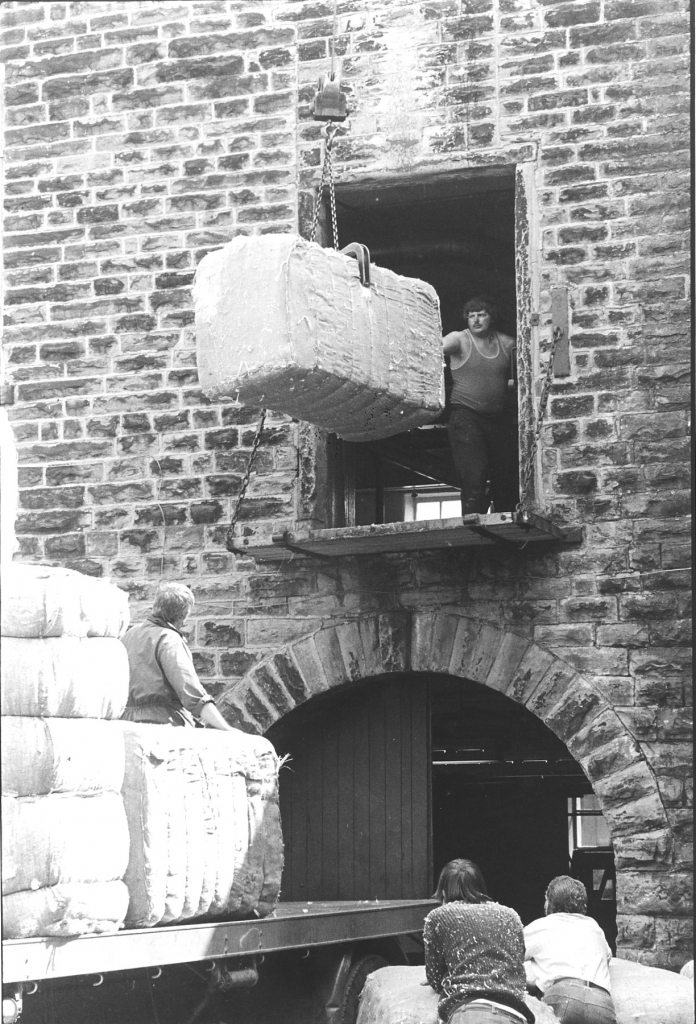
R- There you are. So well, picture 5. you see.
Yes, that's it number 5, that's it, you have got it, John.
R - Yes. Right ...
So, number 5, what's going on in number 5?
R- Well, number 5. It shows the bales being unloaded from the suppliers and they, in point of fact this particular, well these particular bales are United Kingdom bales but on the other hand we do use bales from all over the world. We get it from, we get the raw material from Brazil, Egypt, Germany, France, Belgium, Russia, United States, in point of fact anywhere where they use, where they actually spin raw cotton, we get raw material. Because the raw material that's used at this mill has already been processed, or semi-processed, once. (50) The point being that this is what is known as a condenser mill. The cotton industry can be divided into stages where you get the finest of fine yarn spun from Egyptian cotton and Sea Islands cotton which is the West Indies. And then you get the medium which are the yarns say spun from types of American cotton, African cotton, Turkish, Israel, Russian, Chinese, Indian, that’s the middle stage. And then we get down to what is known as the condenser trade which uses as its raw material the residue from a lot of the previous mentioned processing you see. And in this case the waste dealers as we call them go round and buy the residue from these mills, and then they re-bale it and then it comes in to us. So that the thing is that we are not on the lowest tier but next to the lowest tier of cotton spinning. And this particular one shows the bales coming in from the waste dealer. And they can weigh anywhere from between say 300 up to a 10001b. It depends of course on the type of material that it is. You see this particular bale I can tell is what we call a bale of thread waste which when it's pressed (100) condenses you know, very tight and the bales get very heavy whereas the smaller ones here are what we call comber waste, which is like a fluffy type of waste which will not condense to the same extent as thread waste. So that's number 5.
You knew straight away John when you saw that bale that it was a UK bale, how did you know that?
R- Oh yes. Well, the wrappings and the type of the wrappings and the number of wires and the type of bale. Now this one on the lorry here and that one are not United Kingdom bales, that looks to me as though it could be ...
The one that's laid down?
R – Yes. The one he has his arm on looks as though it could be I should say from Germany or Switzerland. Now this is a soft, continental type bale.
Yes, the one that's stood up on the flat.
R - Yes. United kingdom bales are usually more compact you see, that type of bale than the other ones that are on the lorry.
Yes, very good.
R - Now then, you see this is definitely…

Yes well, number 6 is him fetching that bale in.
R- Number 6 is fetching the same bale in. Now, the same bale is on the scales.
On number 7.
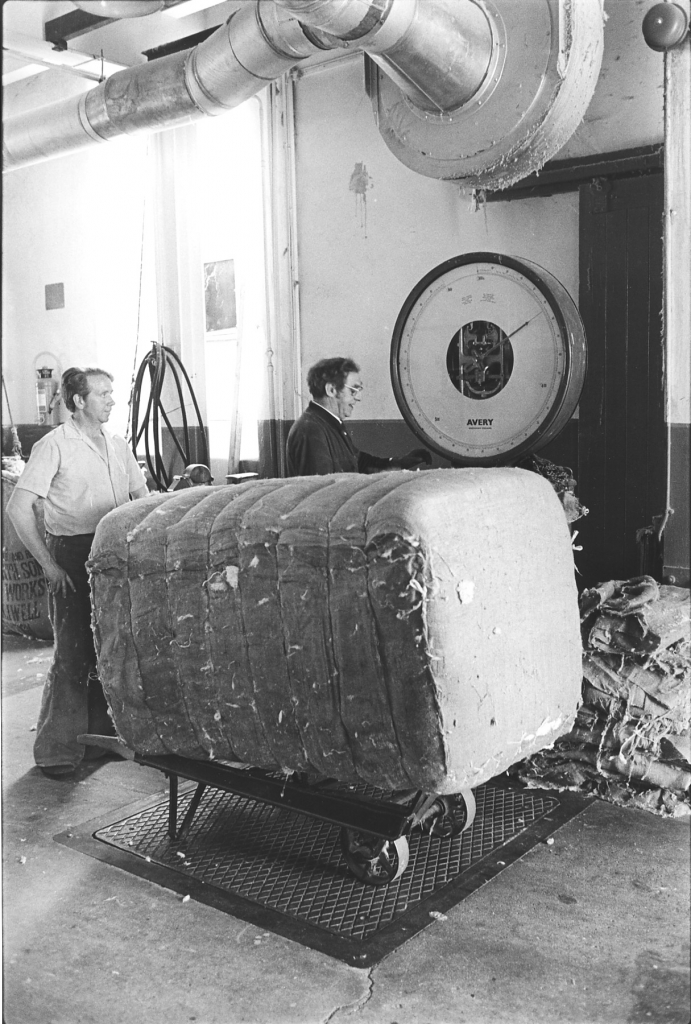
R- On number 7. It's on the scales and I can tell already that the finger, there is an adjustment on this tare bar on this particular scale and it's been adjusted because it's only registering about 801bs so it’ll probably have been adjusted to about 7 or 8001bs. You see and this shows (150)(5 min) a platform scale. They just wheel them in, there is an allowance made for the weight of the truck and then it's registered. And of course these bales have to conform to the weight as they are on the notes.
Yes.
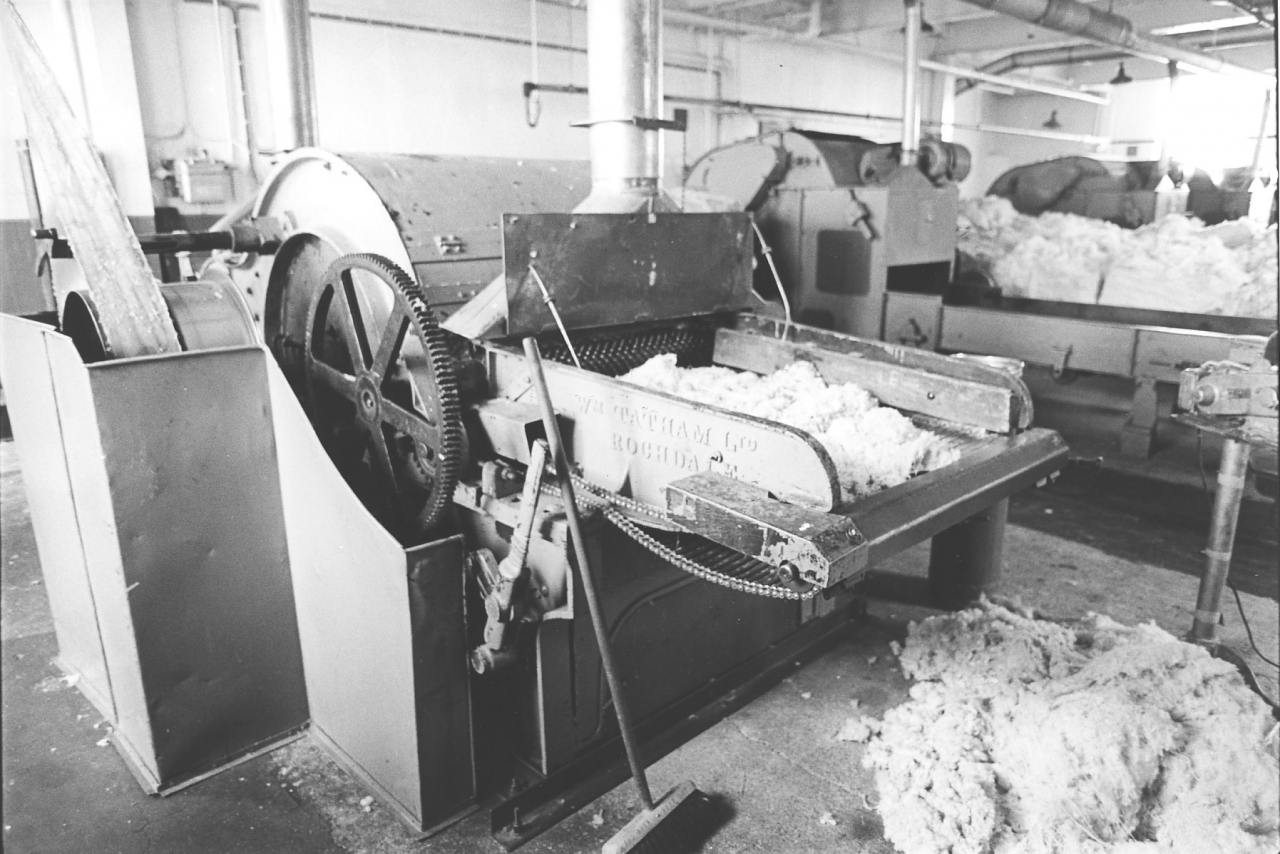
[8]
R - Now number 8. Now there are two different types of machinery here, one for dealing with what we call hard waste which is thread which requires different processing altogether to the other material which is what we call soft waste. Now, the main item is a machine where the thread waste is placed on and it consists of a wood cylinder with metal spikes on and very heavy weighted rollers. And as you can see they are segmented so that as the material's fed in this cylinder is going round very fast and it tears these threads apart. At least, it doesn’t tear them back to fibre but what it does it stops the mattedness. Or if there is part of a bobbin that's been what we call slipped off and it hasn’t been pulled out, this here machine is actually a puller. And it reduces the hard mass to a slightly more lofty mass.
A slightly more what mass? Lofty?
R- Yes, it's more lofted when it comes out at the front.
Lofted?
R - Lofted aye.
That's it aye, I understand that.
R- Lofted.
And that's what they call the Jumbo don't they?
R- They call, actually it's proper name is a running down machine.
Yes right, that's what we want yes.
R- See its proper name in the trade is a running down machine but it commonly gets its name as ‘the jumbo’ And you can see it's a very solidly constructed machine. (200)
Yes and a very heavy drive belt and all hasn't it?
R – Yes. Oh it’s a woven belt and of course it's very solidly constructed. Because after all, if you can imagine the width of that it's 32 inches wide; now if you got a rope of the same dimension of the amount of material that is actually on that feeder, you see it would be anywhere up to about 8 to 10 inches and that machine's got to tear that you see. And that's what it does, you see it has handles on for reverse, not for reversing, for stopping instantly, instantaneous stop because if a little bit of metal or anything like that goes in of course it can cause a spark and you have a fire. But as the material's delivered at the front it does actually pass over magnets so if there is any steel it will hold it but of course it won't hold non-ferrous metal.
That's it, yes.
R - You know, like brass, something like that would go through.
One thing John, when that hard waste has gone through that machine, where does it go to then?
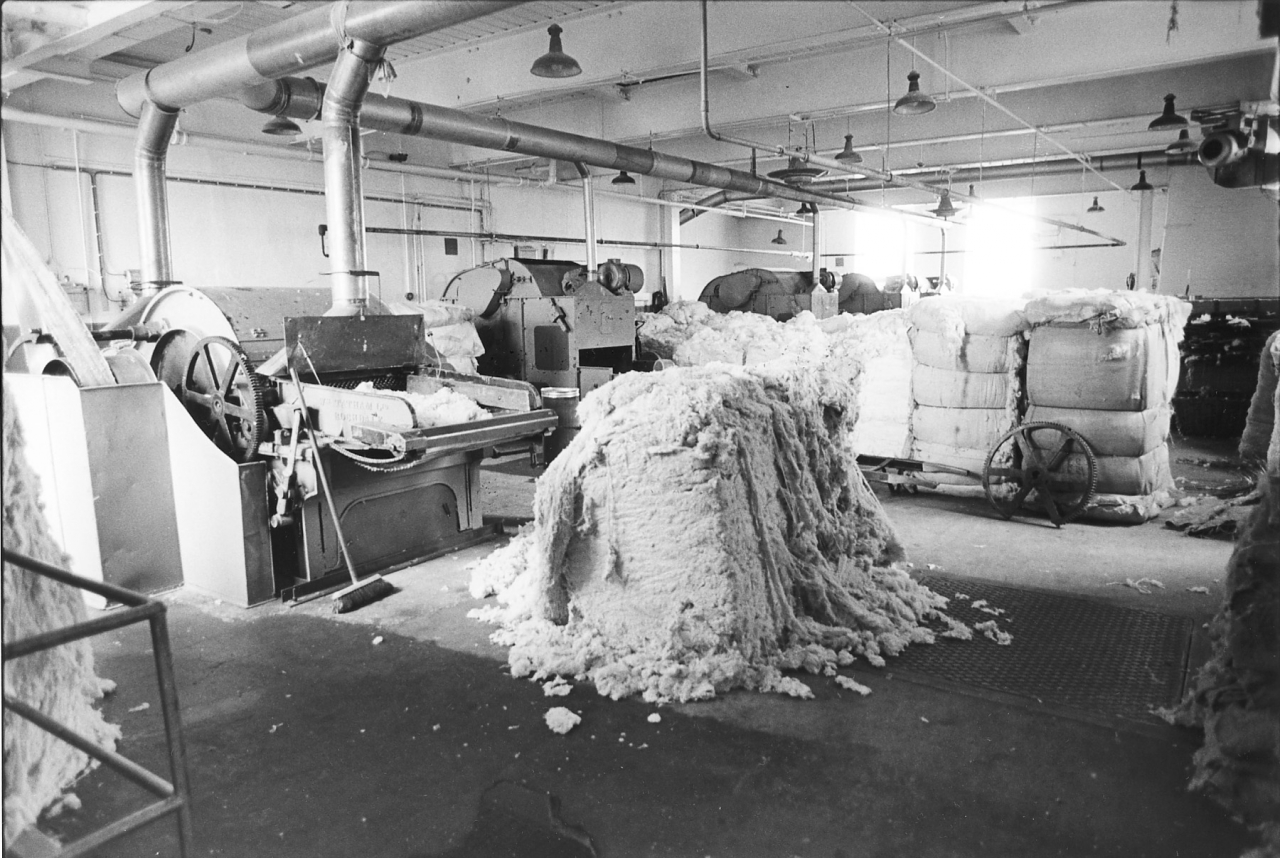
[9]
R- Well, if you look at number 9 in the left-hand corner you'll see a little, what we call a stack. You know the word, a pile of raw material. And it's edging on a guard. Now actually inside that guard is a hole in the floor which when the people underneath are ready, that material is put down that hole for the further processing you see. I meant these guard rails protect anybody from falling down.
Yes.
R - Now, shall we go on about these machines, or shall we take them as a separate item ?
Well, I think if you go on to number 10, I think you'll find it's a picture of the blending machines, John.
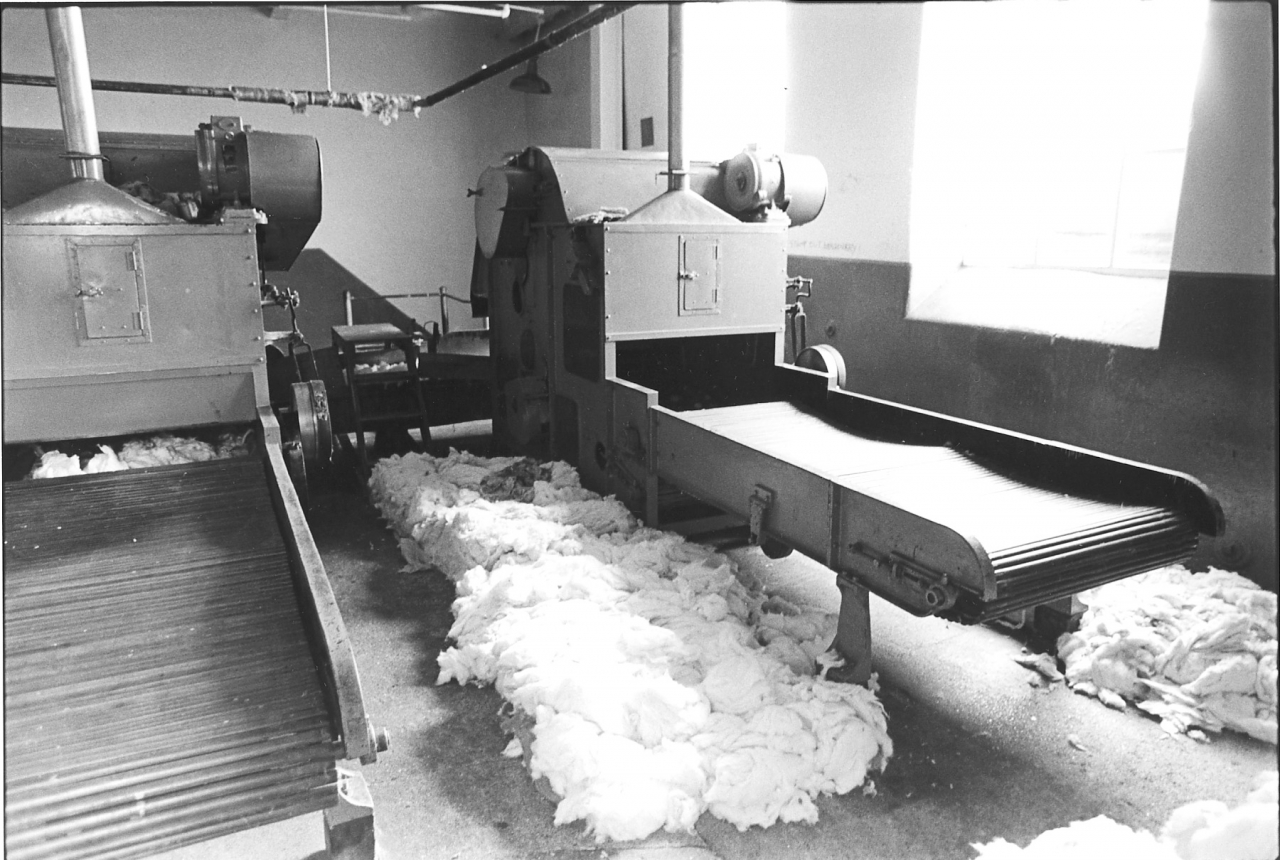
R- Oh, well then number 9 is just a general view of the whole room. Now, number 10 are the blending machines. Now, it’s the job of the, well it should be the manager who selects the bales because in cotton particularly you get different colours, and you get different lengths of what we call staple which is the hair length. And of course you’ve got to make a selection, because the longer the hair length and the better it is to spin. But at the same time, when you are spinning to design, that means to say that the type of end product begins here and the blend of materials is such that it'll give you the characteristics in your finished product that you want. For instance, in condenser the yarn spun is mainly used for what we call weft which is the filling in any cloth. And in this particular case where they make raising cloths, that's flannelette sheets, yellow polishers, where you want a nap, you have got to put in a certain amount of short fibre so that in your yarn the ends protrude and then when they are brushed they'll stand up further and it gives you a nap. You see the blending starts here. The bales are selected and then they are brought down, so many to each machine, and the operative takes a selection, or should do, of every bale. He doesn't just use one bale. I mean, down here you have thirty odd bales which are all in process at one time, so that you get a full cross section and a perfect blending so that when the material is delivered, and the action of machine is just simply a tearing action, the material is fed on the lattices that you can see. And inside the machine there are further spiked lattices with spikes rotating against one another. For instance the lattice is going up then the top lattice (300)
will be coming in reverse to the spikes going up so that as the cotton passes in between, it’s torn apart. And all that it does to take the mass and break it into small tufts. And of course you see, each machine is so sequenced that the percentage of any one can be regulated. You see they all fall on to this creeper lattice, all the material falls on to the creeper lattice so that the number 4 machine puts its material on. Now as it’s passing along it passes in front of number 3 whose material falls on top of number 4, number 2 whose material falls on 3 and 4 and number 1 who falls on 2, 3 and 4, so that you get again a cross…
It's a mix again, yes.
R- … a cross section and blending. Actually it’s a blending plant you see? Well those are them.

[1201]
R- Now, number 1201 [in the Svdevils section.]. Now. these are the breaking up machines to give them their proper name, better known in the trade as the devils because believe you me they are at times. You see the thing is now you’ve got the material that's been through the jumbo comes down the chutes and then it's fed on to the lattices as we can see. But these machines, the cylinders are all covered with, again, short spikes and they’re what, the diameter is 39” and you have 37 lags on each cylinder and the number of teeth vary in density, the further down the line you get, the finer the teeth. More of them because you see your material is being slowly opened as it's going down. So that the thing is that the (350) coarser teeth are at the first cylinder and the finer teeth at the back; until it comes out at the front. If it's properly broken up the material then will not contain any thread at all, it'll all be fibre.
There is something I noticed about one of those machines when they had it open the other day John. The lags on the front cylinders and I think the third one back, seemed to be set on a steel plate whereas all the others were on wood. Is that just a different type of lag, or is it ...
R- No. The thing is they should all be on a steel plate. That steel plate prevents burning in case of fire you see?
Aye, yes, yes.
R- Because actually these machines, you know a match will strike a fire, and the velocity. After all the cylinders are going 900 rpm. The velocity is such that although the machine might be stopped a spark will travel the whole length of that machine and should it be running you can’t catch it if you ran, before it's at the other end, a fire all down the line.
Yes, they did have them on fire one day. I didn’t see them but I think we’ll get on to that. Of course that’s the reason why the fire buckets are on the floor, isn't it? (15 min) (400)
R- Oh there's fire buckets and there is hoses on every pillar. For instance, you can only see one there but actually there is another down here and this right-hand wall side, looking down the length of the room there's, there are about six and then there’s a hose reel at the feed end. And then there is a hose reel, I think that's it there.
Yes, the far right-hand corner of the room. Now, the insurance on those machines must be terribly expensive, you know.
R- Oh it is yes. And of course the thing is you see that with experience comes the knack of dealing with fires. Because, I mean, the thing is that when it strikes up, you see your smoke will come out of your third cylinder. No, the second set of cages. For instance, as these teeth go round the material is broken off and then it's thrown on to cages, revolving cages that condense it and let the air escape you see. And then it slowly goes forward until it's a mass, ready for the next cylinder. Well the thing is if you have a fire in the first set of cages your smoke will come out of your second you see?
I see, yes.
R- And of course you have got to be smartish. The thing is to stop the machine straight away and get to the source of the fire. And so often for instance, if you open the access you know it'll woosh!, flare up.
Flare up.
R- And then again, this is one reason why, when I was managing I insisted that the floor was kept very clean because it will travel, it will travel on the machines of course, it will travel across the machines if there's fluff anywhere about.
Yes, I have heard the old tacklers on about that John when they had gas lighting in the sheds and they went to light them at night. They said many a time the flare used to travel down the dust on the beams, you know. It'd just catch and it’d just go woosh, from one end of the shed to the other as fast as you could follow.
R- Oh yes. Well this is why if you were careless lighting them and you broke a mantle you know?
Yes. Of course it's almost explosive isn't it, finely divided cotton.
R- Oh it is, aye. Well I mean, let’s face it, cotton is of itself 92% cellulose, which is a very highly flammable substance.
Yes, that’s it. Aye of course it is.
R- You see? And I mean, wait a minute, I got that wrong. It’s 89% cellulose, 8% moisture, and the remainder is natural waxes and what have you. So does that cover that one?
Aye. I should think that's fairly comprehensive Mr Greenwood.
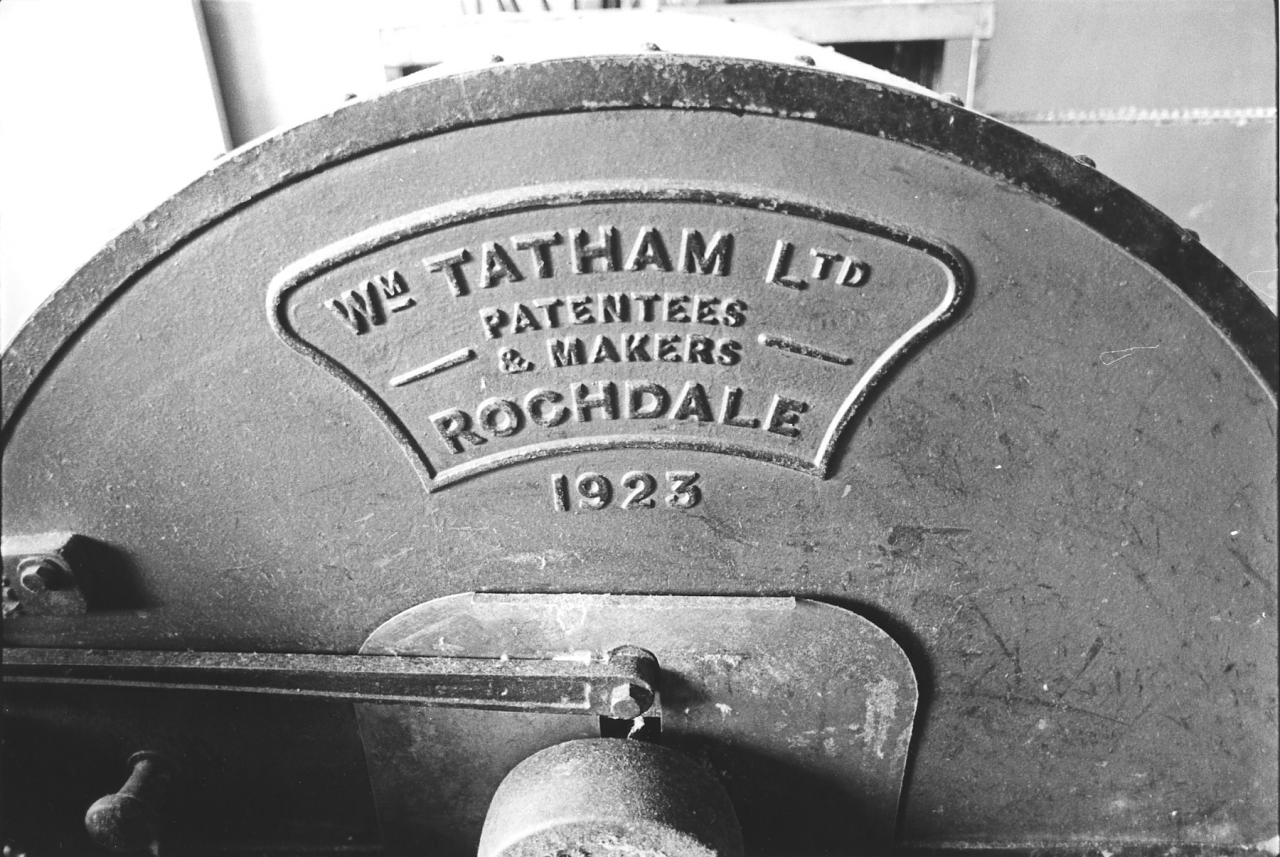
R- Right. [No 0038] Well now then you see that's just a close up of one of the cylinder covers ...
Number 0038. Yes, that's number. (450)
R- ... showing the date of the machine 1923 to 1979 and still going strong.
I noticed that, I noticed that a lot of the machinery in the mill seems to have been replaced round about 1900 to 1910 and yet the devils seemed to be a bit later. Is that because devils wear out and do they wear out any quicker than any other machine?
R - Well let's say, let me say this straight away. That the machinery in this mill has been bought from various places, at various times. For instance the plant that you saw, if you had been there 20 years ago the shed part where the cards are was full of looms, you see.
Aye, I thought it were like a weaving shed, yes.
R- And the card room was on the first floor where you saw the mules you see.
Aye, yes.
R- And what’s happened in this particular mill, the machinery has been nearly all second hand you see. And the devils you know, they do wear out of course, they are being replaced by some from somewhere else but I don't think they have had any new machinery except the press. And that was second hand, but it was brand new and it had never been erected and the firm that bought it didn't want it so it came to us in its crates but it was second hand. But there is a peculiar, well not a peculiar tale, I shouldn't say that. There is a tale going you know that in the about 1880's, happen later than that, round about 1900 happen, I can't give you the exact date, but this particular mill used to be known as Devil Dick.
Aye? (450)(20 min)
R- Devil Dick’s. Now Dick was a Hardman, wait a minute, was he a Hardman? Well he would be yes. He would be a Hardman and it were known as Devil Dick’s. Now then he was the owner and the story goes that one, and I mean in those days you know they used to be working owners, that he went in early one morning and they used to start at 6 o’clock mind you but he had gone in because they were short of cotton, short of material. And he set the devils on. He nearly burnt the factory down because there was nobody there and he had a fire. You see, in my time, in my time these mills used to run solely on devilled cotton, they never used to buy comber. And I can remember comber being instituted in the mill where I worked, and it was oh, shall I say a pence a pound in those days cheaper than thread waste. And then slowly as the mules in the higher classes of spinning went out, there wasn't the same thread waste made so they looked round and they started using these combers. And what, and so now, I shall say these last, oh what, 40 years, comber had been the staple type of raw material. And thread waste is the poor relation. But L. Whitakers were very wise, everybody threw the devils out you see, they wouldn’t. Well in the main they couldn’t get fellows to run them, what they called a skilled deviller you see, a chap who was used, I mean he had to have his wits about him and some acumen because if there was a fire you know, he’s got to know what he was doing. And a lot of people threw their devils out and of course they’ve rued it ever since because thread waste is now the cheapest of raw materials because nobody uses it much.
That’s it aye.
R- You were going to say?
Yes, I was going to say. I don’t know what I was going to say John so we’ll go on to picture 13.
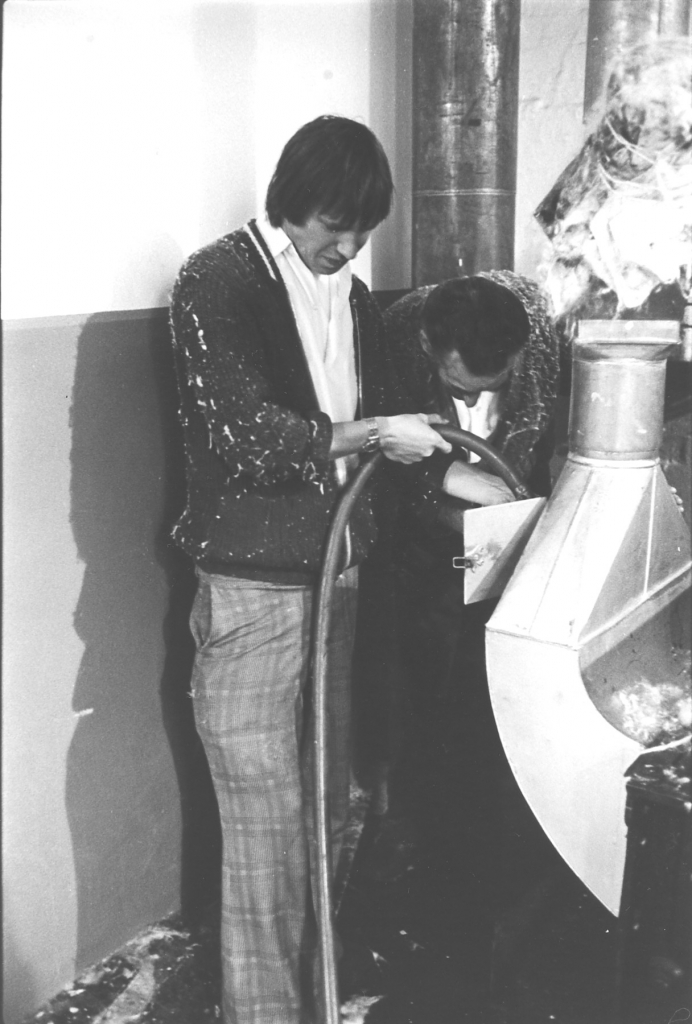
R- Well, picture 0039 just shows the chappie using a hose-pipe on the fire.
They have got a fire in the trunking. Now that was in the small machine down at the side, that only has one cylinder on it John. What's that used for? (550)
R- Well, as I had mentioned in the intermediate process as above, condenser spinning, when they are drawing the thread out you know. I mean first of all it's carded into a rope, and it's got to be gradually dwindled down till it's ready for spinning. Well to make it carry in these intermediate processes they have to put twist in which it means turning it on its axis to bind the fibres together to carry it forward. Well, it's these processes before the yarn has received its final twist you see where it's soft but it still has twist in, and it doesn't want very much opening, so they just use this one cylinder and it reduces it back to fibre. It's known as a roving waste opener.
Roving waste opener, yes that’s it.
R- You see, you only need a match or a nail or something like that.
The fire actually that day was in the trunking of that machine.
R – Yes well it would be, because there is only one cylinder on it
That's it aye
R- You see, it's straight, there's no cages, there is no cages you see.
Straight into the trunking, yes.
R - Aye, yes.
And when that waste comes off those devils, that’s blown upstairs into the blending room, isn’t it?
R - That blown upstairs into the blending roomy into two bins. And the thing is from there of course it's baled up and it has then to stand for three days or should do. The point being that when the material has gone through these cylinders it actually takes all the moisture out. You see the natural content of cotton, moisture content is 8% or 8 ½% and the thing is that when it comes out of these machines, and I’ve tested it myself, it's what we call bone dry. In other words, if there is ½% of moisture in it it's as much. So that the thing is to get it to spin and make it pliable again it has to pick up its natural moisture because if you noticed that on those blending machines in particular, and you haven't got a picture of the stacking bins, you'd have seen that there were jets over the tops and these jets spray on a solution of oil and water, on to this devilled cotton as it came down. (25 min)
Aye.
R - And then of course it’s baled up, and then they get, it gets further oil as it goes through on the …
Scutcher?
R -Lattice.
Yes.
R- No, on the lattice to the baler and then it should, for good results, stand about three days while the water has permeated the whole of the cotton. Because the idea of putting oil on is just to stop the water evaporating again, you see, the water is a carrier for the oil, which holds the water when it gets on. (600)
Yes.
R- So now then.
Picture 0040.
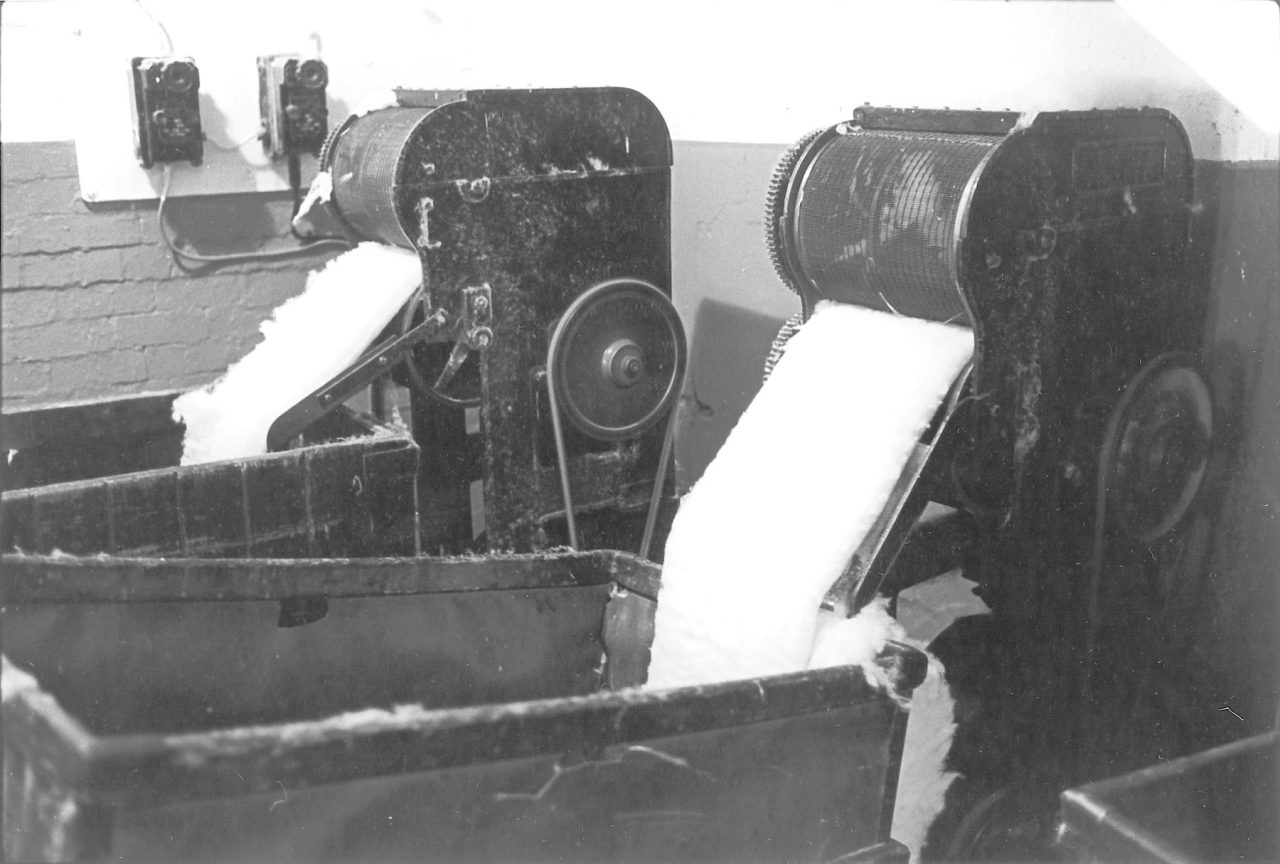
R- Number 0040. Well now this is really a little bit out of place in this particular order in as much as… When the cotton goes on a finisher card, what we call a finisher card which will be explained later, the selvedges are taken away because it would be an uneven yarn. And these machines are extracting those selvedges from the card room which is ...
That’s it, there is a little thing sucking it off at either side isn't it?

R- Yes that's right yes, aye. Picture 0041. Now this is the baling press and the thing is that the baling press is used for two things. As I have said before, as far as devilled cotton’s concerned. For maturity, to press the cotton together, and in the other case the comber waste is baled up to prevent having loose stock lying about all over the place. And again, when we had three to four spinning mills it was pressed into bales for transporting to the other mills so that every mill was using the same type of material. Because it used to be when each mill did its own blending, like I've mentioned before, you get cotton which might be white, it might be cream you know and it might be somewhere in between. And at one time, going back a good many years, when each mill did its own blending you couldn’t take the yarn from Spring Vale and put it with the yarn from Holmesfield because Holmesfield might be using more white cotton than you are and you used to get a lot of what they call bars or stripes in them in the cloth you see. And the point is that when we put this in, when would it be 1953 or 4 probably or thereabouts but anyway the thing is all the blending was done at Springvale and the incidence of striped cloth fell by 80% because striped cloth of course was reject. And the incidence fell by 80% it paid for itself did that machine in the first 12 months.
That's the way isn't it. (650)
R- Yes. And what happens in it of course, the material comes off, you see you have got the pressing end instead of a full view of all the press. But the material is collected you see on the apron that we saw from the blending room and it drops into what we call the trampler side of the press which gathers it in and presses it and gathers it and presses it gently until it's got a specific amount in and then it stops. Now when that machine stops automatically it stops all the blending machines upstairs, it stops the feed lattice, and it also cuts off the oil sprays you see?
Aye. I see, I didn’t know.
R- And then of course you see this is what they call a swivel press. It's on a central pillar and then it’s swung round one half, you see, under the pressing side, and then he presses it while the other side is filling up.
That’s it yes.
R- You see the other side is filling up while he is pressing and wiring that.
That's it. Well I have never seen that done and I couldn't weigh up what was going on there, because I could see that the actual hydraulic press was only at one side and now, obviously now I know because that's what you are here for Mr Greenwood, is to enlighten us.
R- Well, the thing is there, there's a ram in there.
Yes.
R- But the old one, it only had a single screw, where this had a twin screw. The pressure is about 5tons for a square inch.
Good.
R- Now then. This machine is called a scutcher.
This is picture number [Svcarding] 1601, yes.
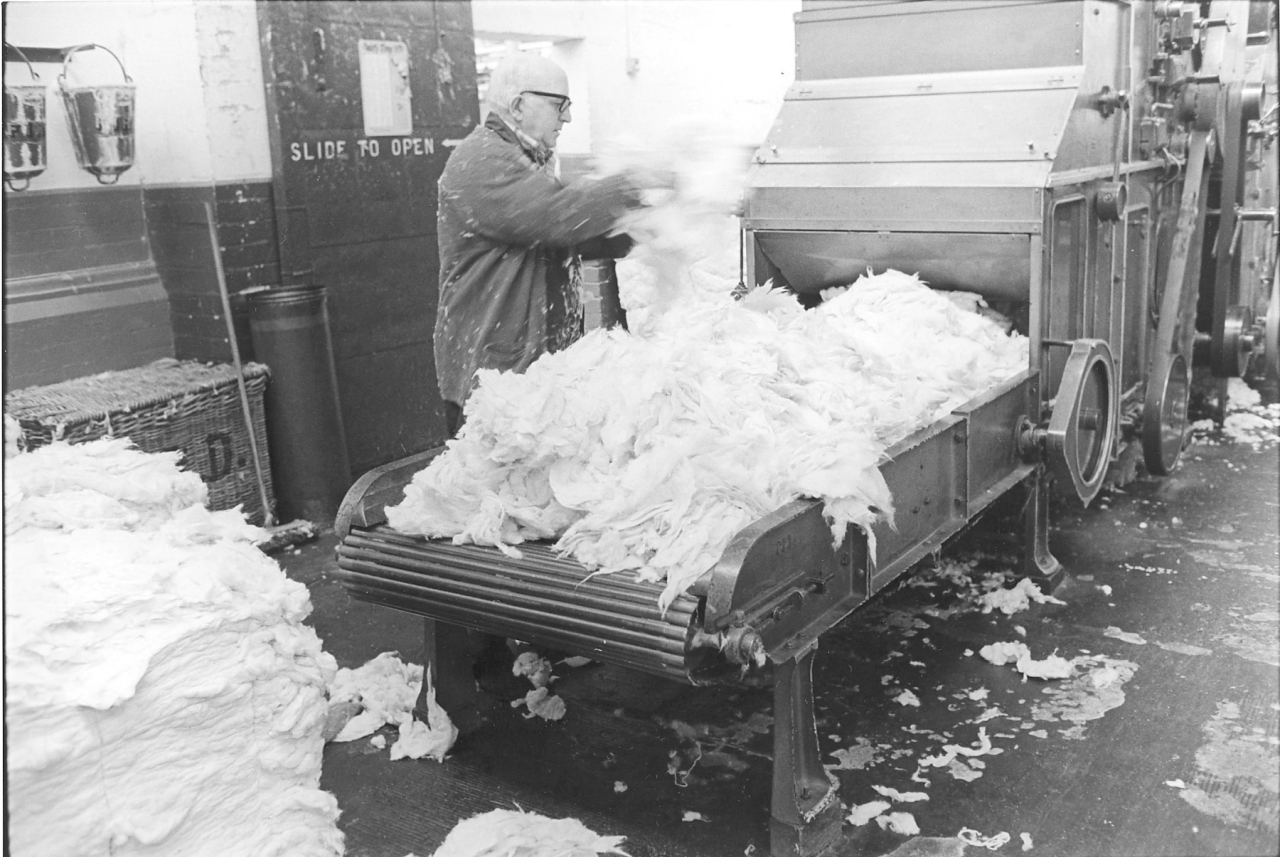
R- Yes. Picture number 1601 is a scutcher, the machine was invented by a chappie called Snodgrass in Glasgow, in - what's the matter?
Oh you are great John, go on. No it's that, John I’m most impressed with the quantity of information, I mean this, it's just, I am sorry but go on I am sorry I have interrupted you.
R- I should have said that the finishing end was invented by Snodgrass in Glasgow in about 1820 but the other parts are known as hoppers, and the whole object of these hoppers again is blending. And the whole object of the machine is to take the blended stock out of the bales, blend it again, and the spikes on the lattices in these hoppers, which is the same as the blending machines except that they are finer you see, so it breaks these lumps that you might have into smaller tufts. And then of course when you have got them right lofty, as is a good Lancashire process, you squeeze them together again. You see the thing is that what happens is that as this machine is going along it's feeding the stock. Now this is the blending hopper, and that's the hopper feeder in there. If we had a front view, if you had taken one you know, in between there is a vibrating plate that is gradually pressing the cotton on to a front plate which means that as the cotton is just simply dropping in by the action of the lattices, every hole is filled up. And so, as it is delivered you get an even sheet of cotton.
Yes.
R- You see? Now as it goes along of course the cotton then passes under a roller. There's a top roller, but the bottom one consists of a lot of rollers about 2 to 2 ½ inches wide, what we call pedals, and the roller sits in the lip or nose of the pedal. So that if you get a lump in one place, that pedal will depress you see. Now if it’s very thin all the pedals will come up and at the back side where, but you can't see, there are a lot of levers that are all intermingled and if as one pedal is lifted up another might be depressed, and so on until the action of the pedals ultimately is conveyed through a lever to a strap fork on a cone, a pair of cone drums, one’s convolute and the other is involute. Aye one's concave and the other's ...
Convex.
R - Convex. But these cone drums are machined to very, very fine limits in their arc so that as a strap moves, even if it's only l/8 of an inch there's a change of speed on to the intake roller.
Aye.
R- And these straps, I mean these cone drums, are what, 15 inches in length and whereas one is narrow at the bottom the other one's broad at the bottom. And they, as I say they are so graduated that as this strap floats up and down on the surface of these cone drums so the speed of the intake is altered so that you get a regular feed. And, there's quite a story about one of these machines, not this one in particular, but the other.
Yes? (750)
R- That in 1970. No, about 1968, whereas we had two machines we thought right, we'll get a brand new one you see. And this would be fully automatic you see. So they went to a German firm called Herketh to see what they could offer. And they said yes, we can find you a new machine you know. Oh yes, I mean, those old things. So they said “Well what we’d like you to do is to send us some of your stock which we will process on our machine and we should also like you to send some of the laps.” You see, the thing is that when this machine, when this cotton's gone through the feed rollers, it's combed out by a beater and then it’s condensed on to cages. As I said, being Lancashire way we have opened it up to squeeze it together. It goes through the rollers, the delivery rollers, four of them you know so it's three nips, and the pressure on there is about 5tons, on the whole of those, then it's rolled on to what we call a shell, and it's rolled up into a roll like a toilet roll, and we call those laps. (35 min) So we had to send some laps to Herketh and after a long time, and when I say a long time I’m talking in terms of six to nine mouths, we finally got a report. We are very sorry to say having processed your material on our machinery we would not be able to give you any better results than your present machinery. And the machine that that was done on was made in the year 1900.
Aye.
R- Yes.
So there had been no advance.
R- There had been no advance in the technology to improve, shall I say the regularity, and this was what we were aiming at in that time and we never got a new machine. And it isn't this one, it's the other one at the other side.
Yes that’s it, there are two machines in there aye.
R- Which was made by Platt Brothers in 1900.
Aye, aye.
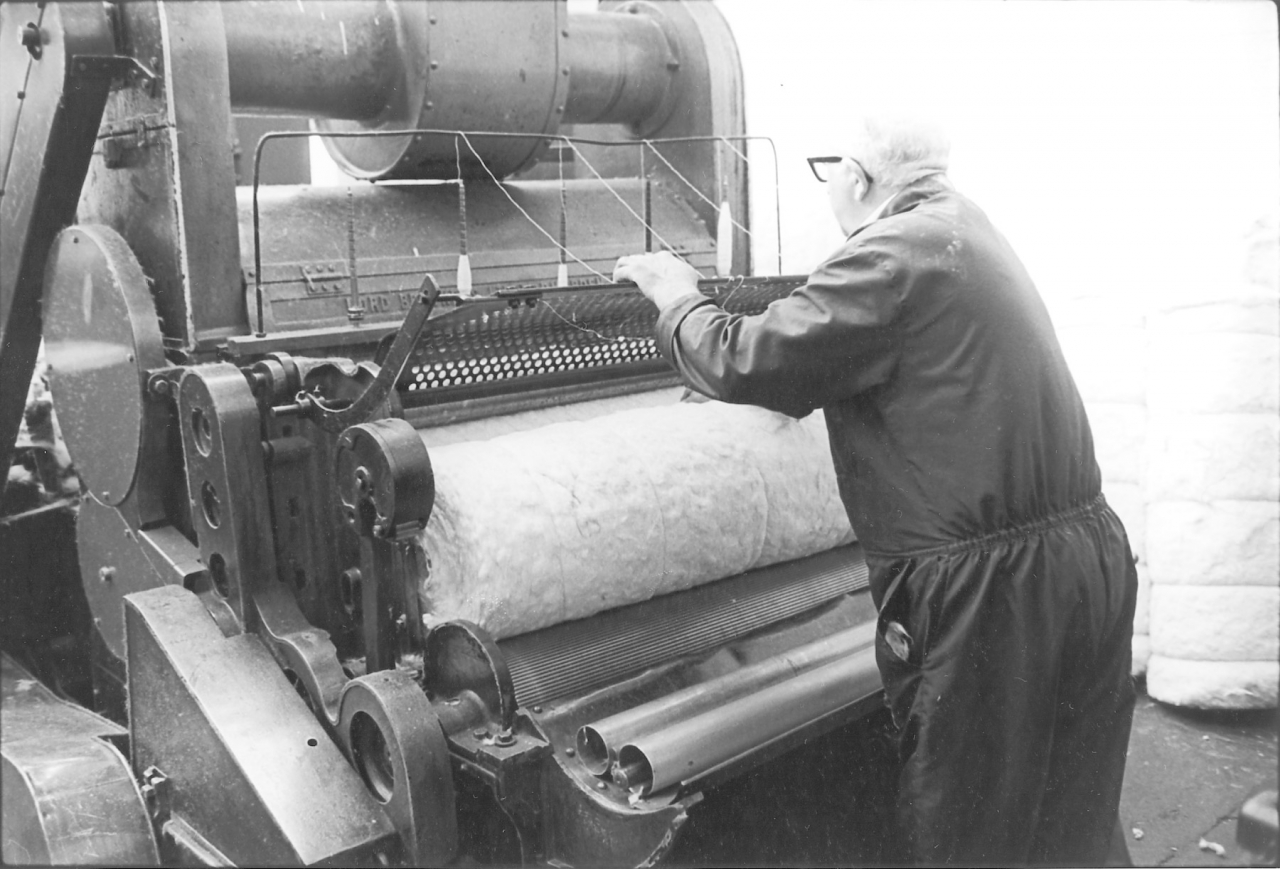
R- Well that’s number 0014. Showing George as he is called.
George Pickup, yes.
R- George Pickup, yes, a grand chap, just taking a lap out of the machine. Now the picture of these laps, every one has to be within a pound of a norm, either above or below, definitely no more. Actually in some cases it's half a pound, but no more, if it's more than that it has to be rejected.
And the reason for that John? Do we come on to that?
R- Well it, you see this is the first stage, or I should say the second stage of what you might say is a colour, quality control.
Yes.
R- The first stage of course of quality control, is the selection of raw materials. Now this, you are getting down to the fine limits you see because after all you've, one of these weighs 421bs so that half a pound is something slightly over 1% of irregularity you see. (800)
Yes.
R- So that's it. Now then.
Ah that's it, he was just weighing one weren't he.
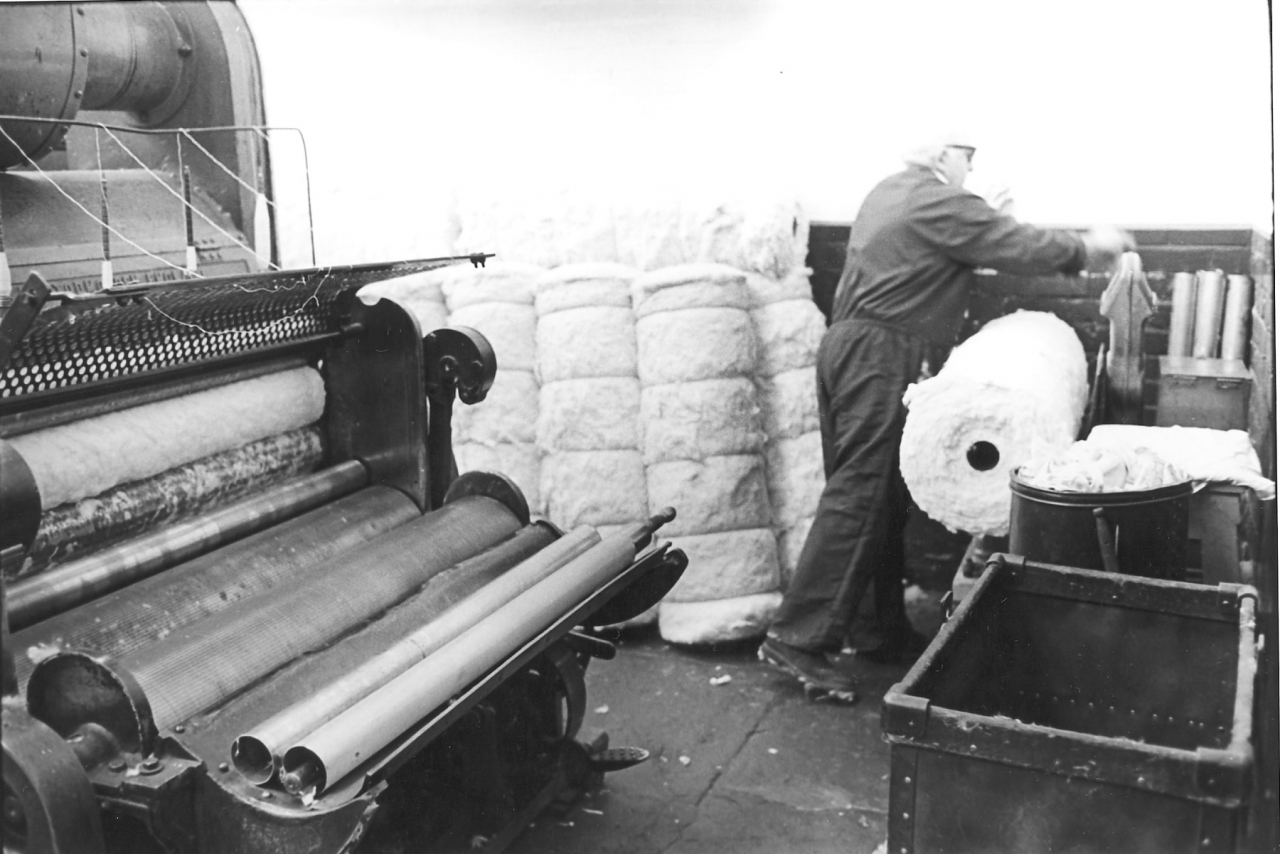
R – Oh, 0015 shows him weighing one, and of course the thing is the weights are actually locked in that box that you can see at the back of the scale so that they can't be tampered with. He has odd weights, you know, half a pound, but there is a scale on there on the dial you see. It’s up to a pound and a half either way but the thing is why he has the odd weights because if you are changing materials for instance, the thing is that you might want to know if a lap is very heavy, how much too heavy it is. Because as I was mentioning, the cone drums that are feeding the stock in, there’s a regulating screw on there and the thing is that you can manually alter the position of the stop on the cone drums. For instance if the lap’s light it wants to be fed quicker, so you can manually alter this position of the strap on the cone drums so that it will feed quicker. So this is why he has spare weight just to be able to adjust his strap on his cone drums.
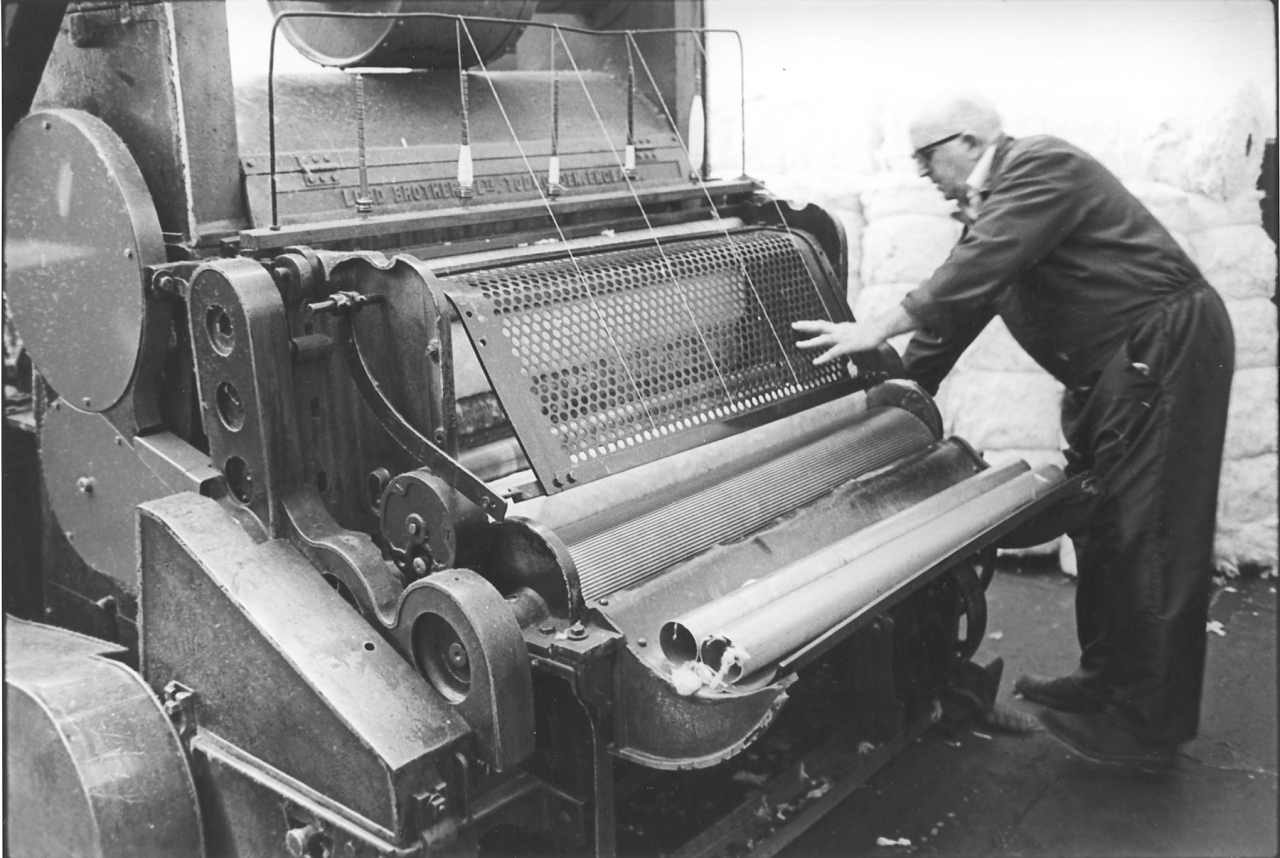
[17]
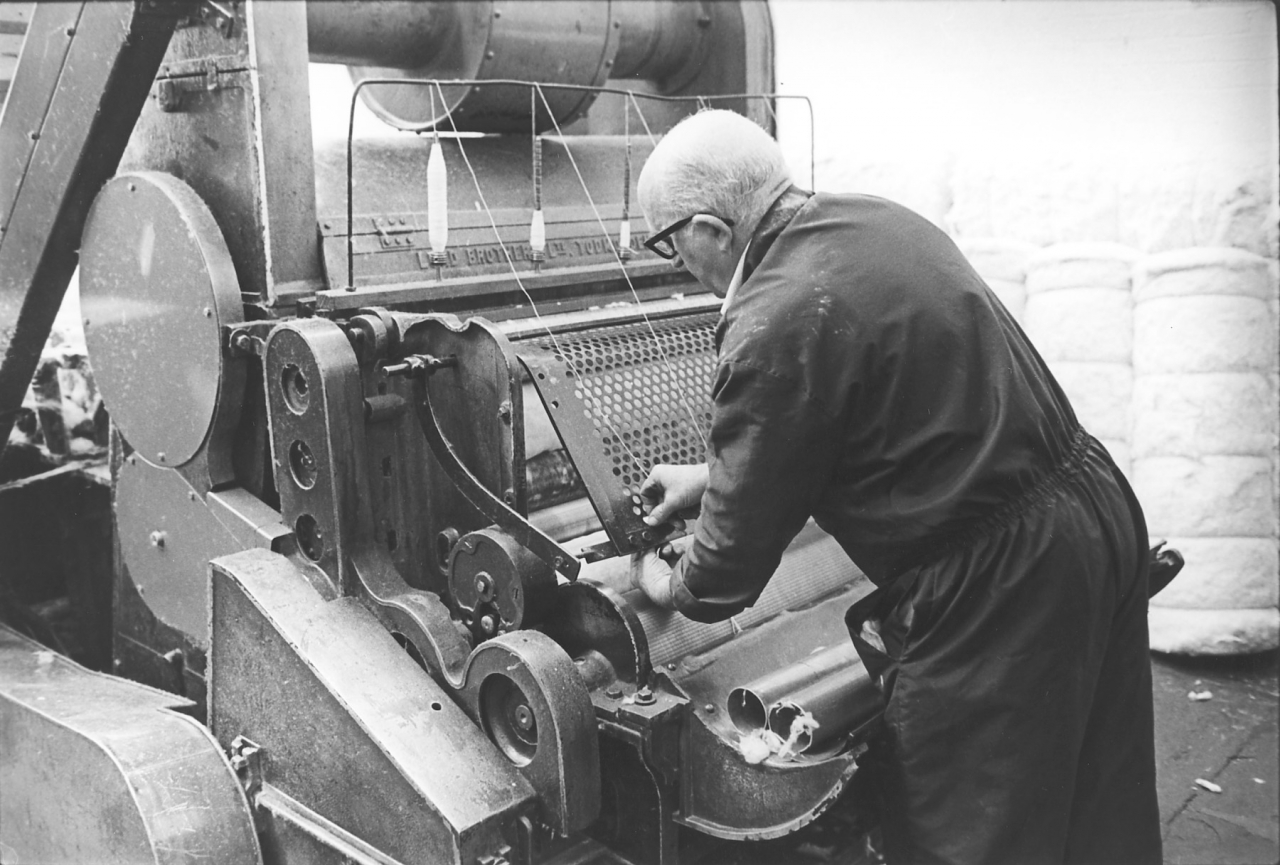
[19]
And 19 is, shows him inserting the lap roller or as the, in some places they call them mandrels, we call them mandrels. The mandrels are covered with that sleeve and then he puts it in and then of course he can withdraw the mandrel easily [when the lap is full]. Now then, number 0017 again shows the mandrel in position, the machine has been started up and he is replacing the guard. Now the thing about this raw material, this stock, as I had mentioned before it's covered in oil, at least there's oil sprayed on it. So then, the point is that these layers would tend to stick to each other. And to prevent that when they are unwinding we place in a series of threads, these are very soft so that they are lost in the next process but we feed them in so that the sheet will unwind without sticking to itself.
Aye that's it, yes.
R- And so the next pictures, he is taking a spindle out and he’s going to put a new one on.
That’s it.
(850)(40 min)
I have an idea 0019 is the same John. Ah yes, he is threading it through, yes.
R- Oh yes. It shows him threading it through, yea he has to thread it through.
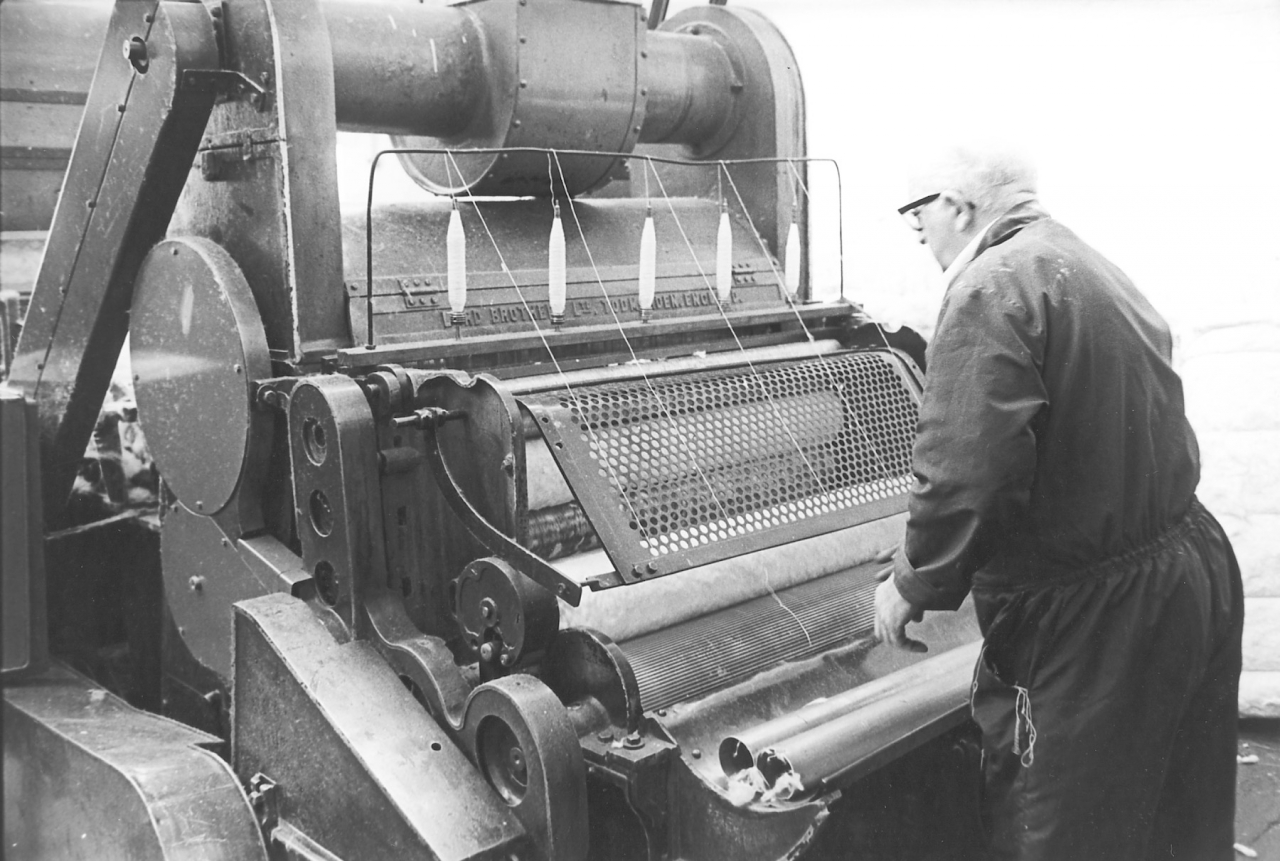
[20]
Yes, through the guard, and 0020 he has got them all replaced. Tell me John, those pirns that he uses there, are they say nicked cops from upstairs or something like that?
R- Yes, reject yarn, yes.
Yes, that’s it. Yes.
R- It’s a way of using them up you see.
Yes, that's it, aye. Of course it all gets combed again and goes back, recycled into the process.
R- That’s true.
Yes. Aye.
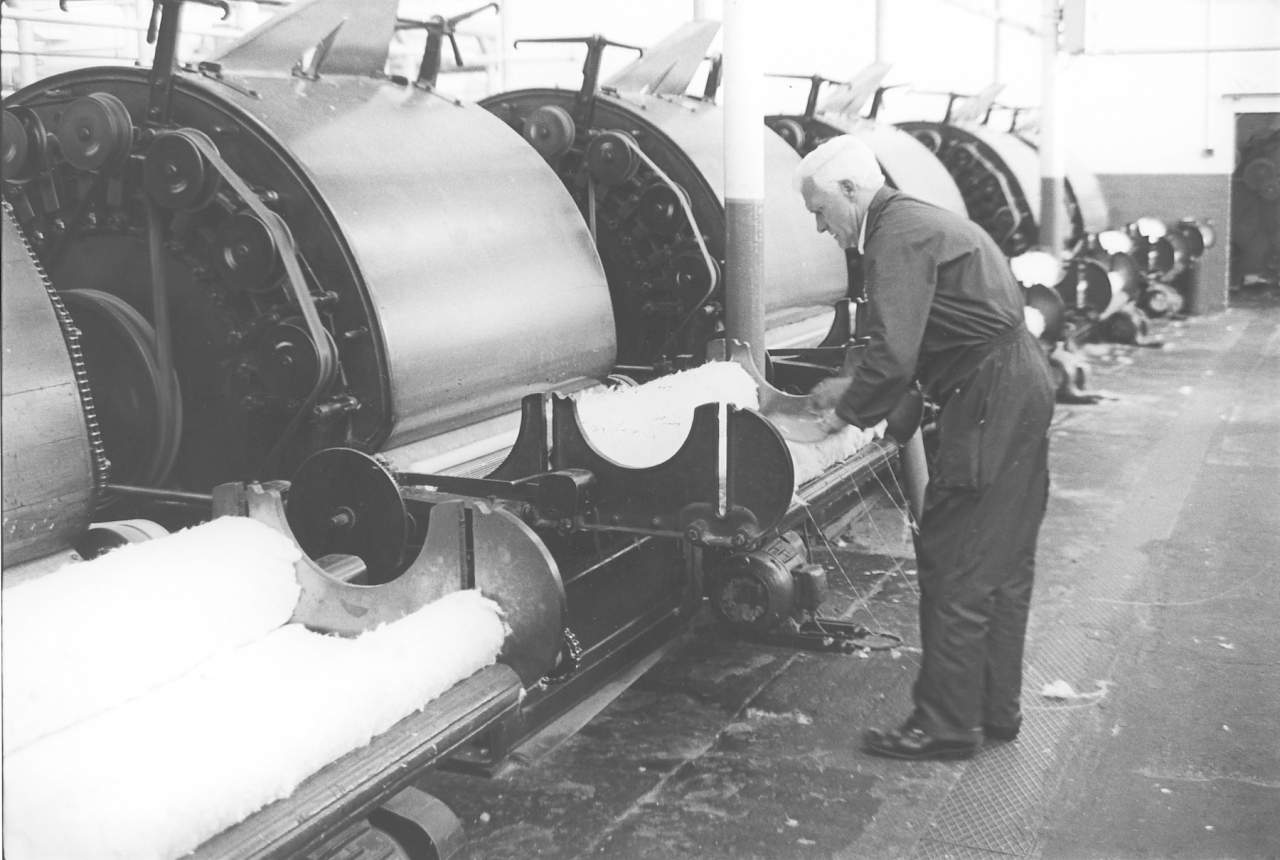
[21]
R- Now then, 0021, now we have got these laps from the scutcher and now they've got to be carded. And I should say that the action of the scutcher is to break down the, shall I say large lumps as I've already mentioned into smaller pieces. Now, when we get to the cards they are very small tufts but the card, the action of the card is to disintegrate all the tufts and get down to individual fibres you see. And if you were to examine the web coming up at the front there's no tufts at all, not if your machinery is set correctly. I mean that's the whole object of carding is to disintegrate the fibres and to separate them so that there’s ease of manipulation after processing. And then again, the thing is that carding, it does remove quite a lot impurities and extra short fibres, they drop out. Well, here you are, you have actually jumped the gun here, because these are finisher cards, no they are not…
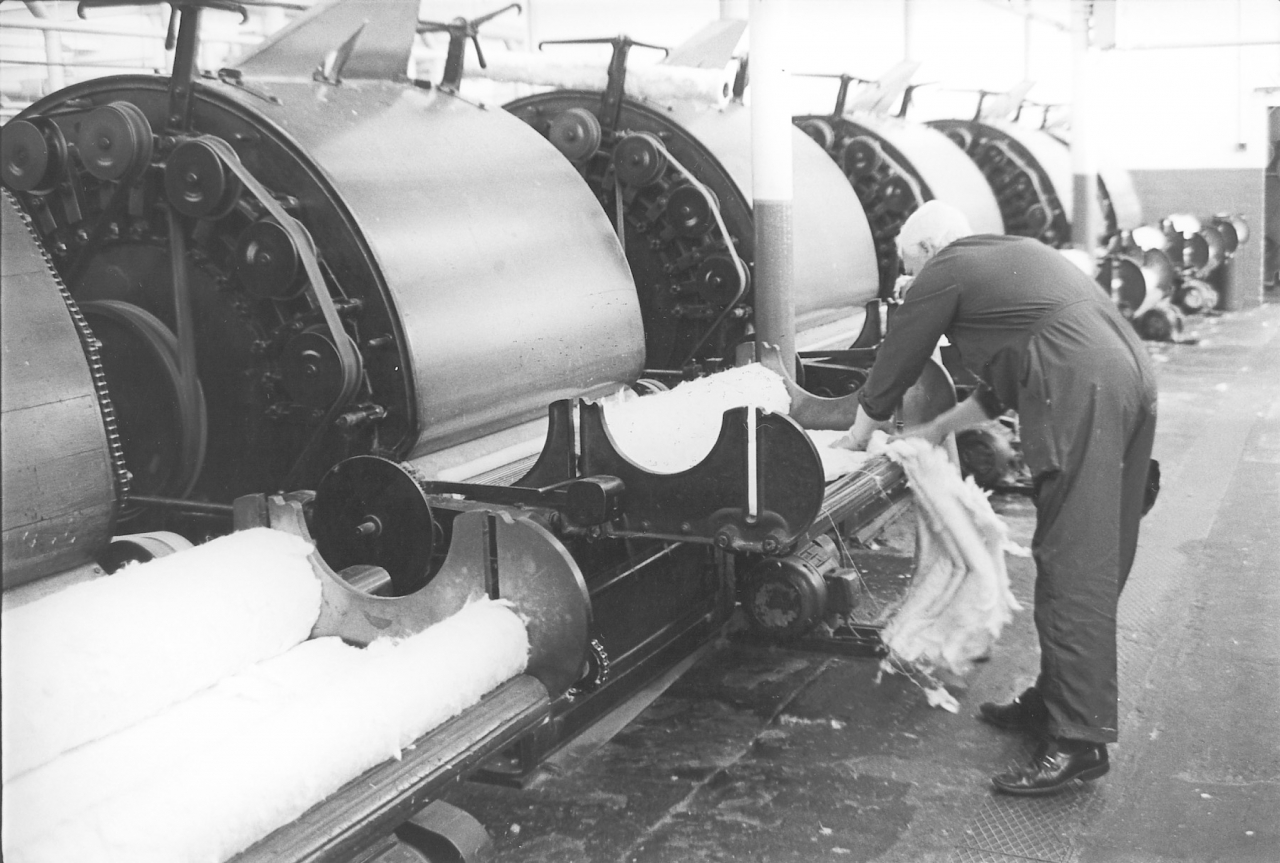
[22]
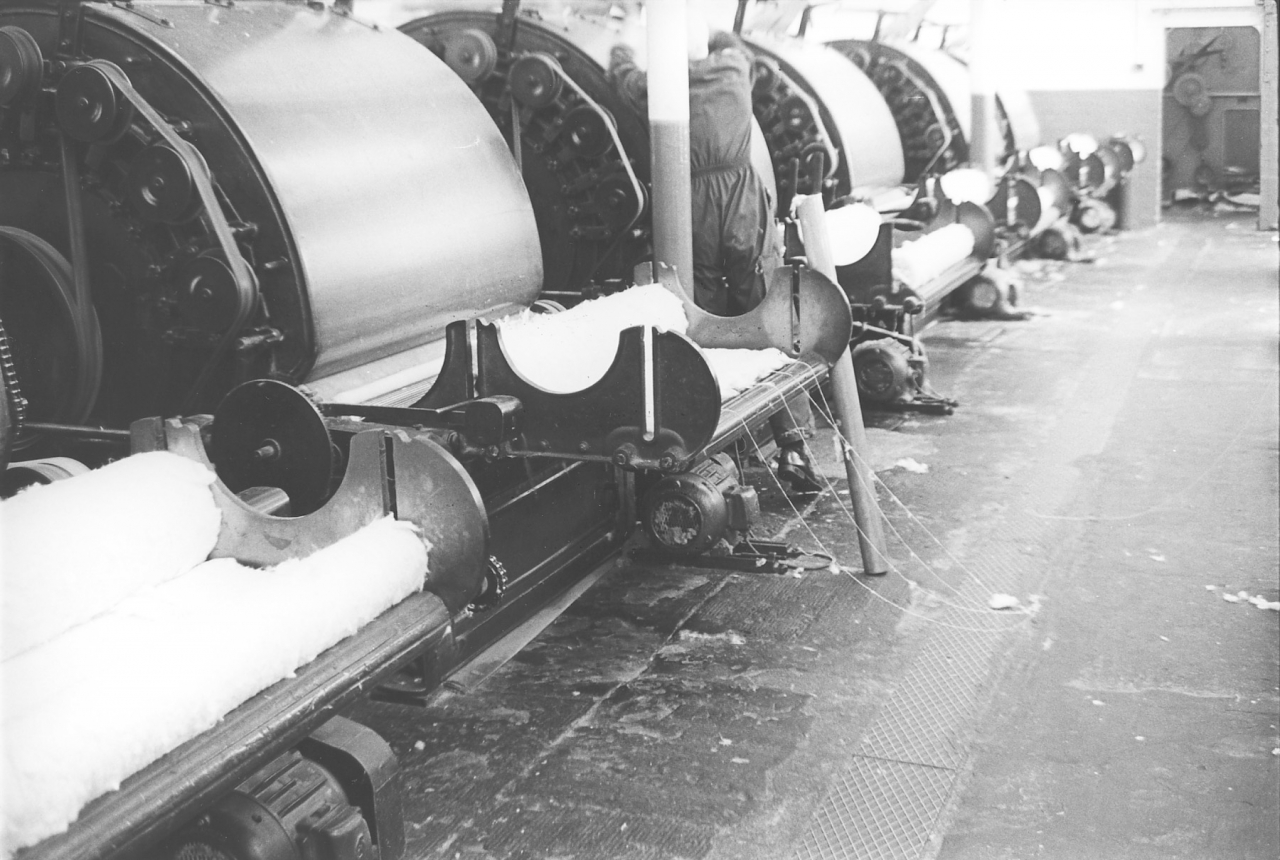
[23]
No these are the ...
R - No they are breaker cards.
Yes they are breaker cards. Yes.
R- No, that’s right. I beg your pardon. And the whole action is this, that you put two of these laps on.
Yes, which is another mix of course.
R- Which is another blend, you see. We have a light one and a heavy one you see. You can put them on together you know, providing the manager's not about. And hope that it'll be right. But you see, you put two on, well these two layers pass under the feed roller which is revolving very, very slowly and then they go into contact with what we call a taker-up which is a roller covered all over with saw teeth just like a circular saw. And of course they comb the fringe of the fibres out. And as the fibre becomes detached, they carry it forward and then they are put on the cylinder. Now the cylinder is covered with card wire. Now, card wire is a cloth foundation of about 1/8 of an inch thick and inserted into the cloth foundation are ‘U’ shaped wires you see, and the number of wires varies with the type of material you are using. You see you can have a (900) coarse card, or you can have a fine card and it varies, again it varies with the instrument that you've put the wire on. For instance, in condenser cards you have got the main cylinder which is 45 inches in diameter and 49 inches wide in the main. And round the periphery the upper periphery at any rate, you get a series of what they call rollers and clearers which are each covered with this card clothing you see. The thing is, to give a carding action the wire on the cylinder is bent at a certain angle. Now, the wire on the rollers is bent at the opposite angle, and it’s the rollers that actually, on the cylinder, that does the carding. Now, the wire on the clearers in at the opposite angle to take the cotton off the rollers and put it back on the cylinder. And so the process goes on until the material's gone right round. And then at the front we have a large slow moving cylinder 26 inches in diameter, again covered with card wire, on which the fleece is condensed. (45 min)
SCG/01 September 2003
6,711 words.
LANCASHIRE TEXTILE PROJECT
TAPE 78/SB/12
THIS TAPE HAS BEEN RECORDED ON AUGUST 28TH 1979 AT 13 WHITEHEAD STREET, RAWTENSTALL. THE INFORMANT IS JOHN GREENWOOD, FORMER MANAGER AT SPRING VALE MILL. THE INTERVIEWER IS STANLEY GRAHAM.
R- Right, the doffer as I have already said is covered in wire but the thing is as it revolves there is across its central point an oscillating comb.
Yes, this is on picture 0024.
R- This is picture 0024. And the oscillating comb vibrates very fast, and it combs the web off the doffer. Now the wire on the doffer is so set that the angle presented to the comb is the back rather than the face so that it combs off the back of the doffer wire . Nov, the thing is that it's collected on this tray, on a travelling apron and it goes through a (50) small hole, again we compress it and it's made into a rope. Now this is actually the first stage of a thread.
Yes.
R- And then of course, it goes through a coiler which is so regulated that the coils are laid flat and every portion of the can is filled with the exception of a small central hole. The speed of the platform on which the can rests is regulated and then we have what we call a tube wheel in the top that goes fast so that it's distributing the coil of the cotton rope into the can. Now then, so much for the action but one or two features of the card that are very interesting and that is that the rollers and clearers can be adjusted in height to the wire on the cylinder. And the usual practice is to go through the card, we set these with metal gauges, and I’ll give you the figures as they come to me. And that's the feed roller to the licker in, that's the one with the saw tooth roller, (100) is 7 to 10 thousandths of an inch, the licker in to the cylinder is 7 one thousandths of an inch. Now, the back rollers, the back pair, and usually there are seven rollers and seven clearers, are set at l2 thousandths of an inch, the next pair at 10 thou and the front two, the front three at 7thou. Now that's not hard and fast. Different carders have different ideas, but these are what you might call the guiding lines. And then of course, the clearers are set at 10 thousandths of an inch to the cylinder, and at 12 thousandths of an inch to the rollers, you see? Now there is at the front a roller which is covered, it's usually 7 to 10 inches in diameter and it's covered with very long wire, and when I say long, the normal wire might be ½ an inch on the cylinder, rollers and clearers. This wire is 1 inch to 1 and 1/8 of an inch and it's very fine and soft, it's not rigid. Now this is the only case in the whole of the textile (150) industry that I have come across where a roller, where the wire on one roller actually touches the wire on the next roller. And you actually set the wire on this particular roller which we call the fancy roller, into the wire on the cylinder to lift the fibres to the top ready for the doffer. And the surface speed of the fancy should be at least, 10% faster than the surface speed of the cylinder. Now the rollers of course, they only travel very slowly, round about, I think it's about 22” a minute you see. Whereas the clearers, they just go fast enough. I should say that the rollers are 6” in diameter and the clearers are 3” in diameter. Well, the clearers of course have to go so much faster to take the material off the rollers. Anyway that’s that, and that completes the breaker card. Now we have got the rope of cotton in cans and these cans are taken to another machine which is called the Derby doubler, but the name's a bit of a misnomer in as much as it doesn’t do any doubling at all.
That's it, that's something I couldn't understand, yes, go on. Picture 0025.
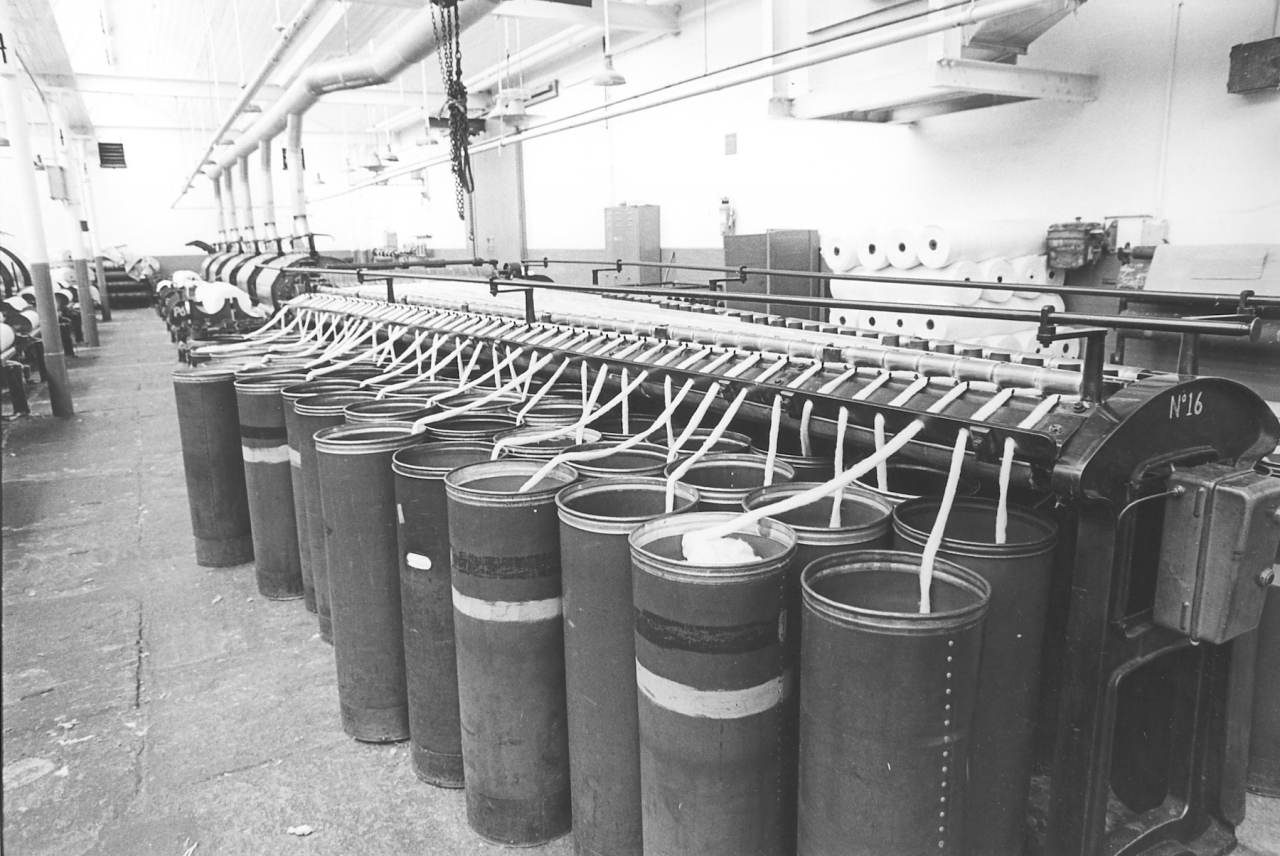
(200)
R- But what it does, we take 96 of these cans and as this doubler is a long ‘V’ shaped machine they are spread down either side are the cans, and then the material is put through a hole in a guide plate. It passes over a spoon, and then it goes under the take in rollers. The object of the spoon is this, if a sliver breaks, we call these ropes a sliver, if it breaks, the spoon tilts and stops the machine instantly or it should do before the tail end of the sliver has got into the take in rollers. [And then a new can full of sliver is put on and the end pieced up] So that you see you have no gap to make a variation in the lap. Now, when we have got these 96 slivers, again, we press them through calendar rollers and we make them, re-wind them into a lap and we hope you see, that when all these slivers are gathered together they may equalise themselves should there be any variation in the thickness.
Because here again, this is a blending process.
R- It is indeed, yes. Because although we have got 96 cans going in, in the ultimate, when it's made into a thread on the next process we shall only have 30 threads coming out. So in point of fact, in theory you have got three slivers making one thread you see?
Yes.
R- And of course the slivers are regulated in channels so that they can't wander because after all, and you can see from the picture that machine is anywhere up to what? 30 feet in length. (250)
I think you'll find that picture number 0027 John shows that quite clearly, it's a view from the top of the machine. (10 min)(300)
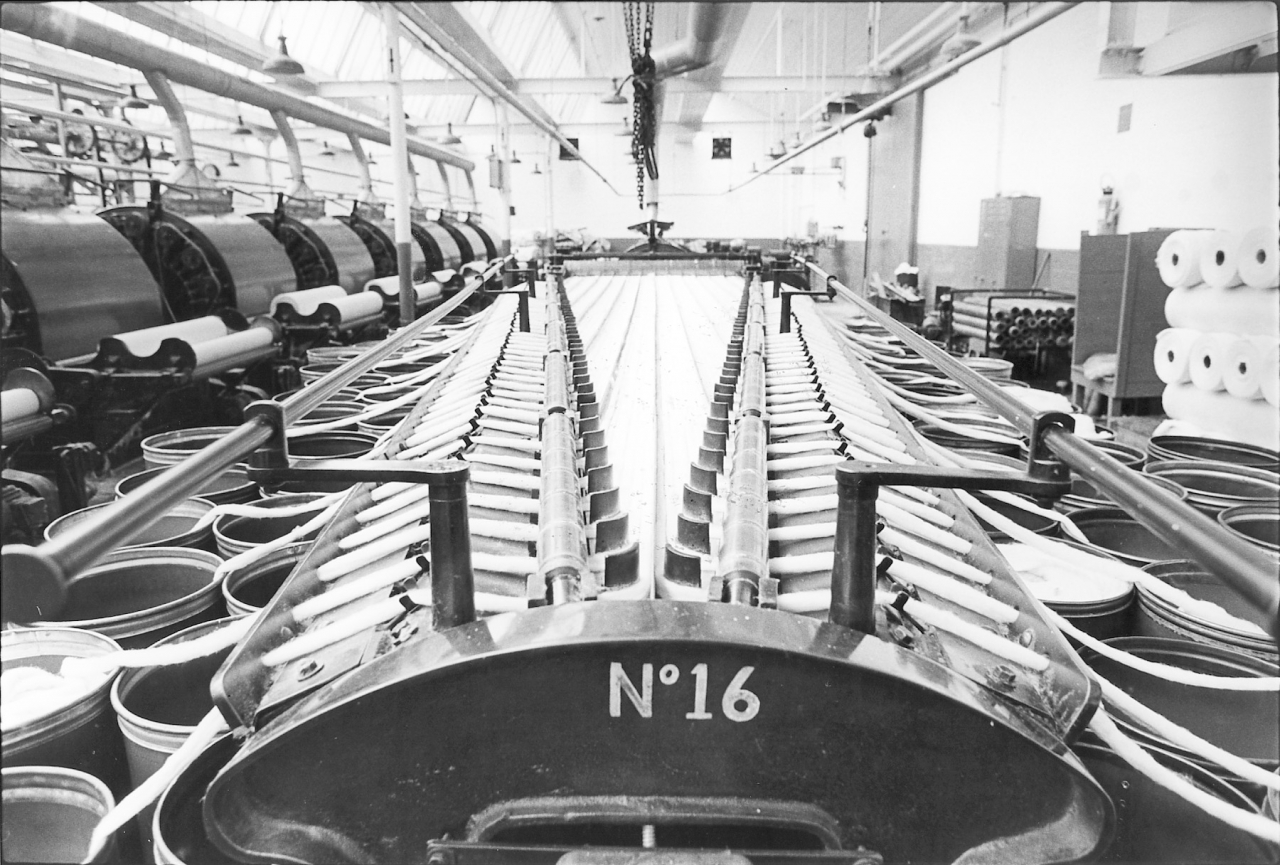
R- Ah you see. But they could tend to wander in that distance you see so they are channelled. Anyway, the other pictures show the Derby Doubler from the different sides. Here we are, number 0027 is the one that shows the channels up more distinctly and the number of slivers are regulated according to the width of the channel [machine?]. You see for instance, in the very top it's only comparatively narrow. Well there might be four slivers in there or six. Well down here of course, where you get to the centre of the table, you see you might have twelve slivers but the width is in pro rata to the number of slivers. They, it’s graduated.
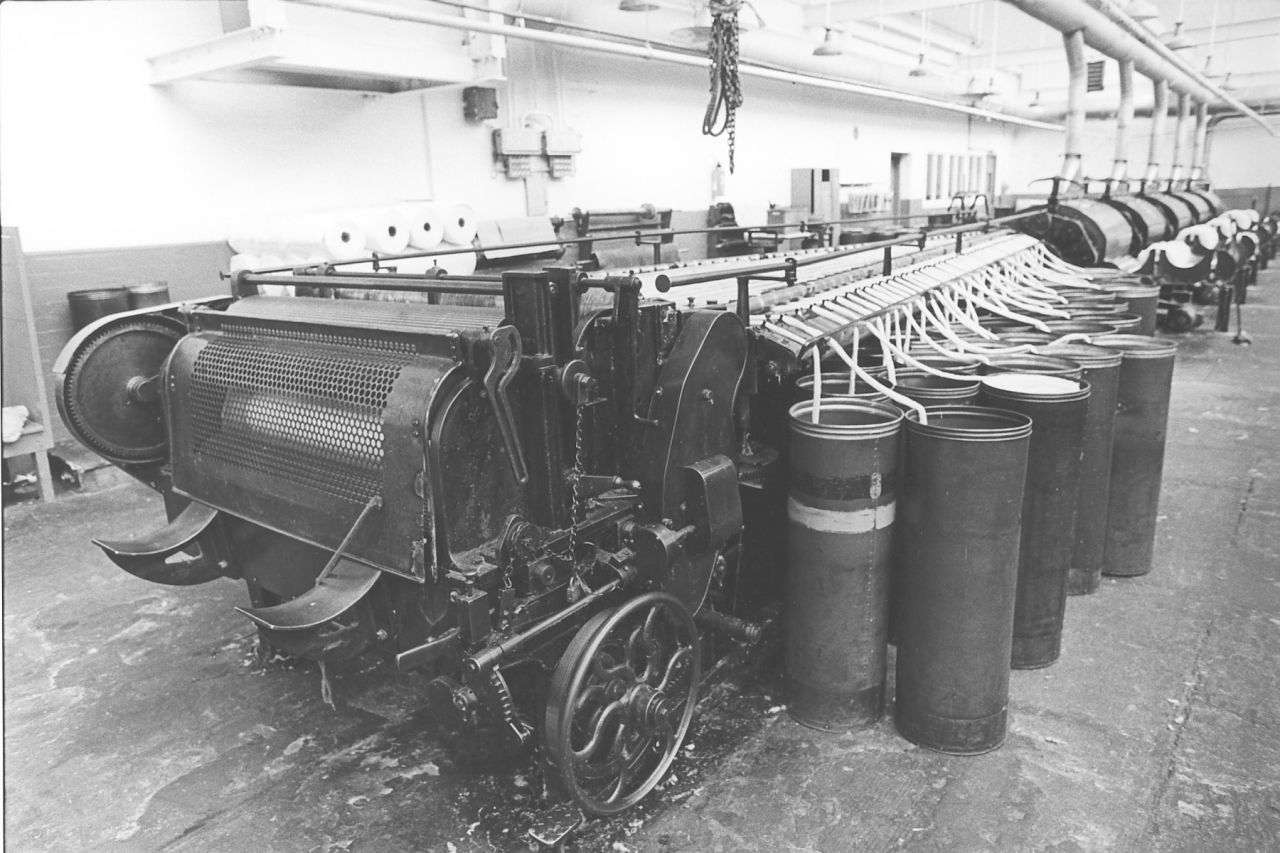
And 0028 is a good view of the mechanism because it shows the guard over the rollers. And they’re very stringent about these today, you can't get your hand in at all, well you haven't to do. And it shows the mechanism for raising the guard and the point is that you can see a chain in it. Now that chain will stop the starting handle you see. When that starting handle, when it's gone a specific length you'll see the ratchet mechanism here which moves so many teeth and allows that handle to drop which then disengages the driving wheel and by virtue of that chain and a friction wheel it raises that guard. So although there is a wheel, a hand wheel on, all the operative does is put the foot on the pedal, as you’ll see, and then the guard should raise itself and the lap should he ejected so that there is no putting your hands in. That’s a Derby Doubler. Now then…
How did it get its name of Derby, any idea?
R- I can’t tell you that at all, it goes back to antiquity. As far as I know it has always been a Derby Doubler, whether a chappie called Derby invented it, I have no idea.
That’s it aye. Picture number 0029. Eh but really 0029, the only reason I put that in, it's the back of the breaker cards again, it was the fire buckets again.
R- Oh yes. Well of course the whole of the room is sprinklered you see. All of the room is sprinklered but we do have these fire buckets and the extinguishers.
[By ‘sprinklered’ John means that it is protected by a sprinkler system which is a series of pipes containing water under pressure which are fitted at regular intervals with sprinkler heads. These are spray nozzles which are held closed by either a fusible link or a small glass capsule filled with a volatile liquid. In either case, any rise in temperature to a dangerous level melts the link or explodes the capsule and allows water to spray out. This spray either extinguishes the fire or slows its progress allowing staff to escape and giving more time to get the fire service to attend.]
There are also humidifiers in that room isn’t there?
R- Oh yes. Well this is it you see, because being a shed, I mean you can see the humidifiers, being a shed, when the sun's on [the roof]of course it dries the air up and of course you put this moisture back again. Because as I say, cotton works best, is most pliable at 8 ½ % moisture and of course if you get it under a drying heat, it’ll dry some of the natural moisture out. And you'll also see the thermoliers for heating the shed.
Yes, that's it the fans, yes. (350)
R- Besides the steam pipes because again you see, you've got to have a certain temperature for cotton. It works bent in conditions as near alike the conditions when, where it grows. That means to say that it's got to be warm and it’s got to be moist you see? Right, well now then, the thing is we have taken two laps from the Derby Doubler and they are put on the back of a finisher card which is the exact replica of a breaker card except the front delivery doffer.
Yes. Actually, if I could just interrupt you John a second. Picture 0030 is just a picture of a row of cards, but there are some better pictures of the condenser cards further on. Now the next pictures…
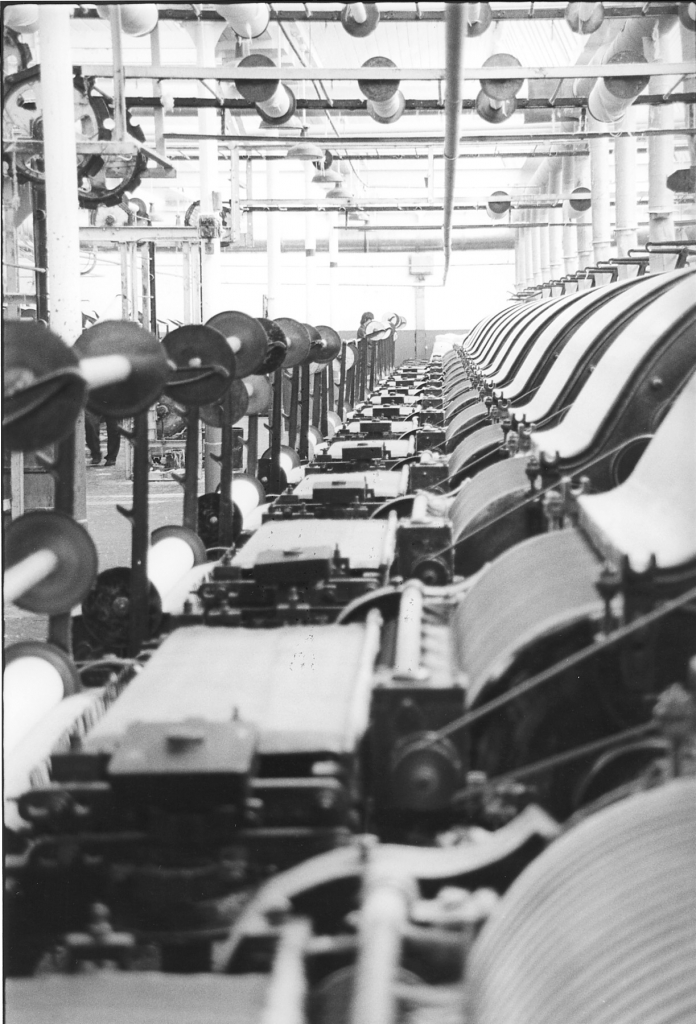
[030]
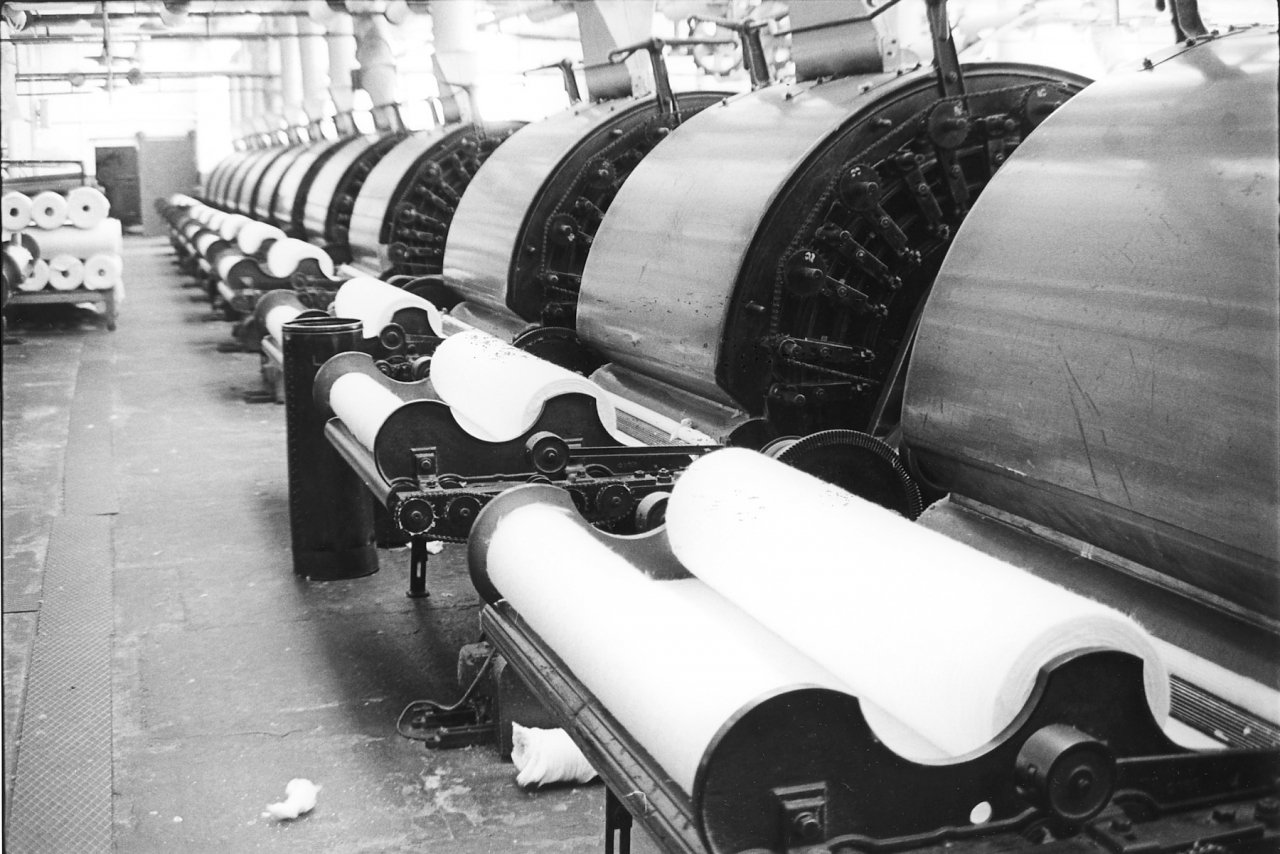
[031]
R- Yes. Oh here, picture 0031 shows the two laps behind the condenser card. And the point is that again, evenness is the characteristic sought by putting on two laps. Now the condenser card is exactly the same as a breaker card in principle, the only difference being that the doffer at the front, instead of being a continuous sheet of wire, is divided into rings. And we have got a ring of wire, and a ring of leather, so that the web is split up then into small sections and they ...
This is picture number 0032 of course. (400)(15 min)
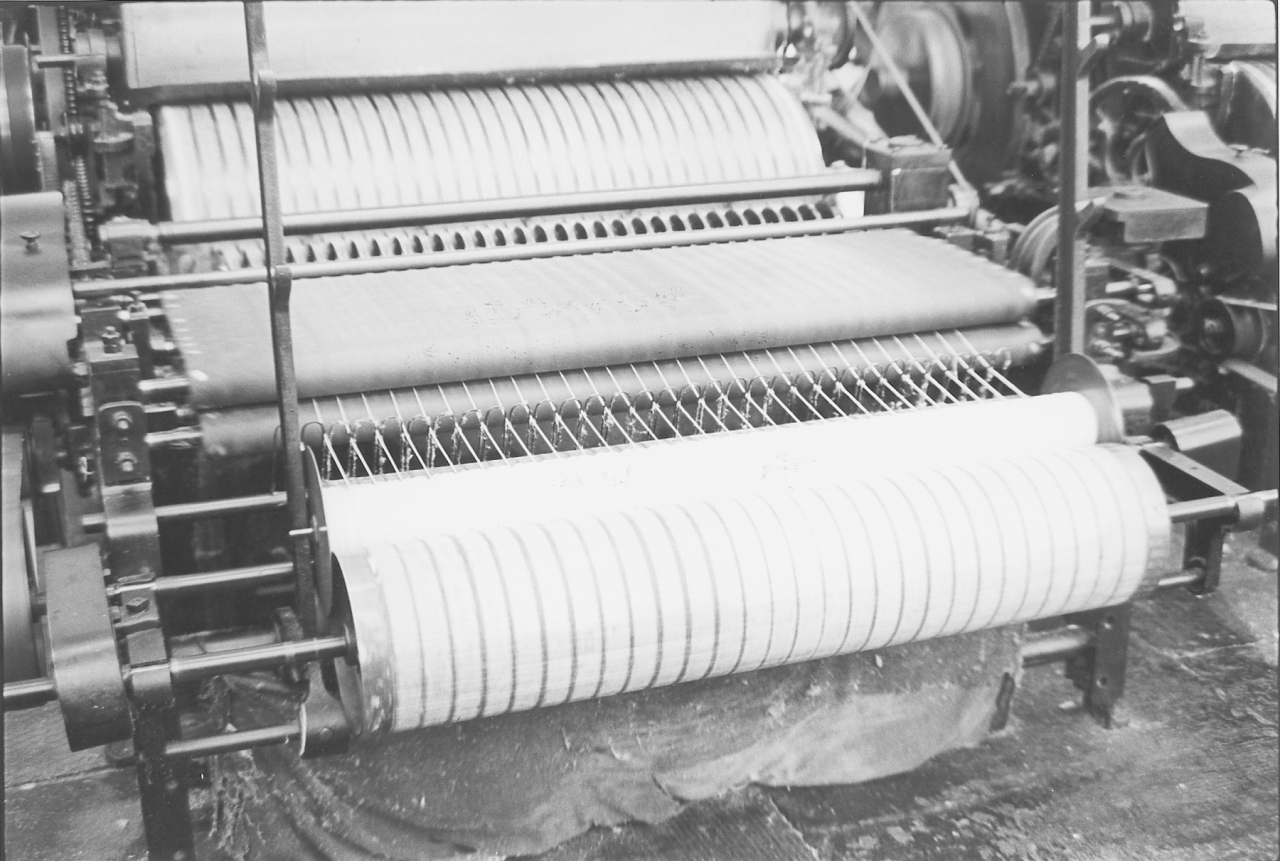
R - This is picture number 0032. And then you'll see the rings on the doffer and then it passes through, or over a dividing roller which is just to separate the slivers. And then we come to what I believe to be the system where the trade gets its name. The point being that when it's passing through these leathers that are going sideways and forward at the same time they are known as condensing leathers you see, and it's the only place where I could find that the word condenser comes in. So I’m taking it that the trade takes its name from the condenser trade in as much as the slivers are, the threads are made by condensing them from the small pieces of web, and then of course you see they are wound on to a bobbin for conveniences for taking now to the final process, which is spinning.
What difference is there John between the manufacturing of the roving by use of the condenser leathers, to the way roving's manufactured in fine spinning. Do they use the same process for making their roving or is it a different process?
R- Oh no. It's a different system altogether in as much as condenser spinning is the shortest of short processing. Or was I should say, it's not now with the new technologies you see. But in the old system of spinning cotton they used to get it from the bales, put it through a bale breaker to loft it, then it used to go through the cleaning plant, which might be Crighton openers, Buckley cylinders, whatever, through as it is now, step cleaners. They still use this system by the way in cotton spinning, step cleaners. They have advanced tremendously, but this is to take out the bits of seeds and sand that have got into the cotton. And then it goes through the scutching process, similar to ours, and at one time, I mean it's easy to get confused with new technologies, but at one time the laps were then taken to the card. Now they still have the cards but they don't have the scutcher in as much as the stock is fed direct from the opening plant into the cards. And then from the cards of course, in the ordinary spinning you've got to get the fibres absolutely parallel for ease of manipulation, elongation in drawing them out, and this is where the processes start, putting that little bit of twist in to make them carry along. Well you've got the draw frames, of which it went through three, we used to call that three head drawing, and then it went on to a machine that took it, it was still in rope form when it came out of draw frame and then it went into a machine which we call the slubber, from which of course, the thing is it was drawn out three times.
Yes, it was drawn out by draughting rollers, weren't it?
R- Draughting rollers. And it went on to the intermediate, which was another glorified slubbing frame, except it used rovings instead, or it used slubbings, which is a big bobbin of soft material, instead of cans. And then it went on to the roving frames which again drew it out eight times finer and then from the roving frames it’d go, it went an to the spinning unity, all roller draughting. So you see, with all this roller draughting you had to have your fibres parallel. Now, in the case of condenser spinning we don’t aim so much to get the fibres parallel. I’ll explain why when we come to the mule.
Yes, great Johnny, great.
R- So the thing is this, as I said this is the shortest of short processing as it stood.
Yes, and I think that must be one of the shortest explanations of the fine spinning process that there’s ever been.
R - Oh I could go into a lot more detail you know?
Well I know you can, but no, but the beauty of it is that it is perfectly clear, that’s perfectly clear to me, that's what matters.
R- Right, picture number 0033.
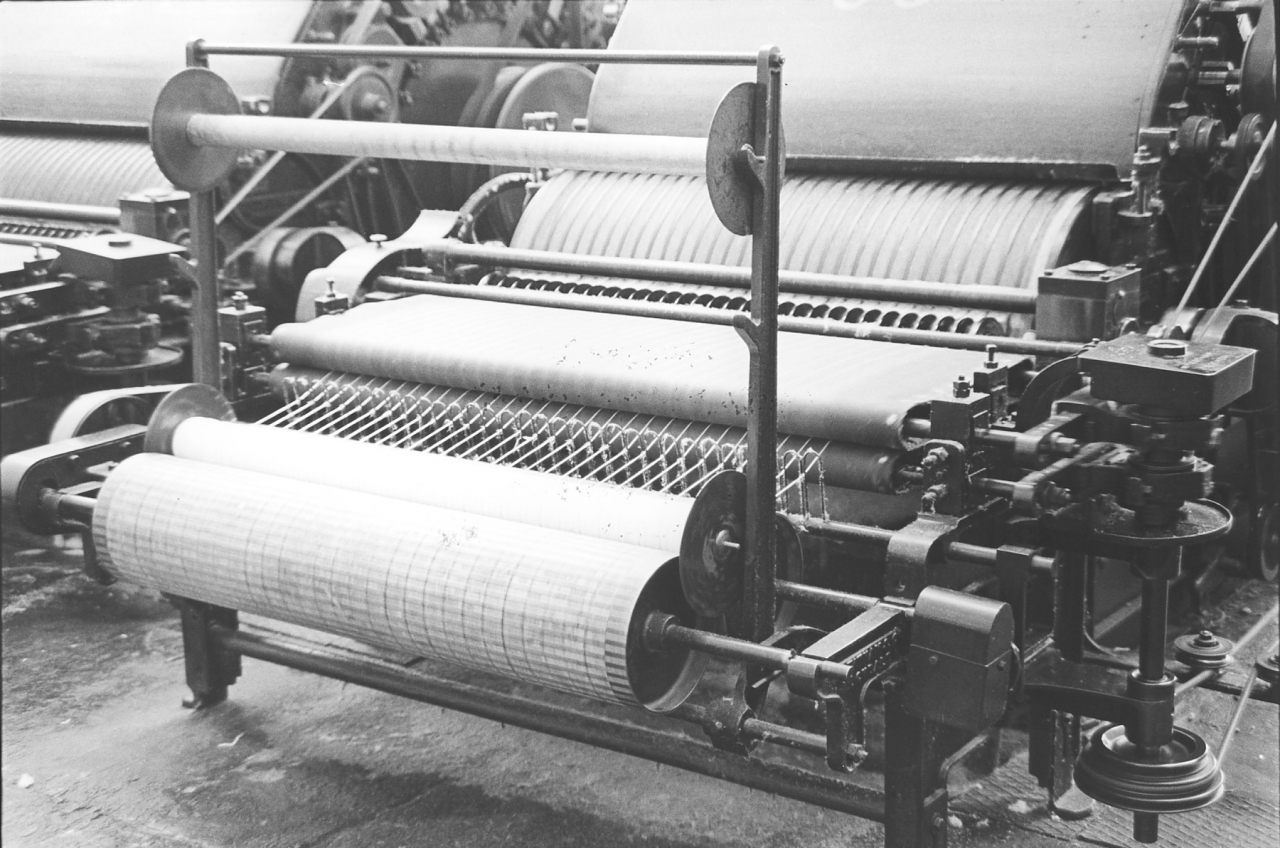
0033 yes.
R- This is another view of the condenser showing the eccentric motion.
That’s it. (500)(20 min)
R- This upright shaft driven by this rope makes the rollers go sideways but at the same time, the gearing at the opposite side turns them round you see. But this gives the eccentric, the two eccentric blocks there and you can alter the degree of stroke you know to rub it harder or softer, according to the position of your eccentric blocks.
Tell me now, John, one question please, is there any adjustment on the pressure between those two pieces of leather?
R- Oh yes. You can see there are these nuts on top of the, what you might call these little castles for the want of a better expression. Now, the middle one is spring loaded you see, in either case the middle one is spring loaded and you can adjust the front. You can't adjust the back, but you can adjust the front and these, you see running through these rubbers are a series of rollers you see on which they run, but the pressure rollers as we call them are in the middle. Because there are three with one on the top, you see, and the top one is the one where you put the pressure on with the spring but the two are more or less fixed in the framing, the two bottom ones and the top one presses the leathers together.
Now which governs the hardness of the roving when it comes out most. Is it the amount that the rubbers move from side to side or the pressure that’s put on by the middle roller.
R- Both.
Both, so it's a matter of balancing them out (550)
R- Both yes. Yes, the thing is that you can alter your degree of stroke for instance, the main object of altering your degree of stroke, say for instance you have got some long fibred cotton in. Well, now then you'd find out that as the material passes through these, the fibres get interlocked and when they come to the front they pass through these slots in the guide wires, they are guided on to the bobbin, they'd stick together and break down so that then you shorten your stroke. Now, on the other hand, if you get some very short cotton in you see, of which there is no length of fibre to grip on itself you give it that bit more or again you can adjust the speed at which your rubbers oscillate.
Oh, as well as the stroke.
R- By virtue of that stepped pulley there.
The stepped pulley at the bottom right-hand corner, yes.
R- You see because when you get these ends what we call crossing or breaking, you've get to take steps that cut that out you see.
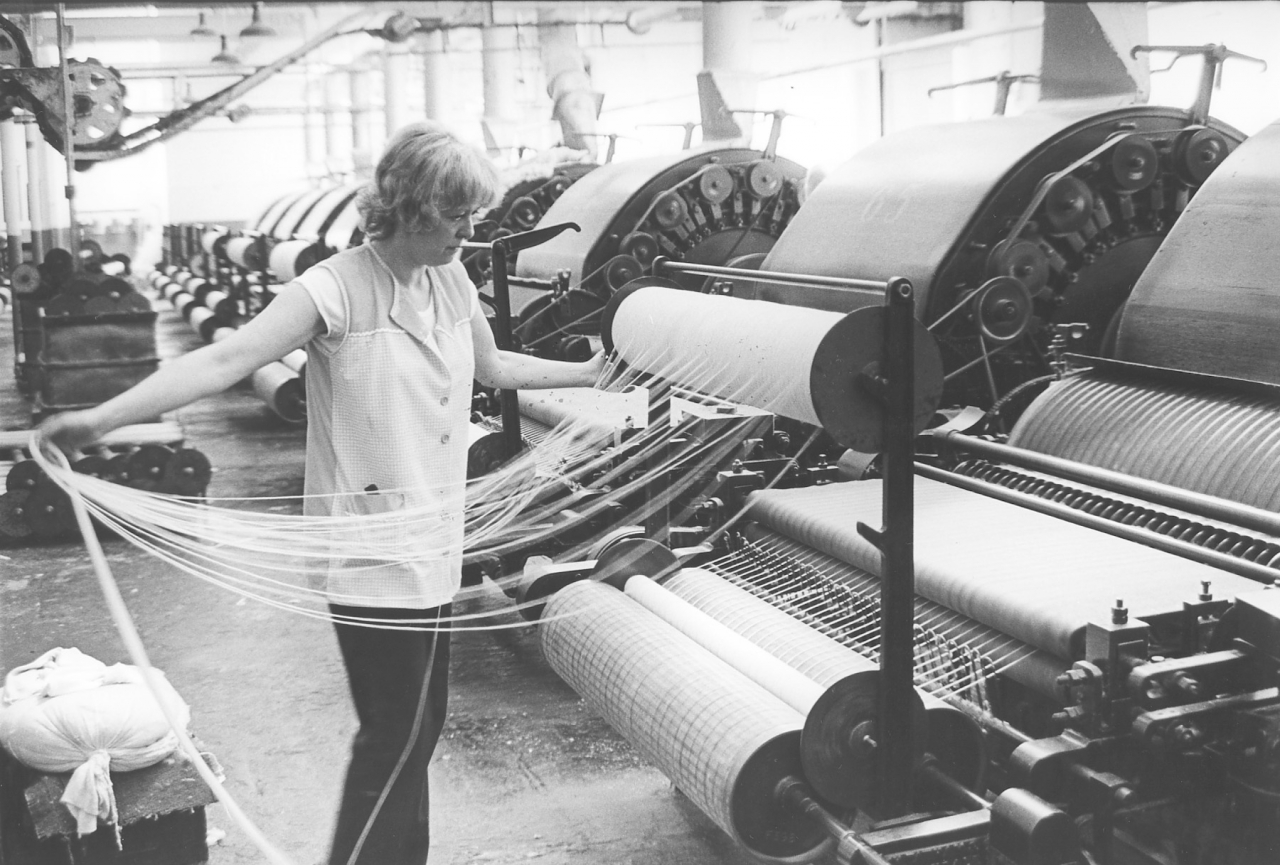
[034]
R- Because it you look at 0034 the lady is what we call readying up a bobbin. In other words she is readying it for spinning, because there's been more than two ends broken. Now, a spinner will tolerate two ends broken but he'll not tolerate three, this is the mill practice. So you see, she has had more than two ends broken so she is having to get those threads ready for spinning and finding the lost ones. That's number 0034 and that's Glenys by the way.
That's it, Glenys, aye.

[031]
R- Now, number 0031 shows the condenser cards and in this case Glenys looks after 11, and she tends these 11 cards, they are facing each other, so that she hasn't too far to run. And the bobbins are conveyed away on an overhead conveyor. And now this conveyor in this particular case runs right across the shed so that wherever there are condenser cards they can put their bobbins on and it takes them away. And then it actually goes through to the top storey of the three storey building and conveys the bobbins up the wall side and across the top spinning room, and then comes down through the first floor spinning room so that the bobbins can be taken off at the place where they are needed. So number 0036 shows Glenys putting a bobbin on with her thoughts many miles away.
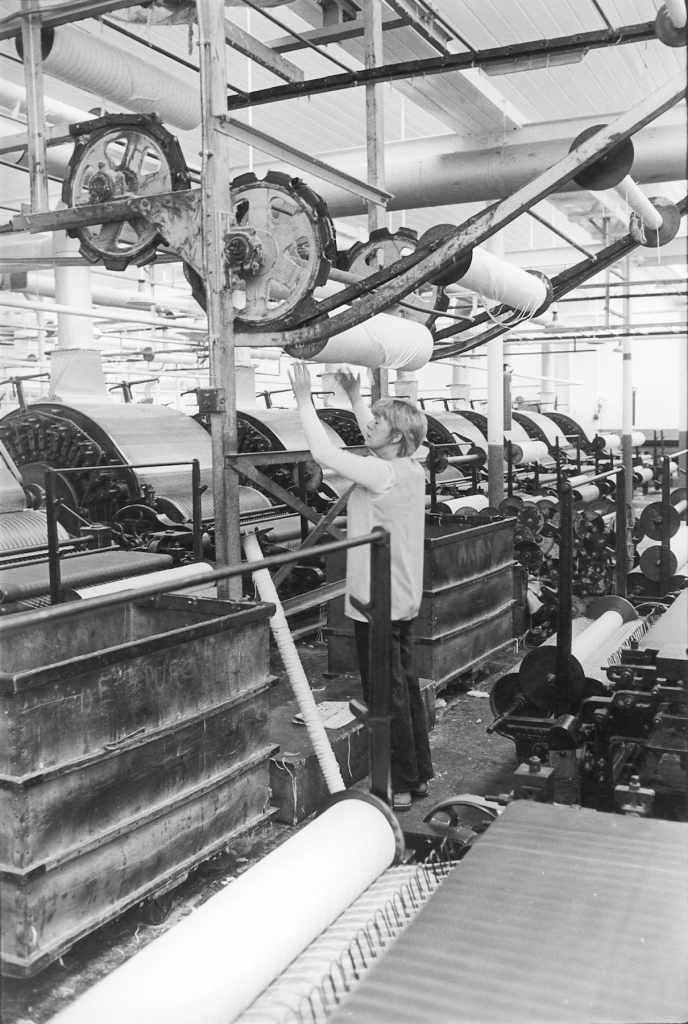
[036]
Aye, they are! (600)(25 min)
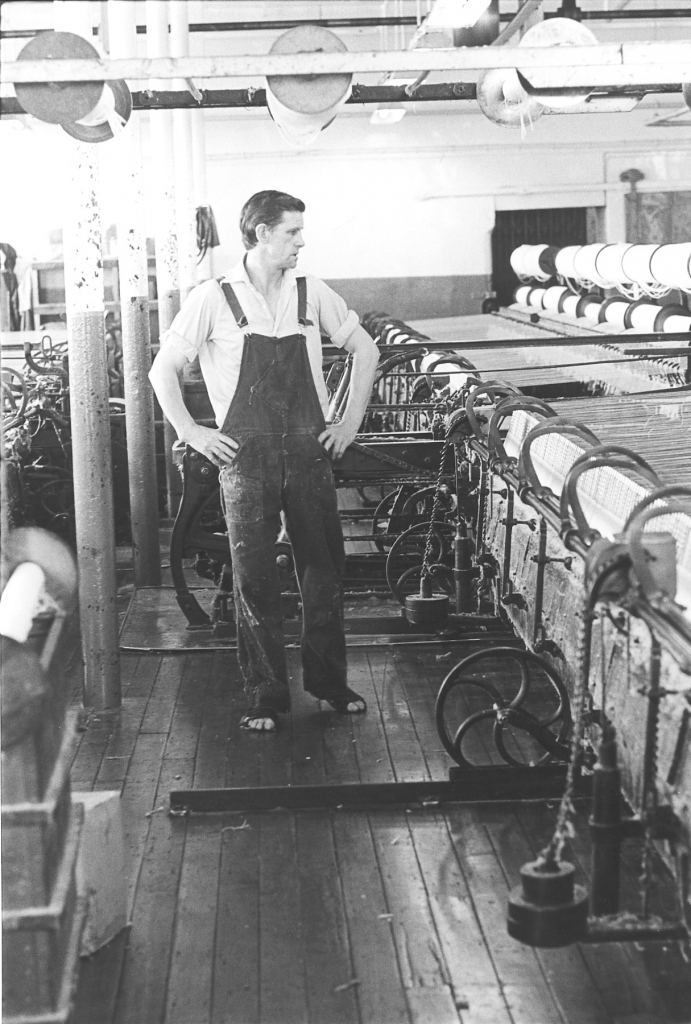
[40]
R- [Svspinning section of the Spring Vale folio from now on] Now, picture number 40 we are on now. Now this is the actual spinning process. And first of all, what is spinning? Now, spinning is taking a series of fibres, holding them at two points and turning them on their axis with the result that when you turn it on its axis you twist it together. And that's all spinning is, is the twisting together of the fibres. And to do it mechanically of course we’ve got to hold it at two points, and we do this by means of spindles and rollers.
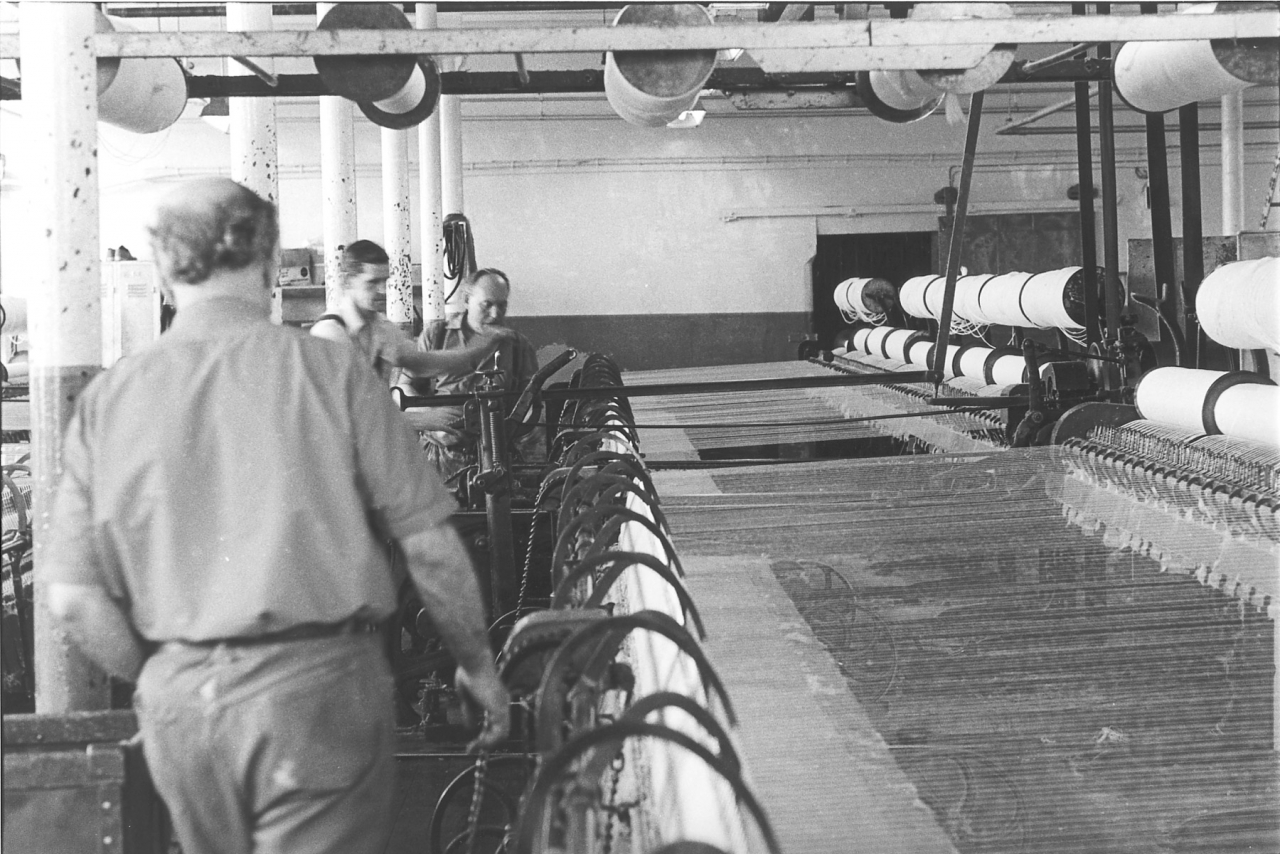
Picture 41 gives you the sequence of the operation of the machine and then we'll talk a bit about the machine after. The thing is that the bobbins from the cards are placed in a delivery creel and the threads are passed under rollers. Now these rollers deliver x number of inches every time the mule carriage moves on its rails. Now the mule carriage is mobile, and from being stationary it moves out a distance of 60 inches and then the spindles on which the threads are held start rotating. And when they have rotated a specific number of times they automatically stop, and then the guiders come into action, what we call the fallers. And then the machine reverses and runs into the back winding the threads on to the pirns. And that’s briefly the spinning process. Now the machine itself is a very, very complicated machine. In this particular case, in my opinion, the most complicated piece of machinery in the textile industry mechanically. In as much as these particular types of mules are peculiar to the condenser spinning industry.
These are Taylor Langs we are talking about. (650)
R - These are Taylor Langs, and they are adapted of course from Crompton’s original idea of the spinning mule. But you see, whereas Crompton, his spindles run at a constant speed, in the case of these particular mules the spindles don’t; but Crompton was the first chappie who actually invented the moving carriage, because in the Arkwright water frame the spindles were stationary but the creel moved you see? Now Crompton had a stationary creel but the spindles moved and of course the thing is it's Crompton’s centenary this year, or whatever it is, I wonder if ...
Yes, I went to the exhibition in Bolton the other day, John.
R- Is it good?
Yea, it’s worth seeing, definitely.
R- Oh, where is it, Th’Hall I’t Wood?
No it's at, it's on Le Mans Crescent at the Art Gallery and they have got the original Crompton mule there and the new copy that's been made. Well worth seeing.
R- Ah. But anyway, the thing is that this particular condenser mule you see, with the threads being for a particular end use where you want a lot of cover [The weft thick enough to make the cloth dense on lower count warps]. In other words the fibre has to stand out, you don't want too much twist in to bind the fibres into the body of the yarn. So Taylor Langs conceived the idea. Oh well, I don't know whether Taylor Langs did because I've seen mules older than Taylor Langs where they had the same principle that we have on the scutcher of cone drums where the spindles, the carriage started out slowly and of course as it get further out and further out the speed of the spindles increased because they were driven from cone drums you see. And as it got further out the spindles ran faster you see. Now that’s about the earliest type that I have seen. But on this Taylor Lang, the spindles are driven by three different mechanisms but they are all intermingled. For instance, on picture number, you haven't got a good picture, oh, on picture 47
[47]
you'll see if you look between the bobbins on the creels, two driving straps. Now in the first place the spindles start (30 min)(700) out, or the carriage starts out and the spindles are driven by the strap on the left, which is known as a carriage strap. Now that carriage strap also drives the carriage but in the first instance it drives the spindles as well and then through various levers and cams the second strap which is known as the twist strap takes over and drives the spindles, overdriving the carriage strap you see. And then again, when the carriage has gone as far as its stretch, the twist strap is switched from one pulley to another pulley which has a higher ratio of speed to what we call the rim shaft, which actually does the driving of the spindles, which overdrives the second speed and the carriage strap you see and gives the spindles their final speed ...
Yes. I think that those will become a lot clearer in the other pictures that show the other parts of the mule John, later on. But one of the things was I had to decide where to start when I was doing the mule so I started with doffing. I started with them setting the mule up to doff.
R- Yes. This is when a specified amount of yarn has been put on each pirn, and the pirns are placed on those spindles and of course, when a specified amount of yarn has been put on it automatically stops so that there is the same length of yarn on them all. And then the spinner has to prepare his mechanism to accommodate the bare spindles again you see. And then 42 shows the various stages and 43 shows the various stages.
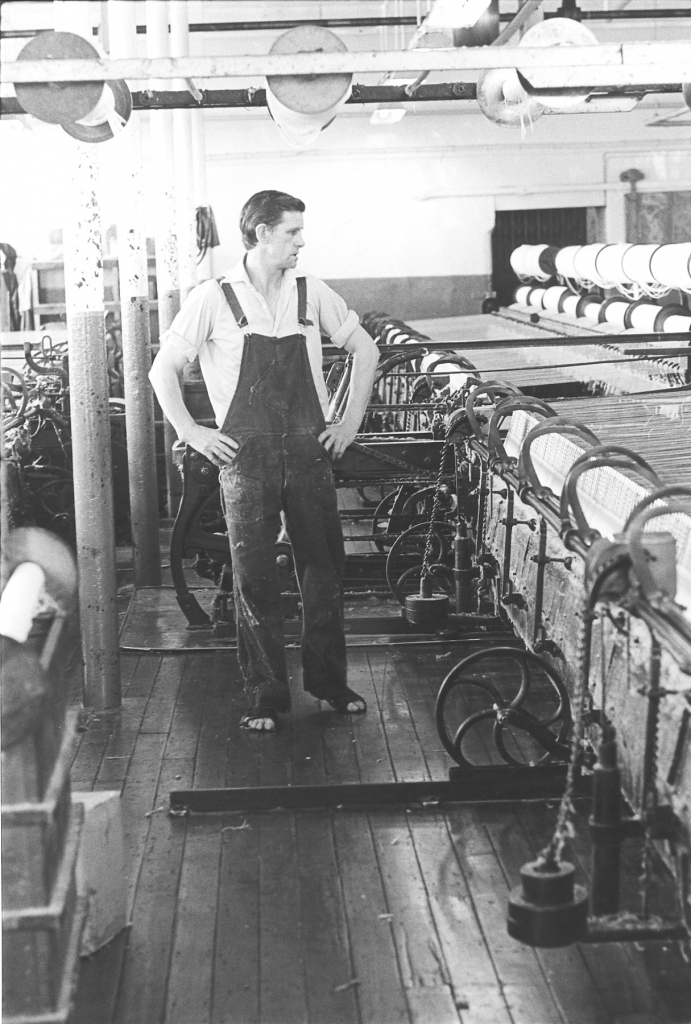
[42]
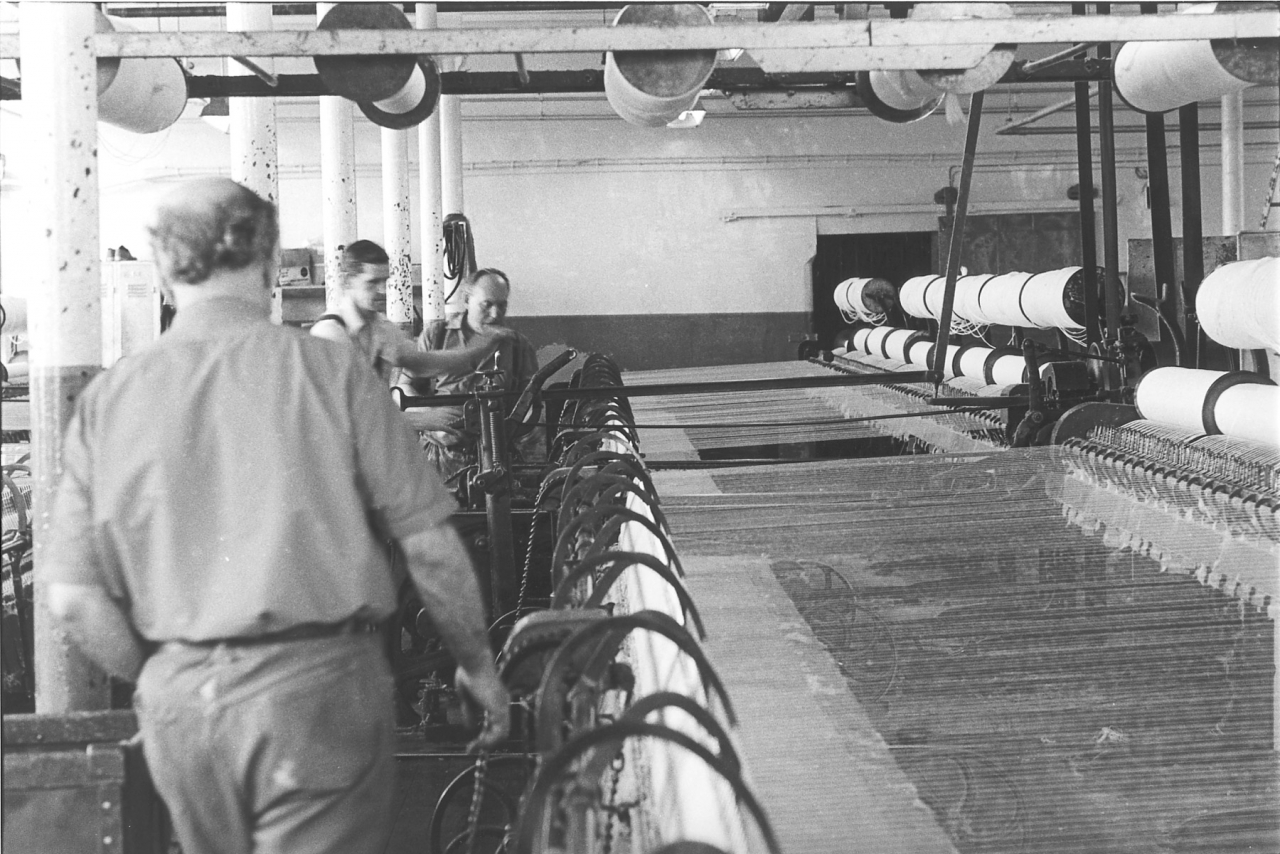
[43]
Where he has slackened the threads and if you look at what we call the sickles, which run down between the spindles, they have now been brought to the bottom of the spindle you see. Now then, he's tightened up, because what he has to do before he can remove the old pirn is to put a small amount of yarn on the bottom of the spindle so that when the empty pirn goes on it will automatically start to wind on. So that’s number 43. Now then, he’s tightened up and he’s adjusting the builder motion.(750)
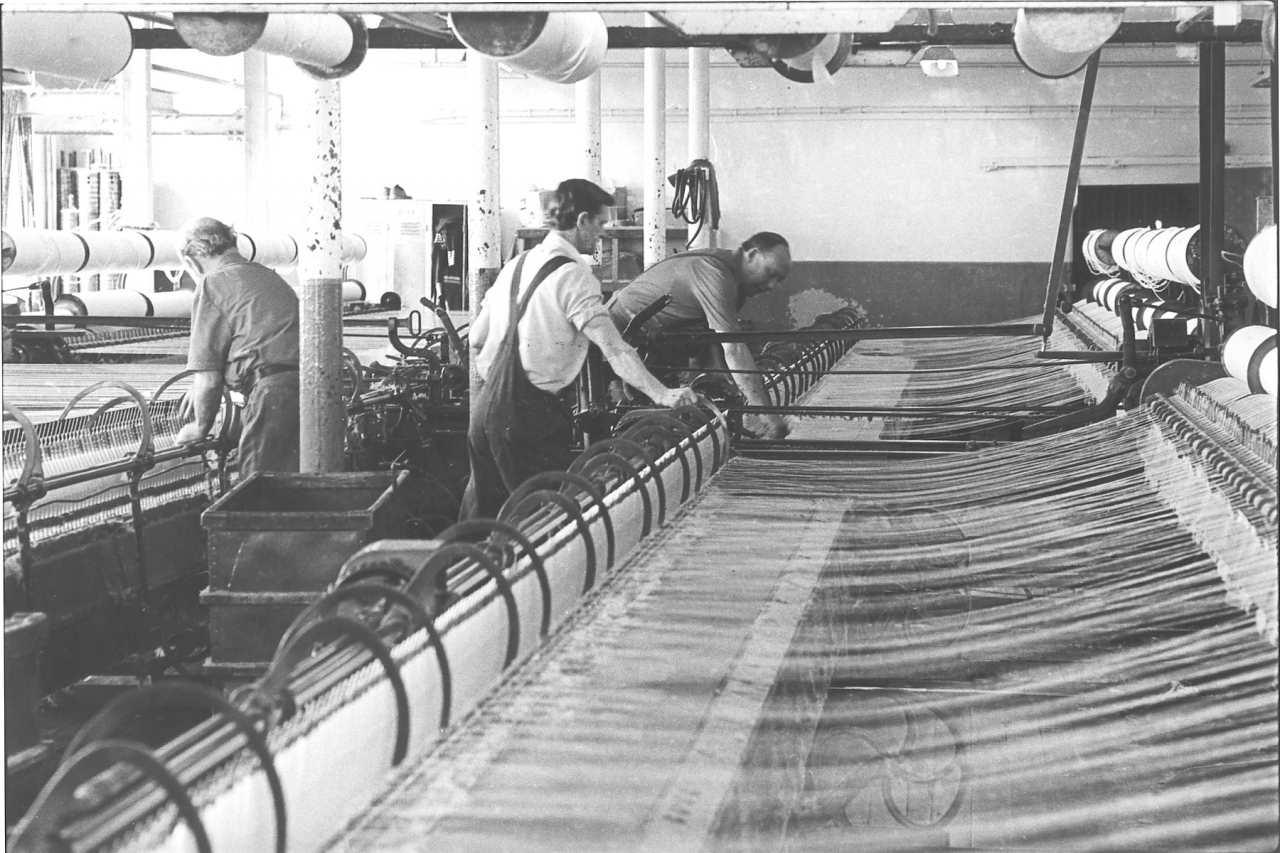
On picture number 44. Yes.
R- You see on 44 he is adjusting the builder motion, he is the chappie at the back. Because they are built up by, again, a very special and intricate process in as much as you have got shaper plates that the rail on which the sickles are based has a differing profile. And because of this the sickles lift up and descend thus altering the profile [of the yarn on the pirn].
Yes. Those will be what Jim called copping plates.
R- That's it, those are the copping plates, yes.
Yes. Well we have some pictures of them further on John.

[45]
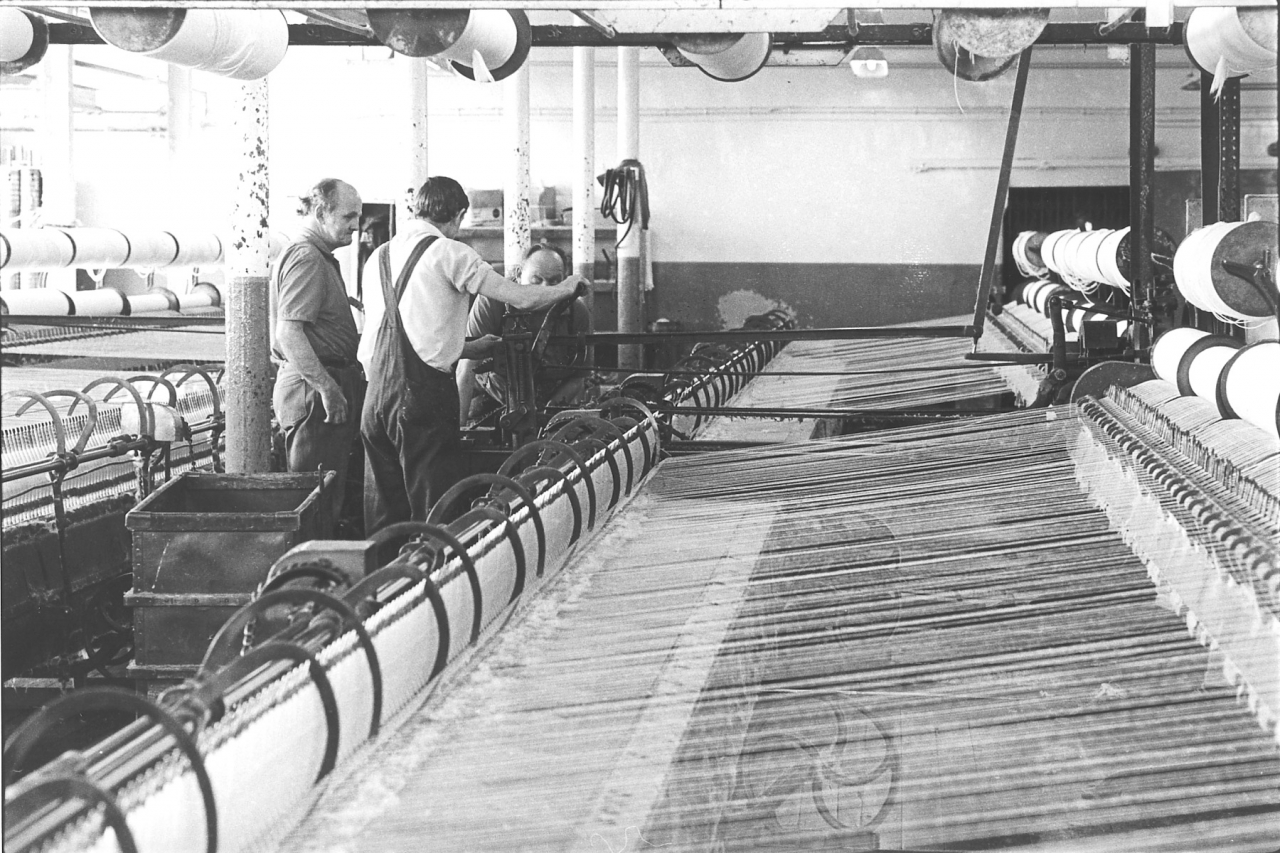
[46]
R- Oh. So now then on 45 they are ready now for doffing and 46.
He was just running in and…
R- No, he was just putting that little bit under the pirn you see, he has got it a bit too slack on 47.
[47]
Aye he said as much yes.
R - So, he has got to take that up before he can start to take all the pirns off.
Yes, he said so himself, so he is taking a bit out there, isn't he?
R- You see, yes, and he is just running them under you see then he is ready for doffing.
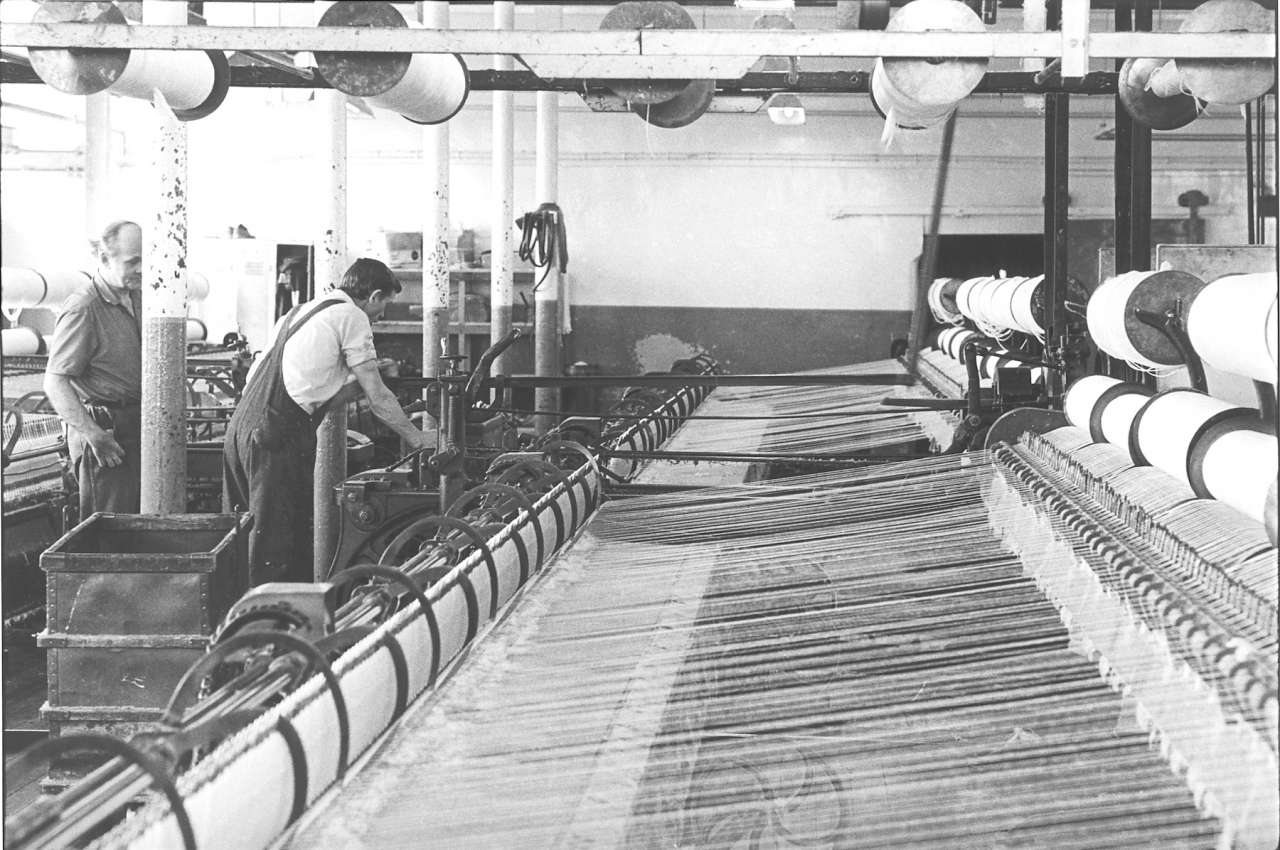
[48]
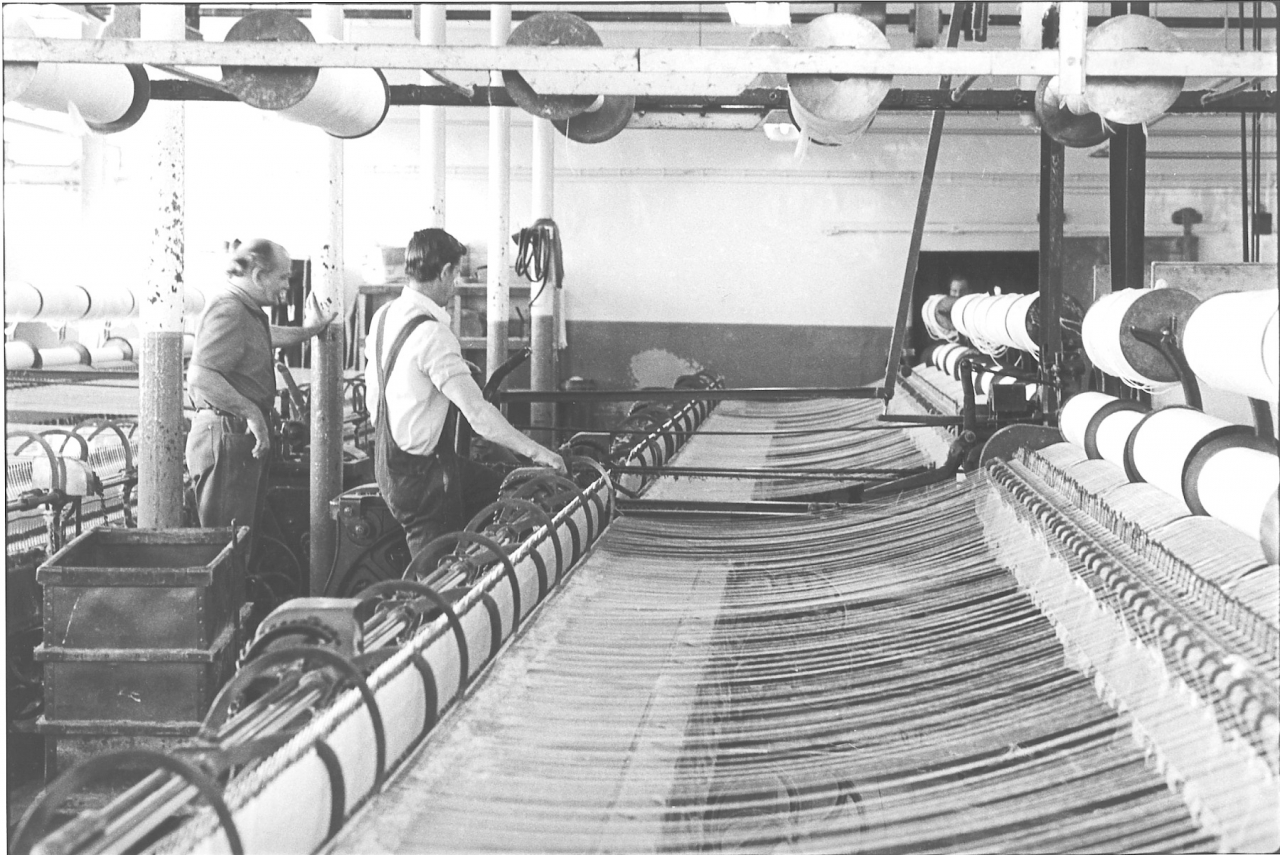
[49]
Yes, on picture number 48, yes. On 49…
R- Yes. Now he is adjusting the take-up you see which is the mechanism that is in the centre of the mule which we know as the headstock and from there, all the motions are controlled.
That's it, yes.
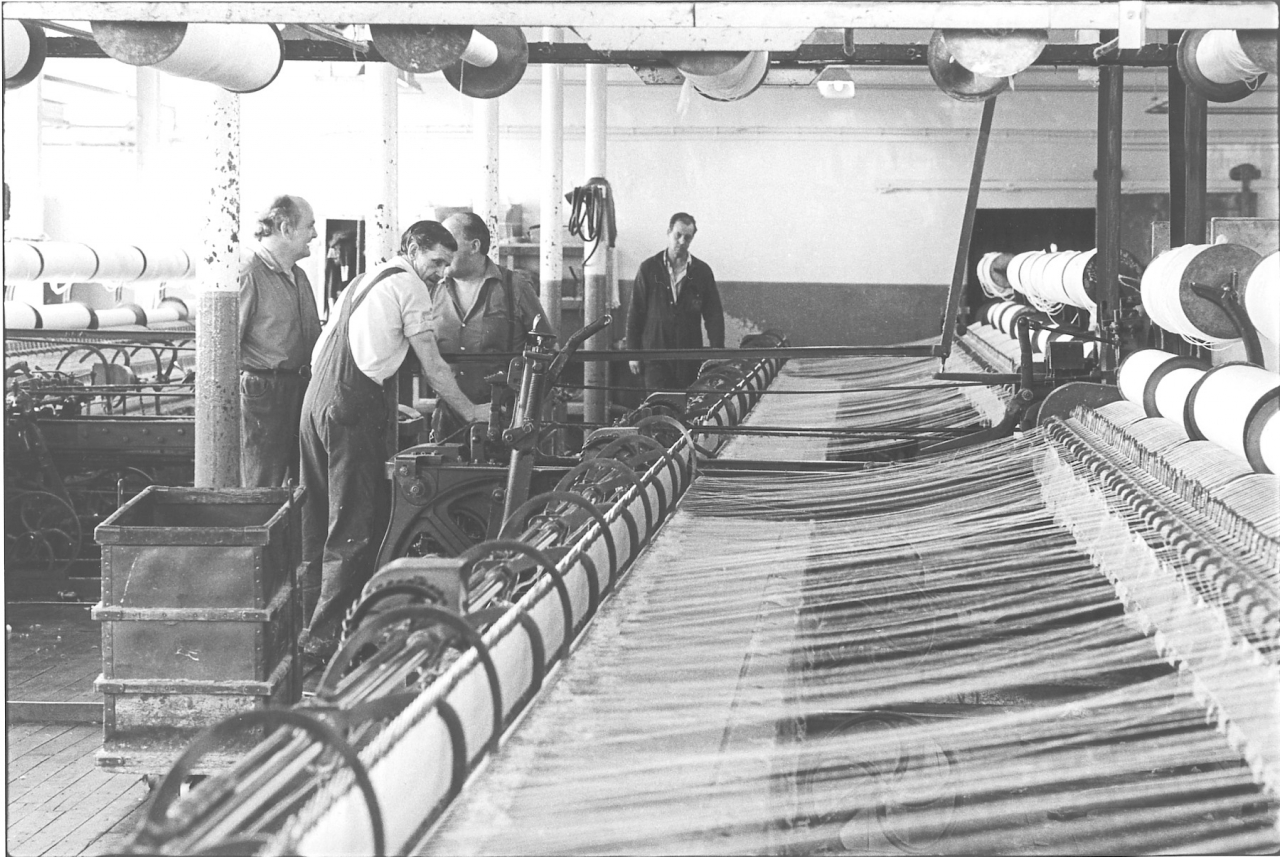
[50]
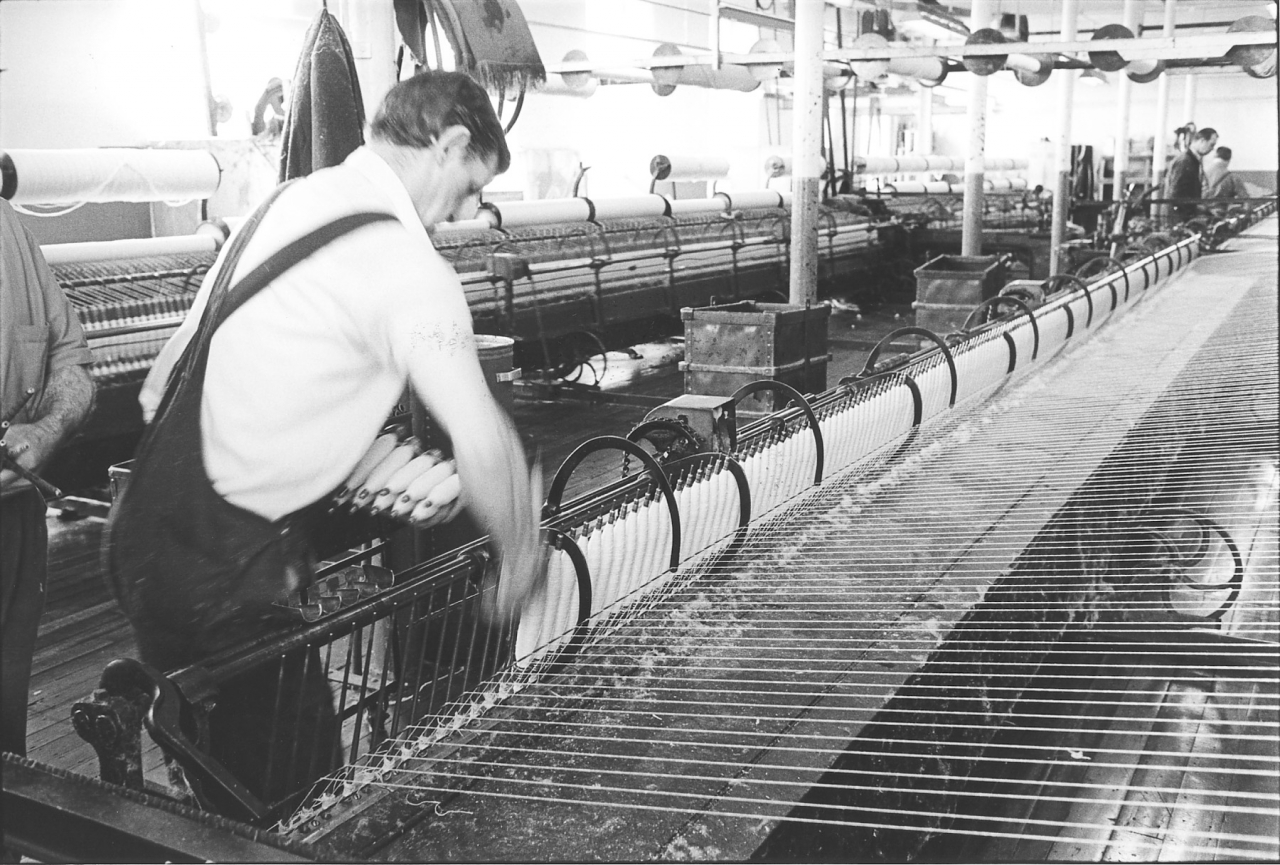
R- Right, now then, on picture number 52 shows him actually removing the pirns from the spindles. You can see that the thread is held on the bottom of the spindle ready to receive the new pirn. Donald’s there putting the new pirns on. This has still to be done by hand. Various methods have been tried, you know, with batteries but due to the differing number of spindles between the sickles they don't operate. And then again, these are metal pirns specially for electric feeler motions you see, on the looms. So that's number 53, replacing the empty pirns.
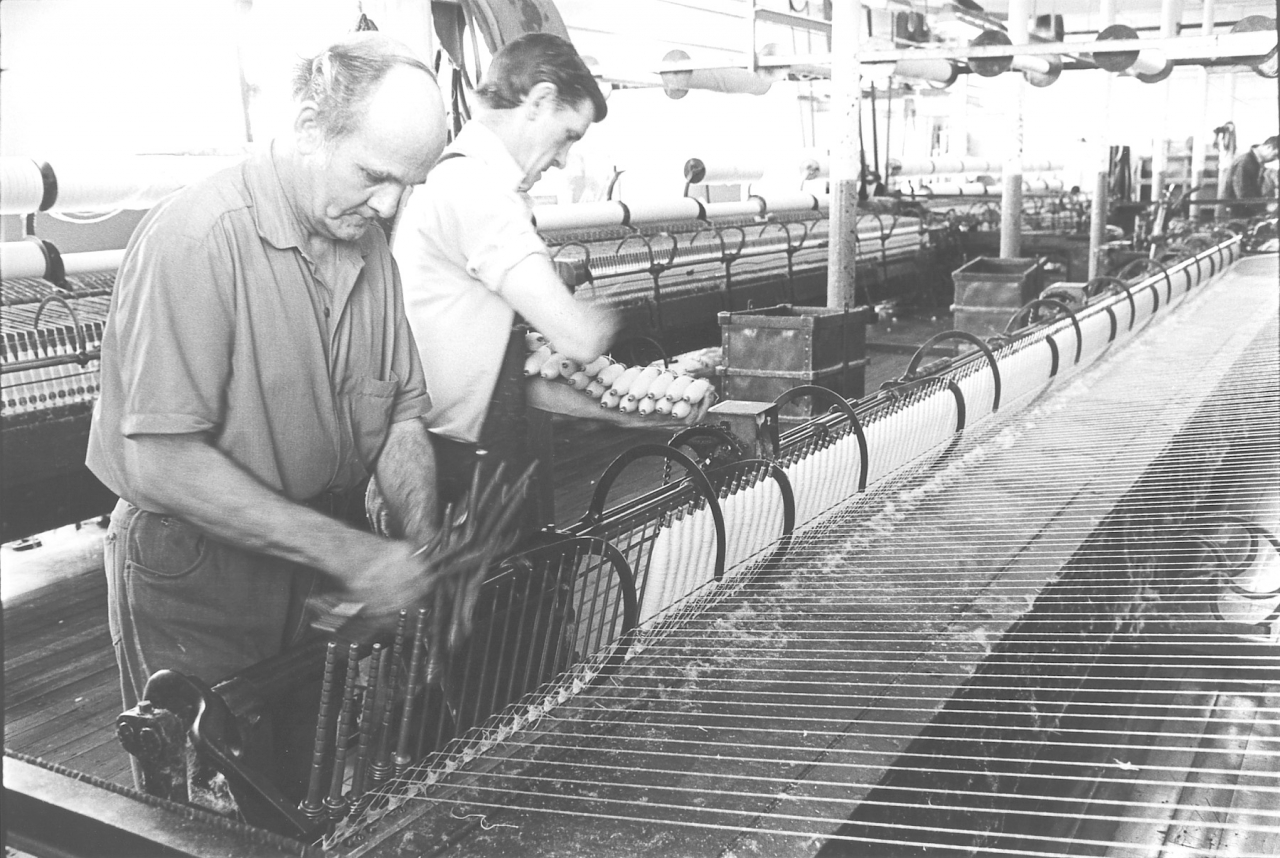
53]
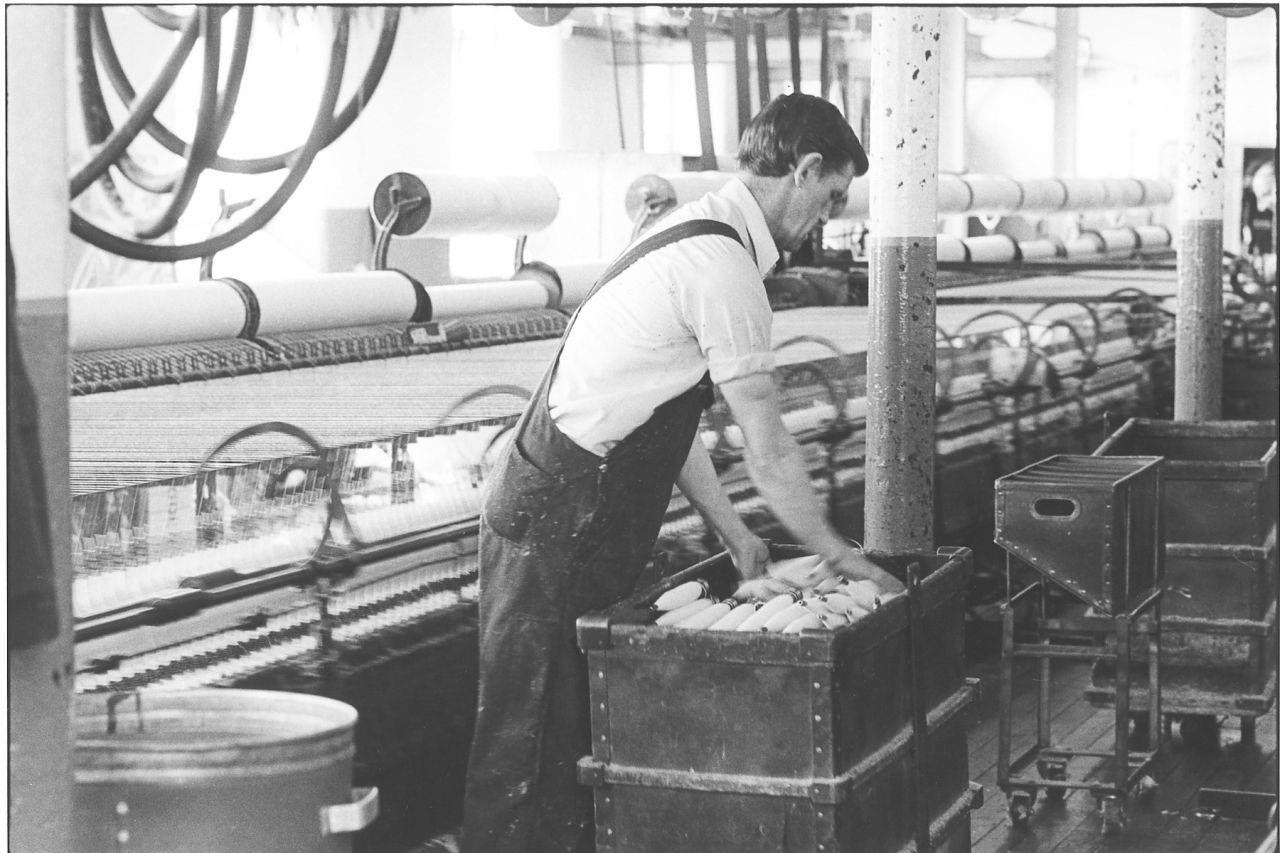
[54]
On 54 he has got his arm full [of filled pirns], and he is emptying them into the boxes ready for transportation. (300)(35 min)
Aye and on picture 54 he is putting them into the box. Aye, he told me that he takes three bobbins at once so that'll be 90 pirns at a time.
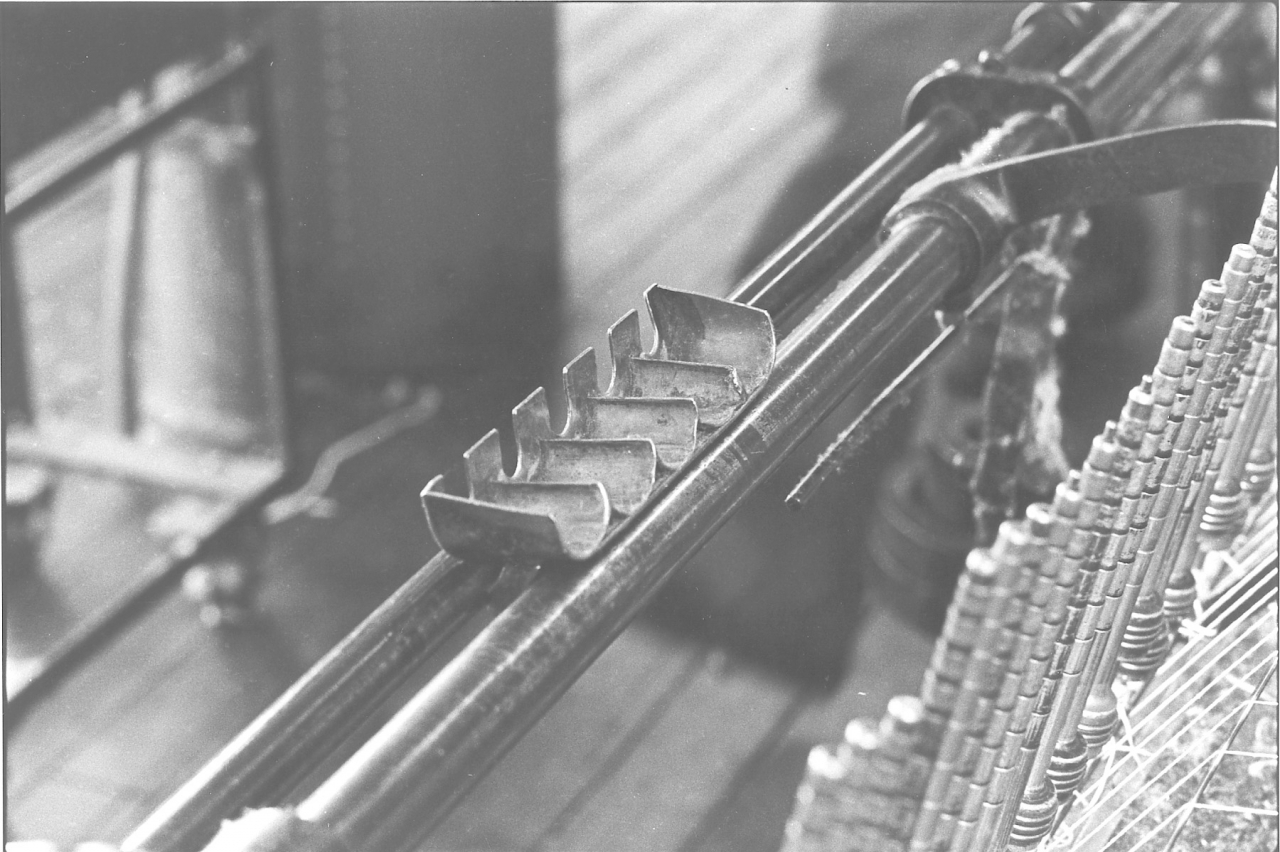
[55]
R- Yes. Now then, on picture number 55 is a little gadget whereby all the pirns are pressed down to the spindle board so that they are all at the same height.
Yes, now that’s very important isn’t it?
R- Oh very. You couldn’t do with one up and one down because the thing is you'd have a, well no end of a barney on the mule, on the loom rather you see. Because you can’t do with the thread under the butt of the pirn because you see they are automatic changes and if there's any obstruction, the pirn is horizontal and it's hit by hammer and knocked into the shuttle. Now that pirn knocking into the shuttle knocks the old pirn out at the bottom. Well now then, if there is any obstruction of any kind, you'd have a real to do. No, that gadget on 55 is for making the pirns all the same height.
Yes that’s it. Now, picture number 56.
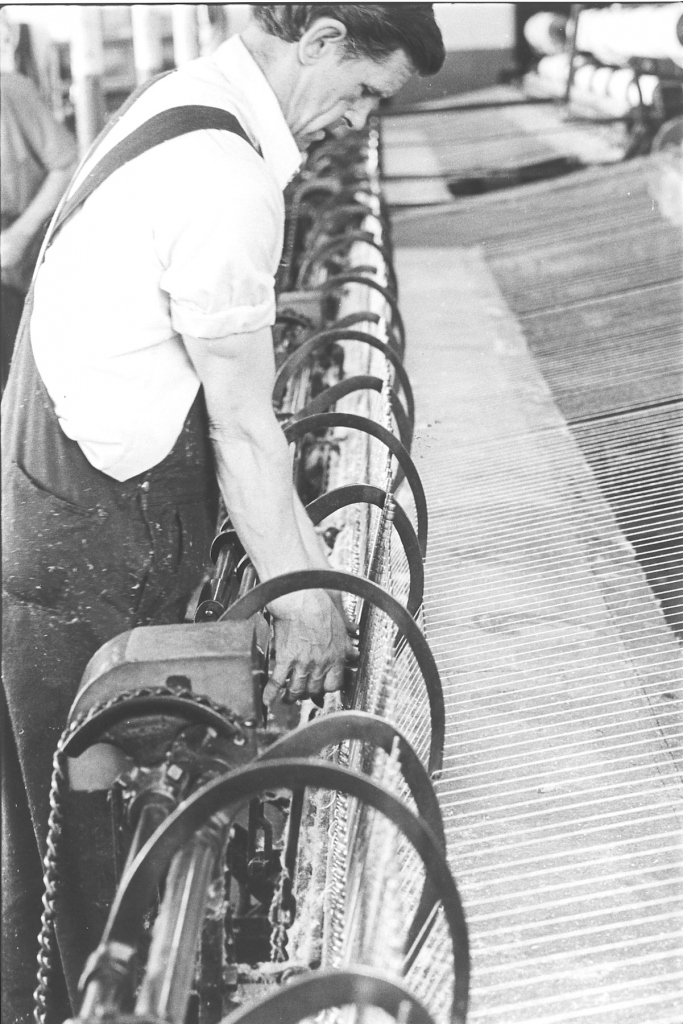
R- Now then, 56, that’s Jim pressing them down so they are all the same height. And picture 57 shows the effect of using that presser.

[57]
Yes, and it also nicely shows the way it's the Counterfaller, the one that's pushed it right down to the bottom. The way the counterfaller has pushed the thread right down to the bottom to get that filled up at the bottom.
R- Yes, that’s it.
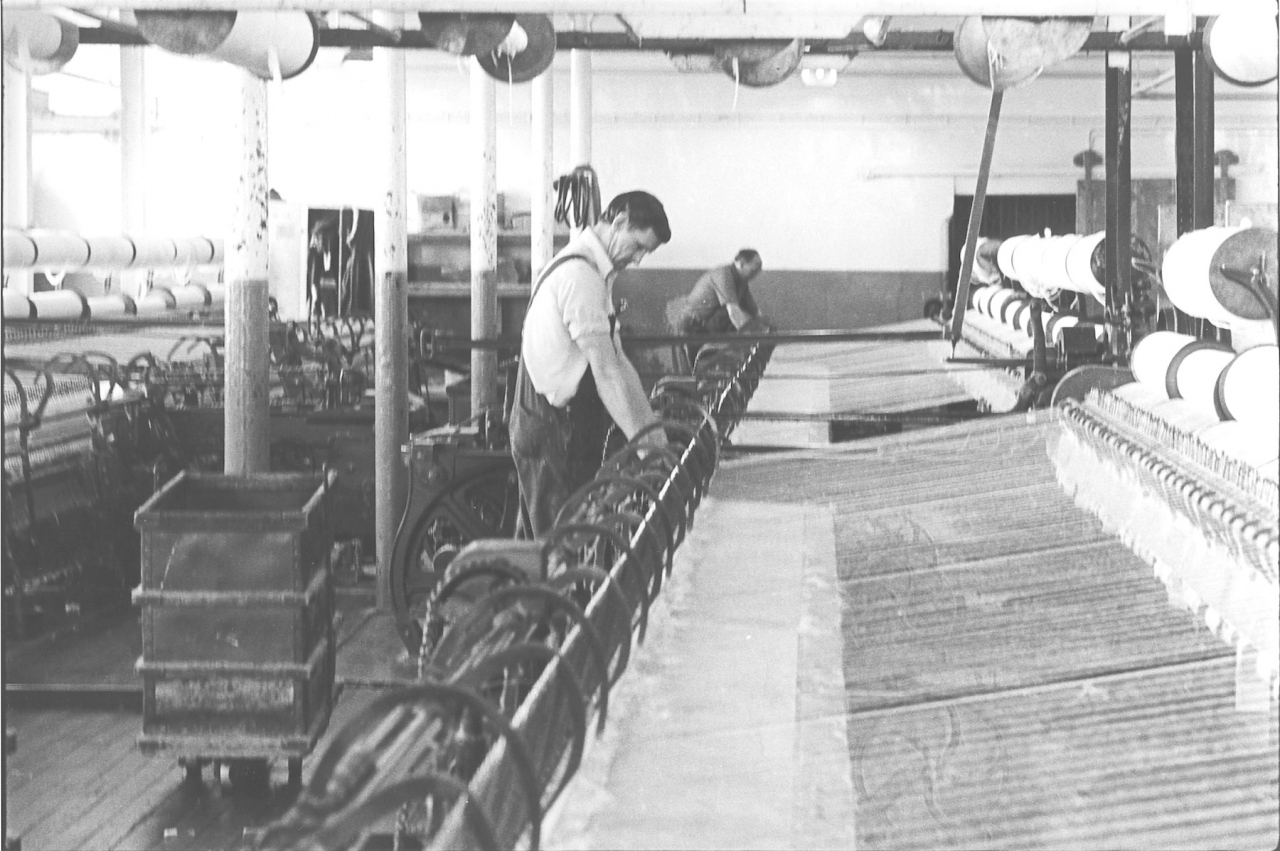
[58]
And on picture number 58 he is just finishing pressing and Tom is up at the top and picture 59...
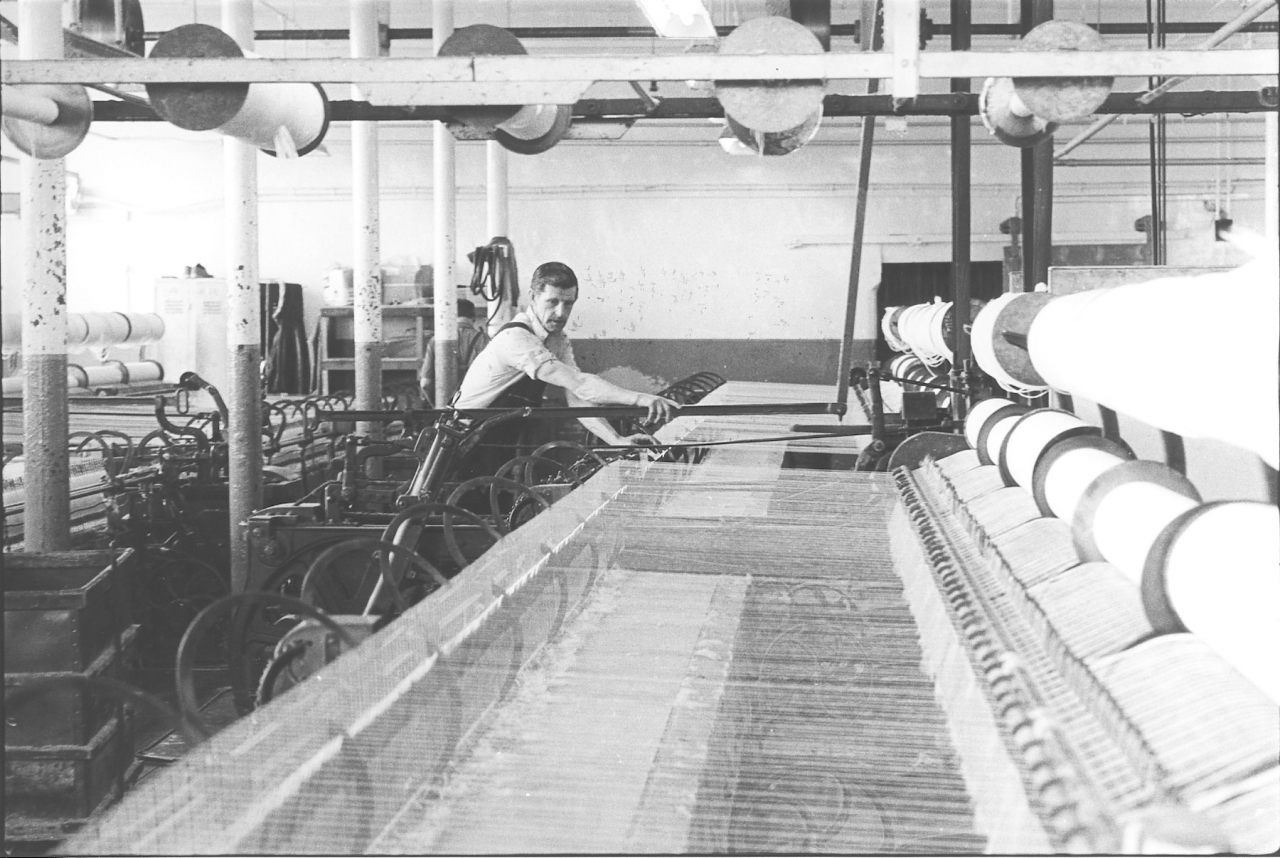
R- Yes. And on 59, they have got to run it in very carefully until the threads get round the pirn otherwise you'll break a right lot down, unless it's done very carefully.
I notice when Jim's doing that he very often puts some weight on the fallers or moves the fallers himself, helps them to move.
R- Well, he does, he is just easing the tension you see. After all, there's a great deal of tension on there, and not a lot of basis to hold it. So he eases the tension, so that by doing that of course it saves him a lot of breakages and then of course they have so much less [downtime].
Now picture number 60. He’s started off spinning now.
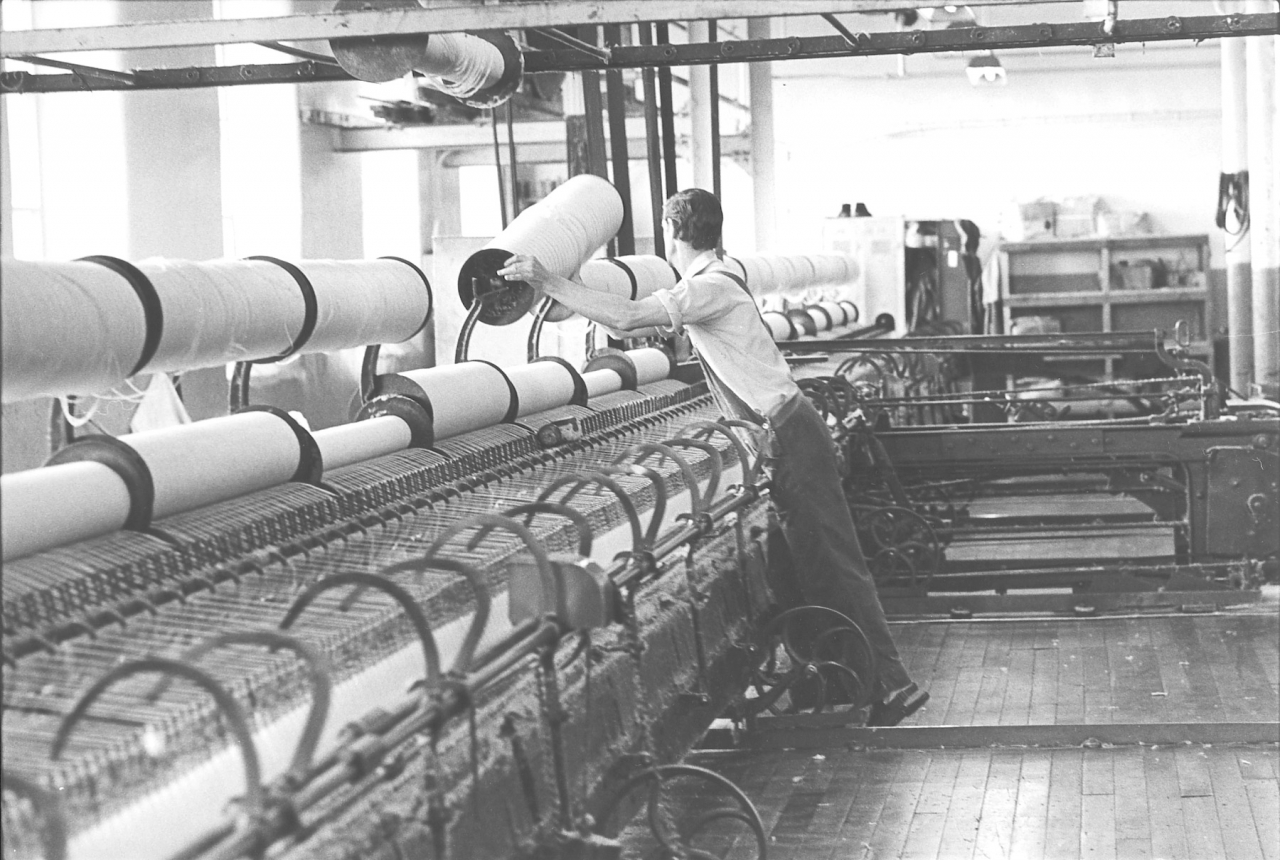
R- He's taken a bobbin off the conveyor coming out of the card room that we saw and he's putting it on the mule creel ready for dropping in when need be. And 61 of course shows him replacing a bobbin. (850)
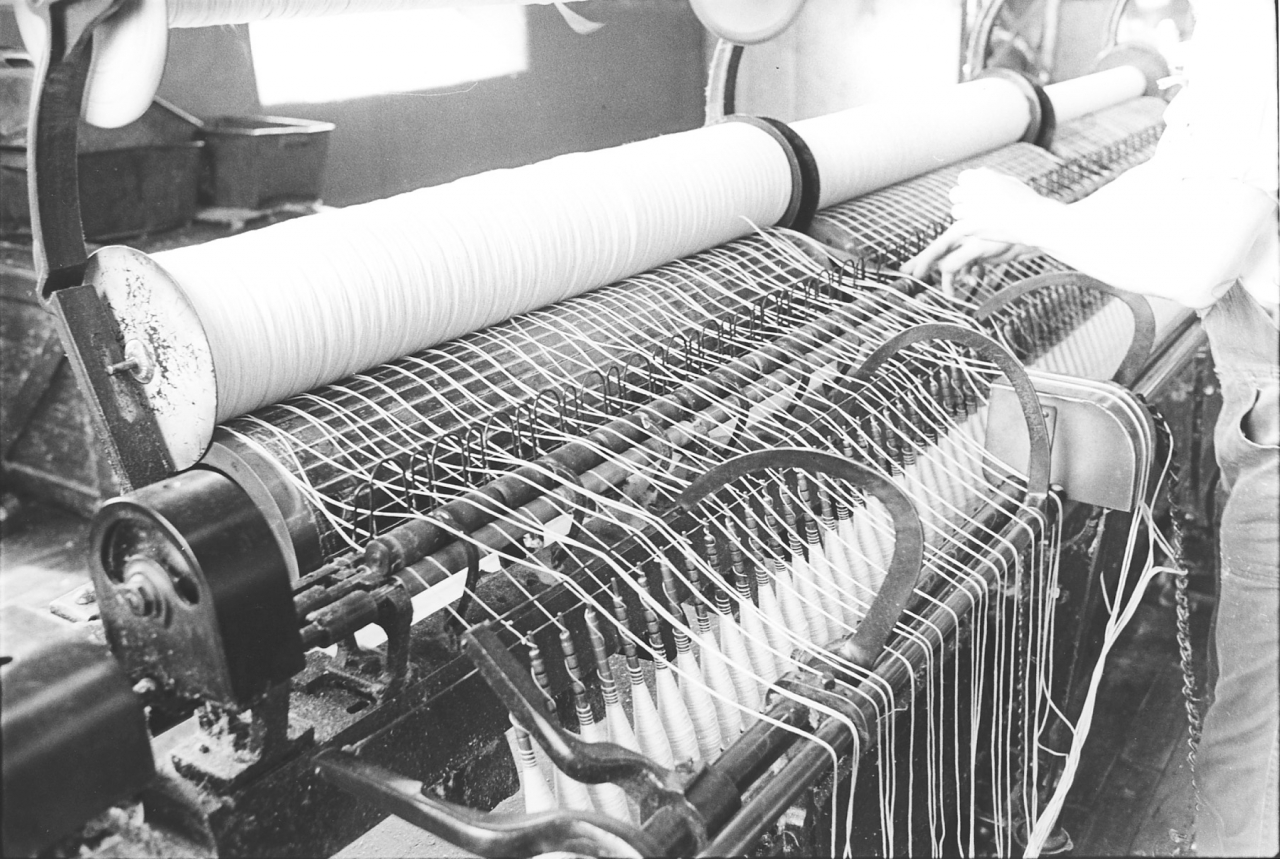
Aye. That’s it. That’s creeling isn’t it?
R- Creeling yes. Only every one has to be put in by hand.
Yes. Well Tommy came down to give him a hand. That’s it, yes. [62]
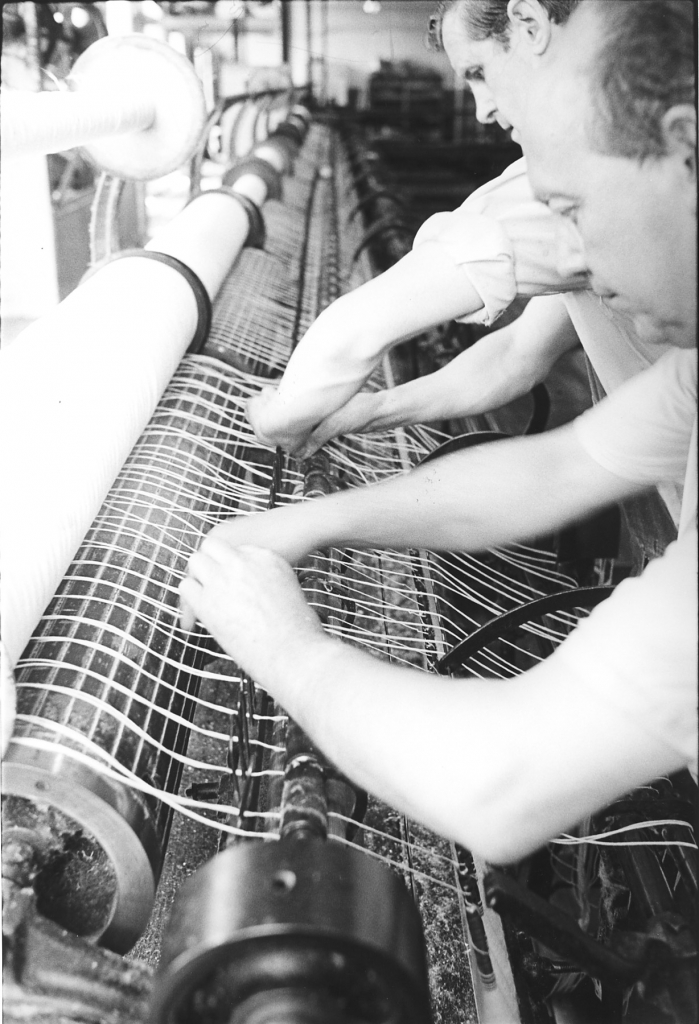
[62]
R- Oh well this is, you see when the wrong piece, there's a great deal of understanding and co-operation because if your mate doesn't come, it can take you longer and you know they are paid the number of times that mule goes in and out you see.
One thing I noticed, while they were on John, was the fact that all the end rovings are crossed. Why is that? The end ones.
R- Oh, the end ones?
Yes, the end ones, they always cross, the one on each end of the bobbin, the two end ones, they cross them.
R- Well, that is to pull it away from the edge of the flange. You see the thing is if it was coming over here you see, you can see that would be constantly getting nicked down there.
Rubbing on the flange. Yes.
R- So they always cross them over, so that it's drawn off, away from the edge of the flange, you see?
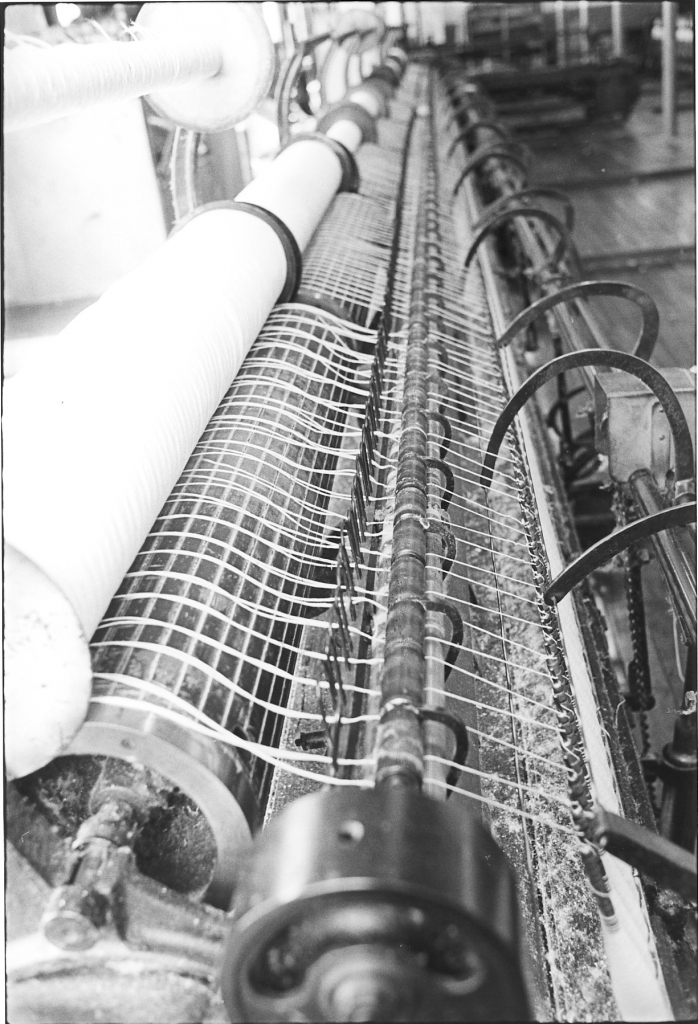
Yes, yes, with you John, with you. So picture number 63. That's it all set up again ready for…
R- Yes, ready for going.
And of course the actual twist is put in in between the guide wire and the roller isn't it, when the actual piece, the…
R- Well they are only, yes, yes, aye.
When the main one ..
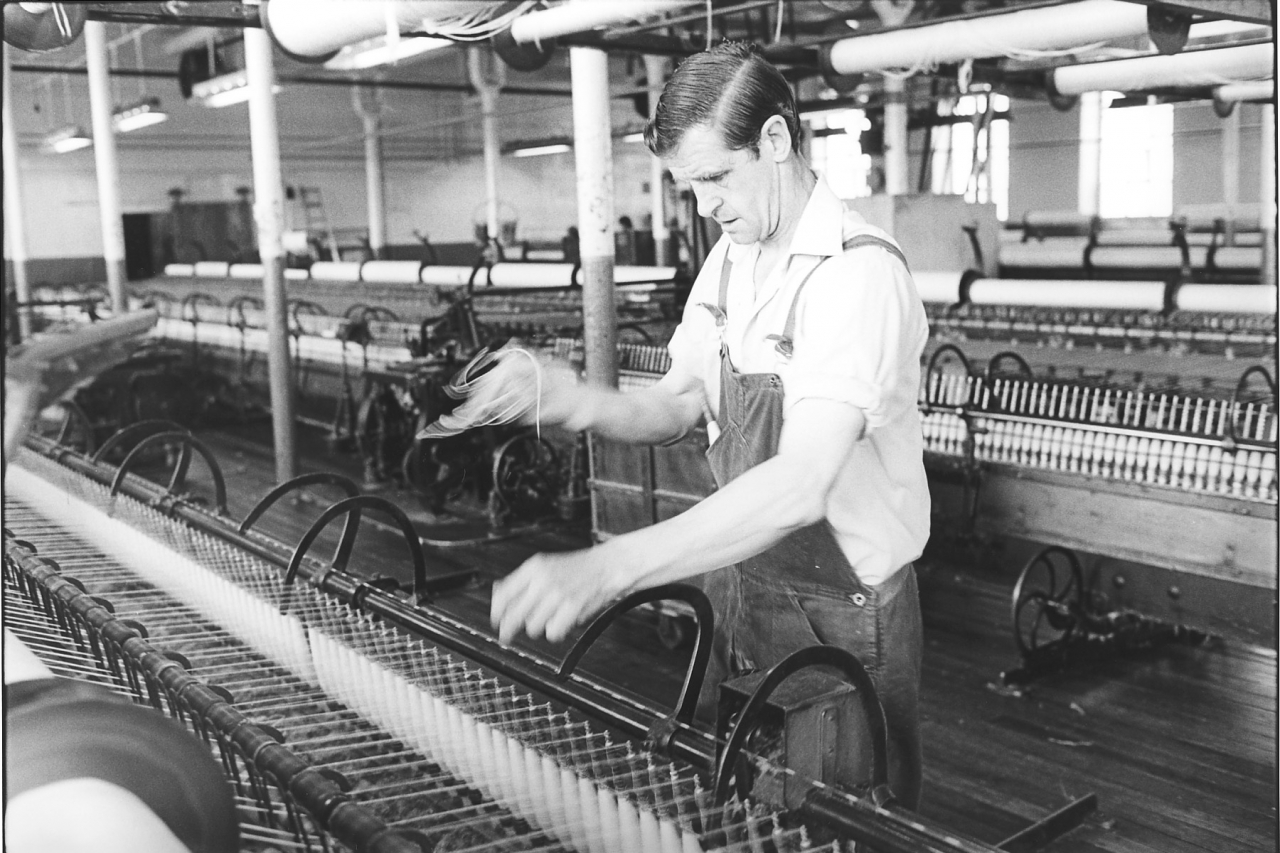
[64]
R- Aye. Now then, 64, there’s Jim, he has just pieced an end up and he is gathering up the waste. Now you see, the thing is that if an end breaks down it drops on to the carriage does the material. It still keeps delivering you see while it drops on the carriage. Now you see…
Yes. That shows up clearly further on.
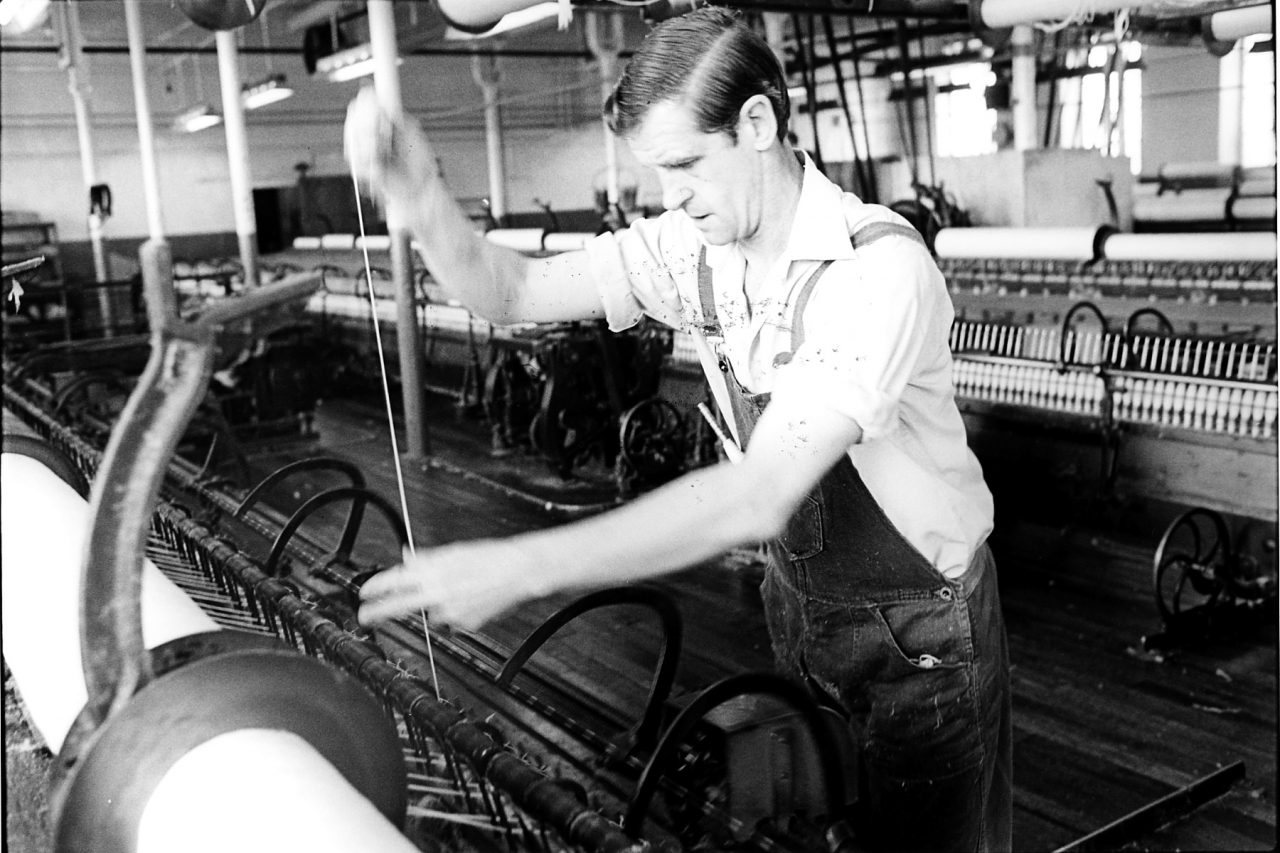
[65]
R- In picture number 65 is Jim pulling it off the…
Yes, he’s just going to make a piecing. Now that’s the only time he can make a piece? When the carriage is right up to the creel isn’t it, when it’s right up there?
R- Oh no. He can piece up as it's coming out but you aren’t supposed to piece up when it’s more than a third of the way out.
Yes that’s it because that's when the twist starts isn't it. The main twist, yes.
R- Because they well, I mean the main twist. It is twisting all the way but the thing is if you get it more than a third of the way out it makes a soft yarn and when it gets to the loom it'll break. You are not supposed to do.
Yes, soft yarn, that's it. Now he was, this series of pictures, I know you haven't had time to really look through them all this afternoon. This series of pictures, now really there are about six pictures showing, he had a had cop and he had to take it off and then of course he had to level it up. And these pictures are showing it, so that you can describe what he is doing here John. He had one end go down, but it was a bad cop, and he had to take the cop off.
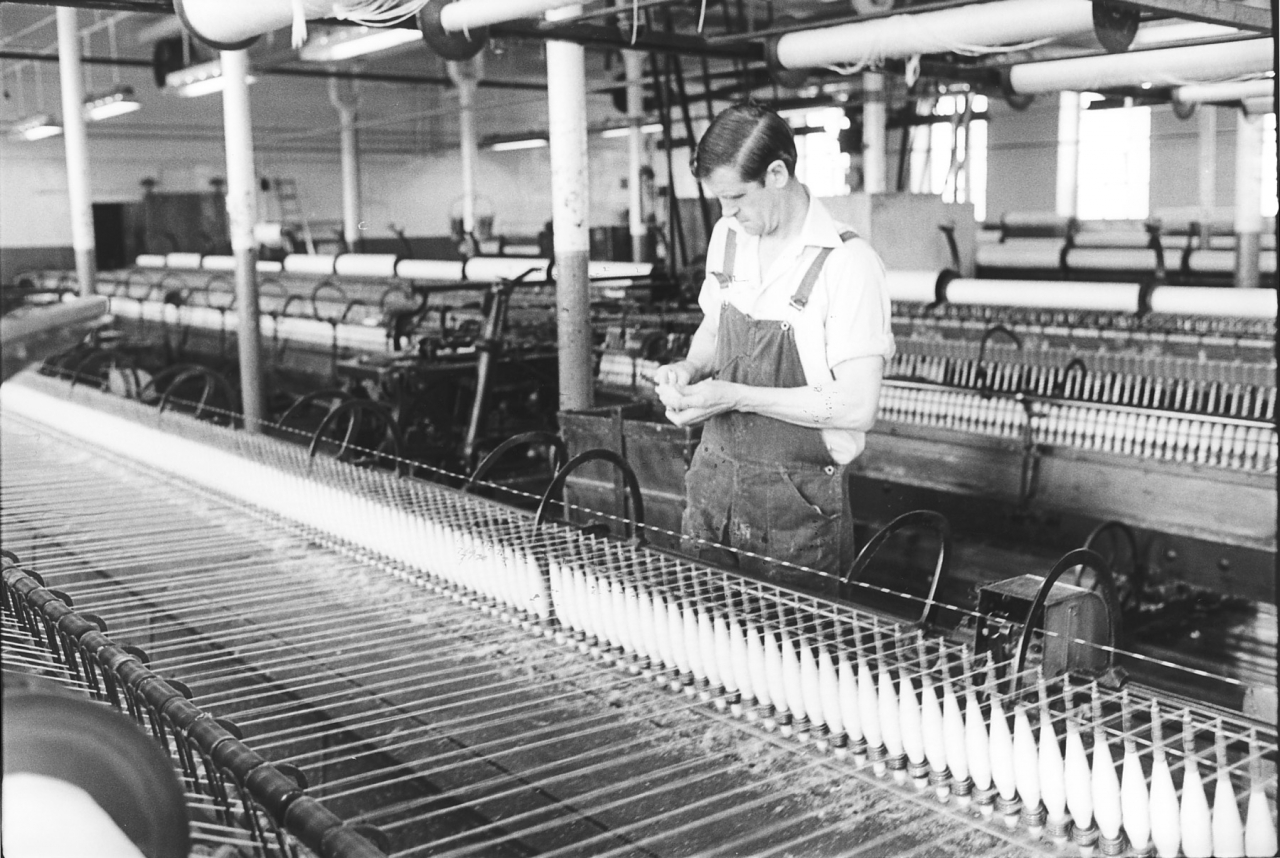
[66]
R- Well, the thing is that what's happened it's happen been down for say a few draws. Well in that case the pirn has got to he brought back so that it’s level and there’s no nick in it. So that he’s probably, or again you see the material’s happen broken down, and the pirn has picked it up.
I think that was what happened, yes. (900)(40 min)
R- You see? And with the revolving action he picked it up of course and he's got to straighten it out then because you can see on 67 he is replacing the pirn you see but by virtue of his eye he won't push it quite as far down ...
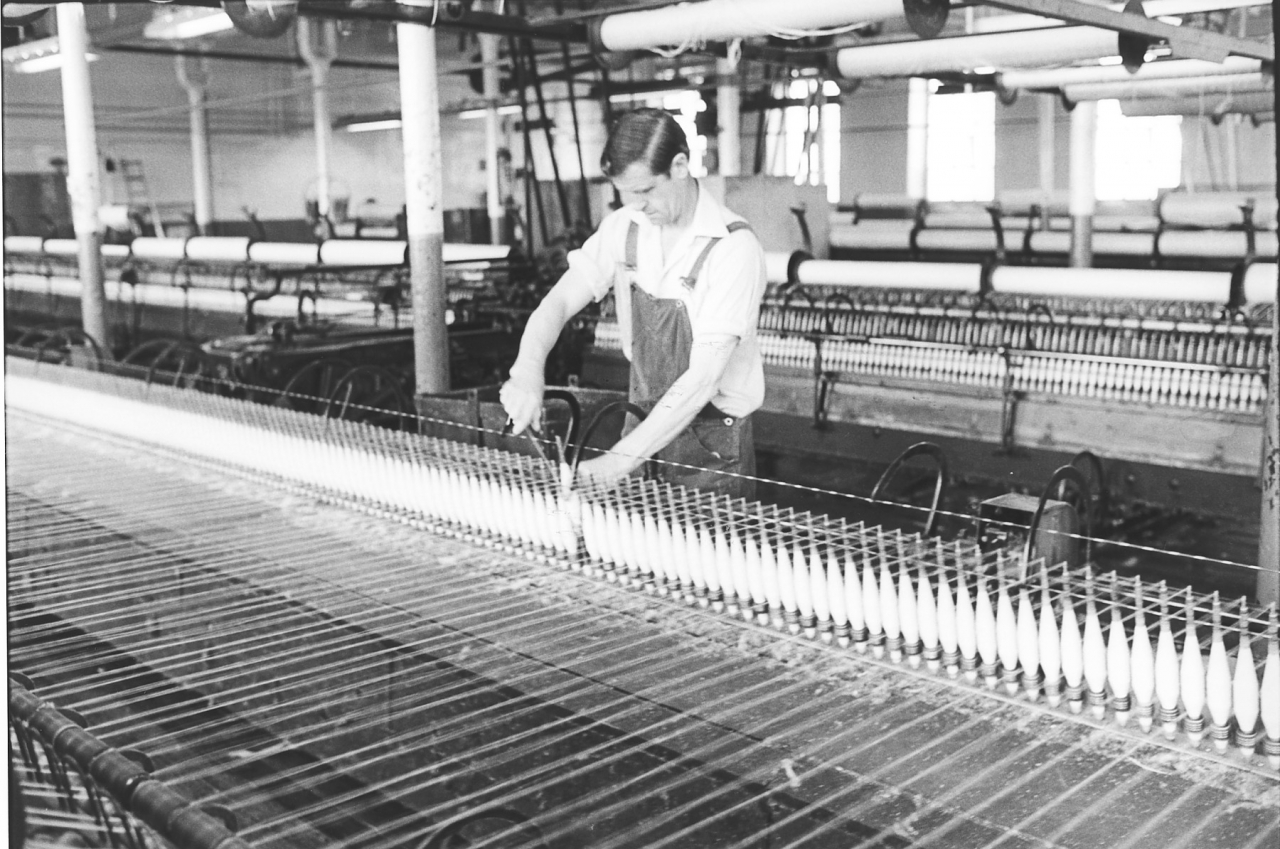
[67]
That's it yes.
R- And then there won't be a nick you see?
Yes. Picture number 67.
R - Otherwise in a loom, if there was a nick in, when it came to there the yarn would be slack and all come up at once. In other words what we call a slub.
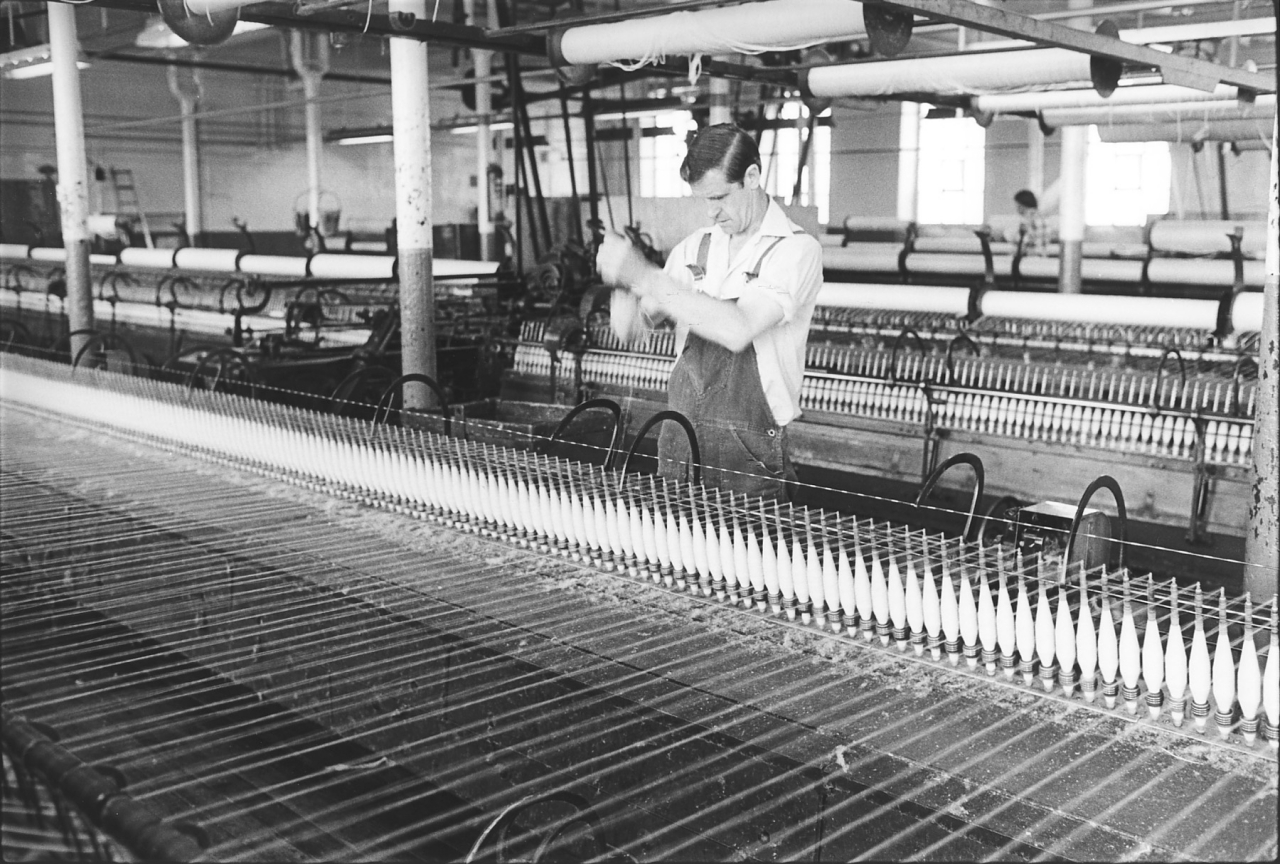
[68]
Yes. Now, on picture number 68 we can see that he has put it back on and he hasn't pushed it right down has he, it's stuck up a little bit.
R- Yes. He’s just a little bit higher.
That’s it and on 69 he’s still drawing it off.
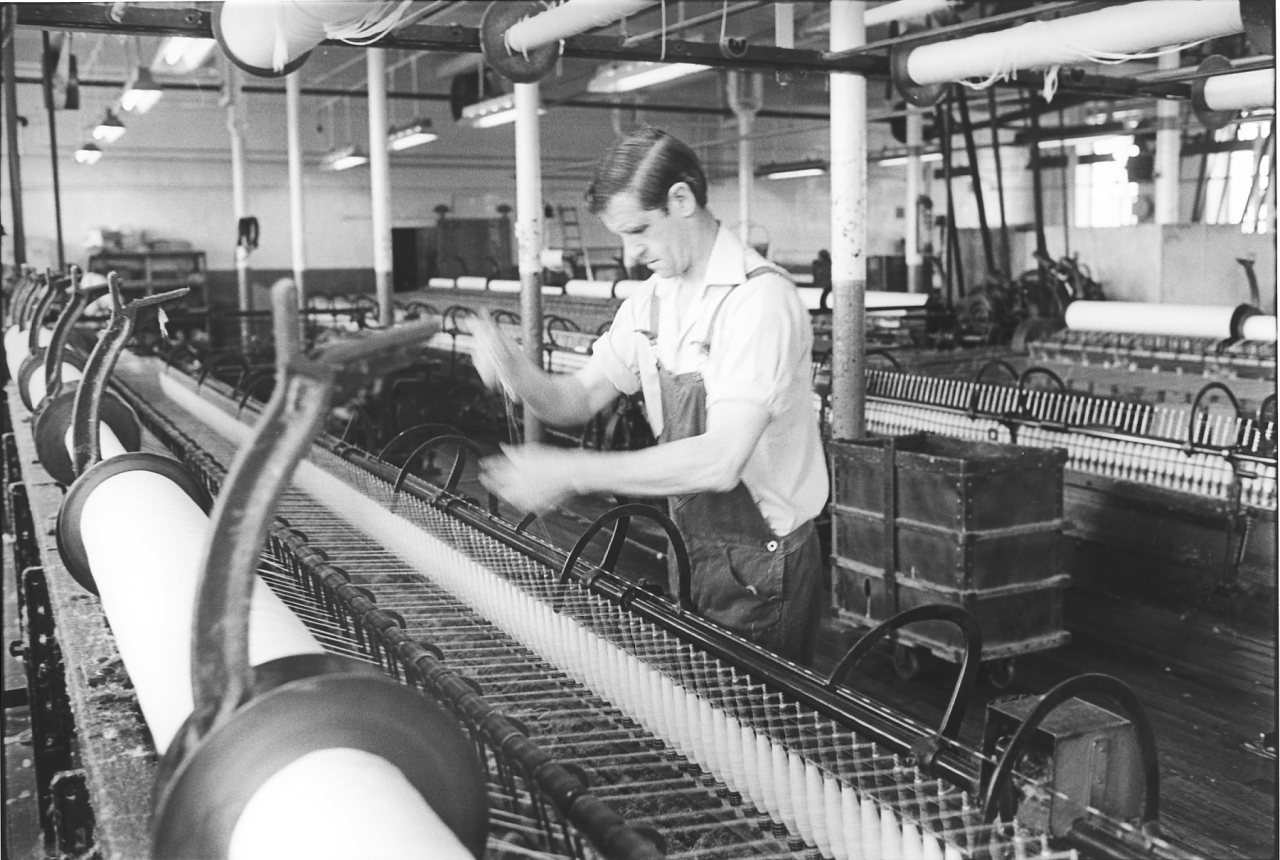
[69]
R - Oh, because he was a bit too high. You see, he was a bit too high and he must have it level. Otherwise if it's too high it'll make a lump on and again that's more or less fatal to the shuttles
That’s it. Yes.
R- Because these things you know, these shuttles are kind of tapered, they are not tapered, that’s the wrong word but they're so hollowed out just to take the pirn and no more. Because they are made to a specific size are these pirns.
Yes. And on picture number 70 we can see the roving gathered on the carriage.
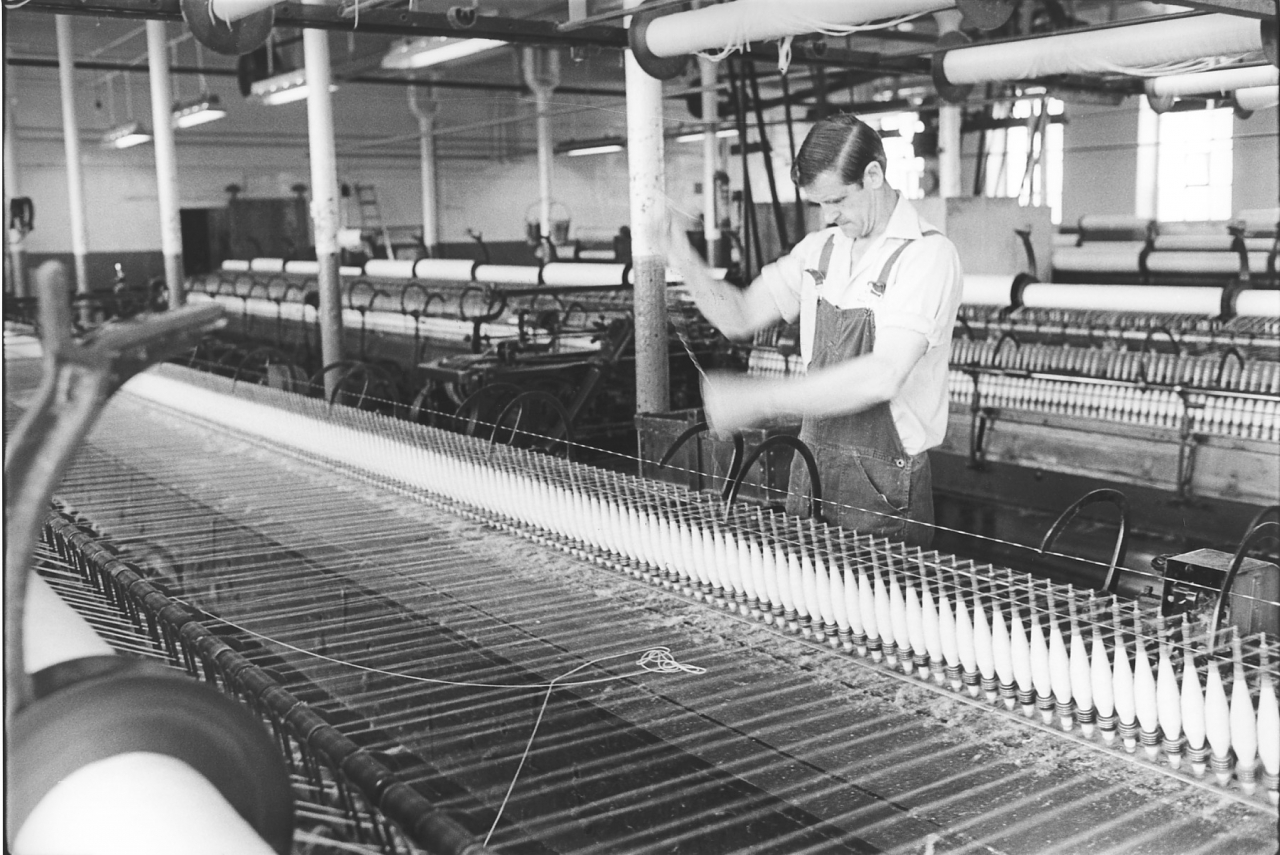
R- How the roving gathers on the carriage, yes.
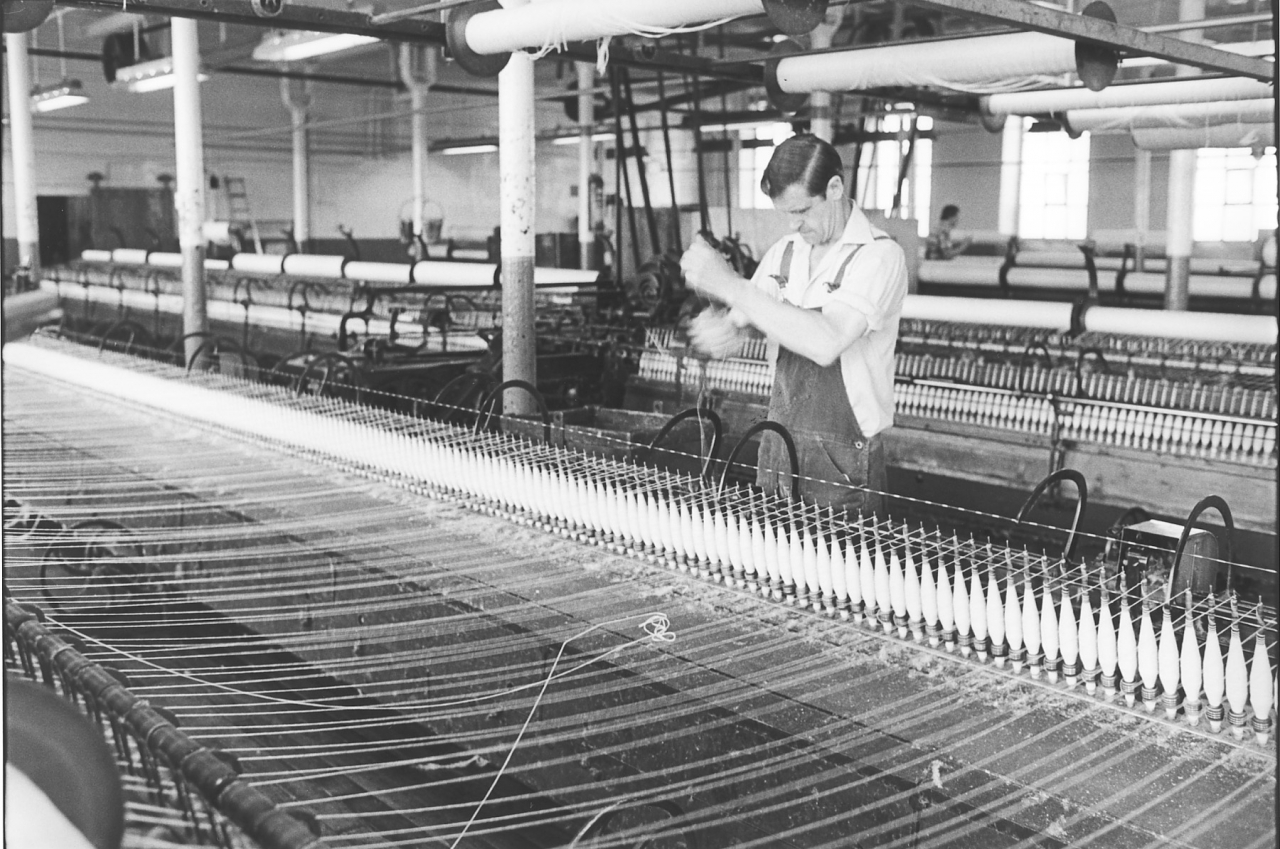
[71]
And he was, and 71 he is still drawing it off, that was a bad cop you remember and we were on about it at the time, because I asked him why he was taking so much off. And there was a fault in that cop, he didn't like it and that was why he drew so much off.
R- Well the thing is it would be another cop that he had by him. Because I don’t know if you can see any…
That's it. Yes it was.
R- We do keep one or two bits, yes.
It was, yes you are right John, it was.
R- He keep one or two bits so that if there's, you can see one on that faller there.
Aye on 71. Between the two…
R- On 71 and on 70. You see, they keep them little bit spare or they may have them in one of these tins here and then he digs one out and it makes a perfect cop as against the bad one.
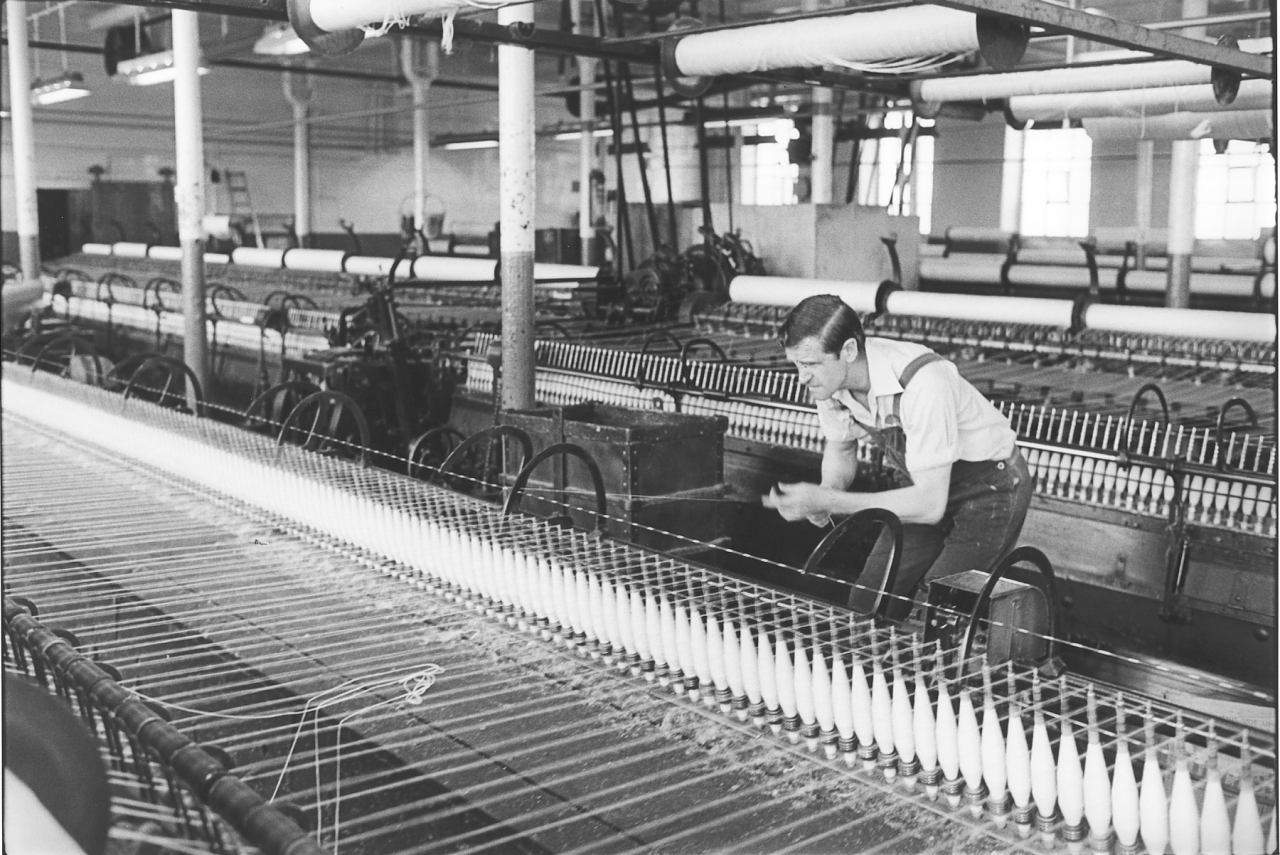
[72]
Yes. And on picture number 72 he's looking to see if it's level there isn't he? On 72?
R- Yes. Aye, now having satisfied himself on 73 he is proceeding to piece up.
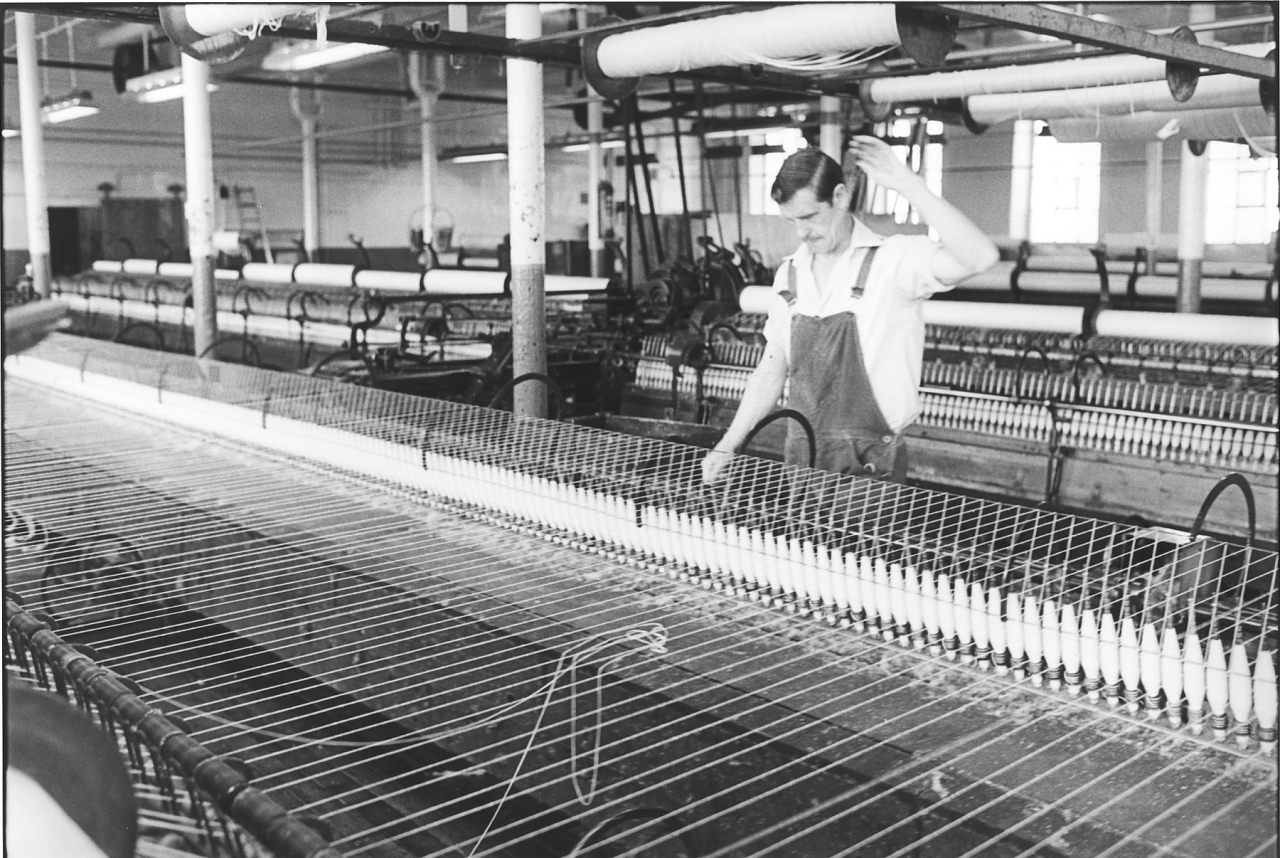
[73]
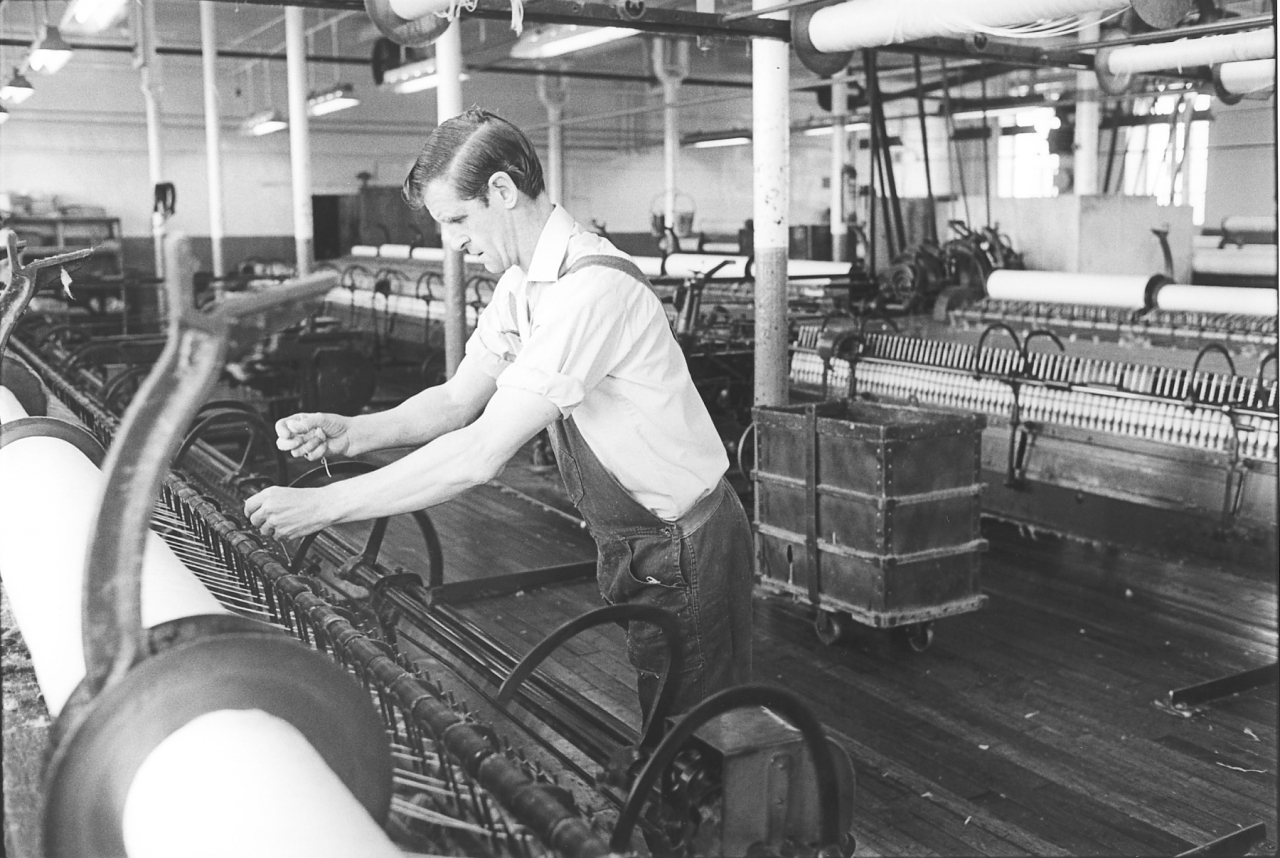
[74]
Yes that’s it, on 73 and 74.
R- Yes, shows him actually on the job.
Yes, and 75.

[75]
R- So he is piecing up not more than a third of the way out.
Yes. Aye, so pictures 75 and 76….
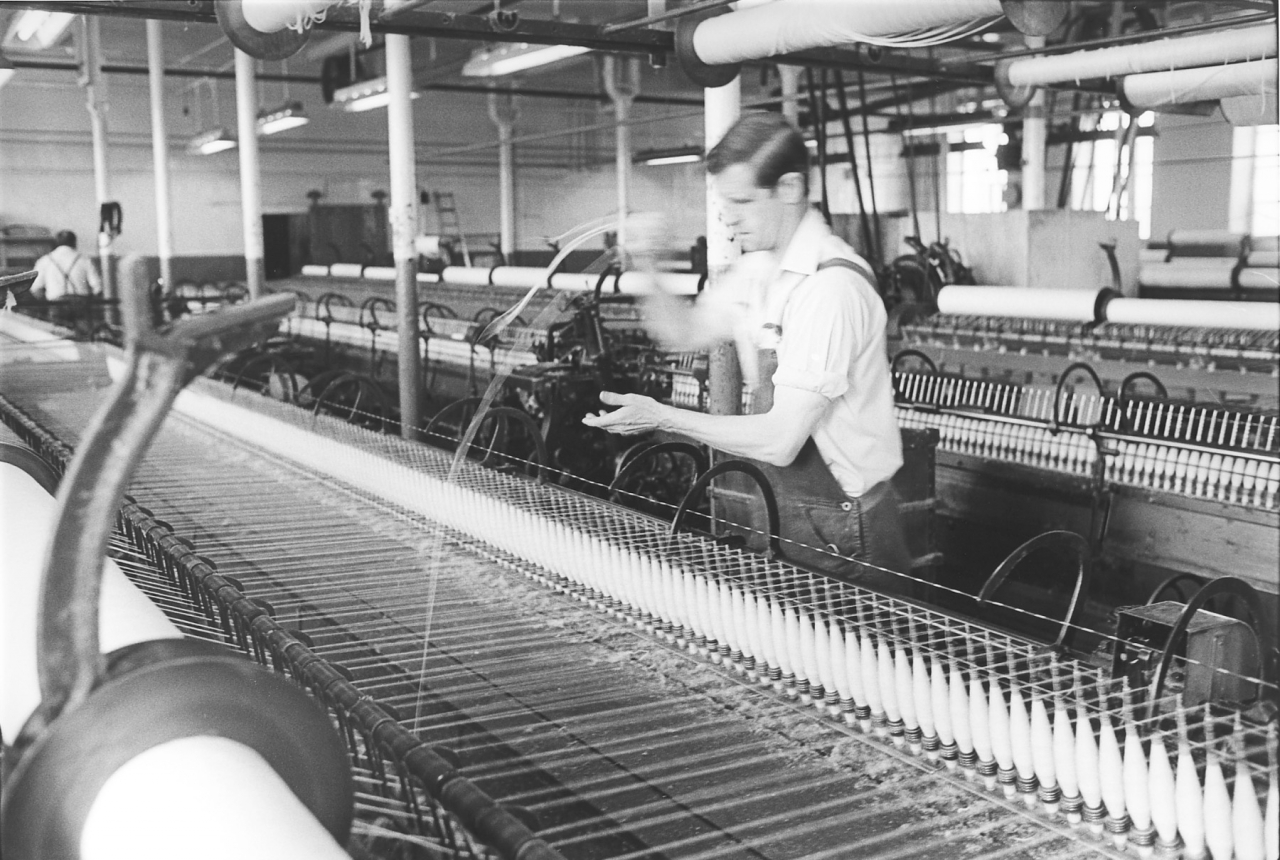
[76]
R- He is taking up the waste like a good spinner.
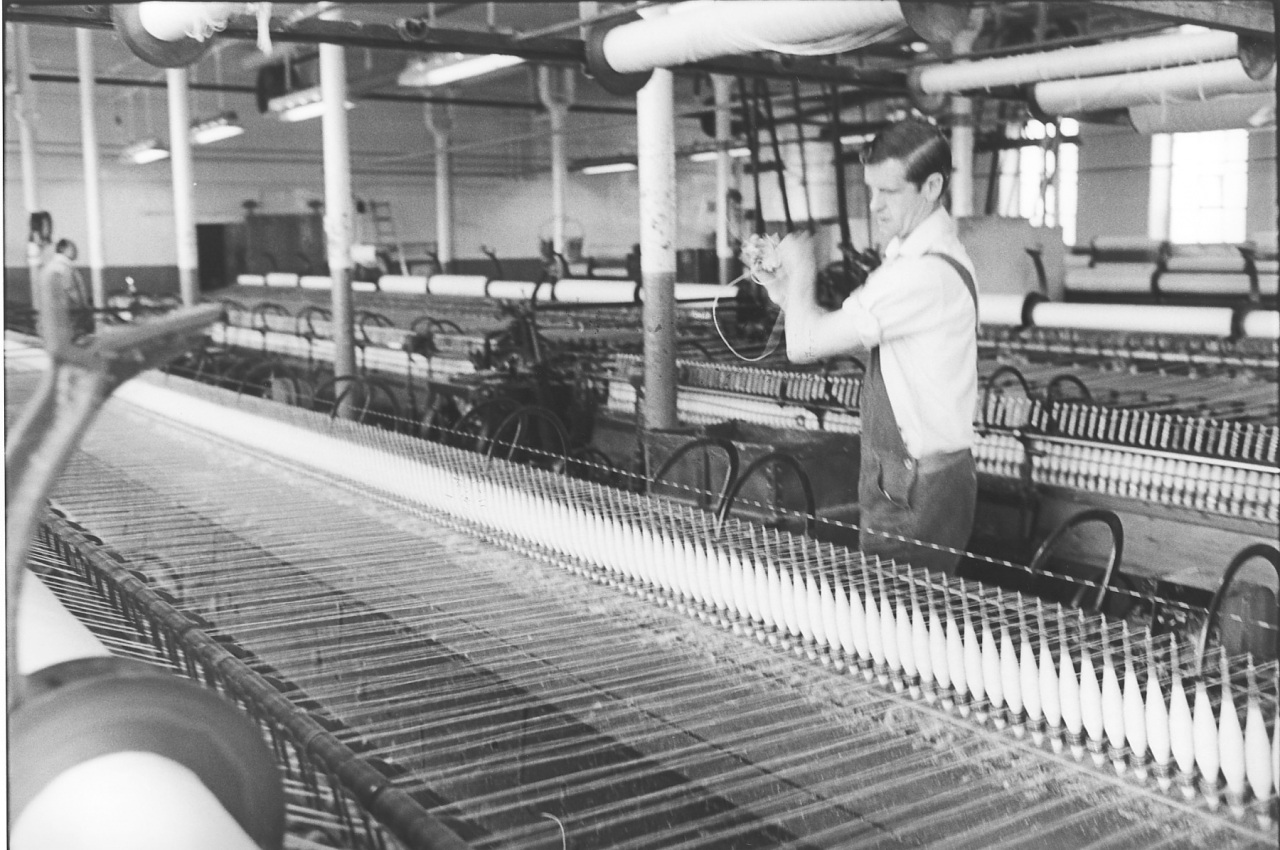
[77]
Aye. And on 77 he’s balling it up. What amazes me John is how Jim can pull up a great long string of waste like that without it twisting up amongst all the other ends.
R- Aye, that’s a, I was going to say an art but it’s something that you learn, it’s a knack you know. In other words you have got to pull it exactly vertical. If you deviate to one side or the other it'll twist in. (950)
And that of course will bring a couple more ends down, or at least one or two and you are just wasting time and away again.
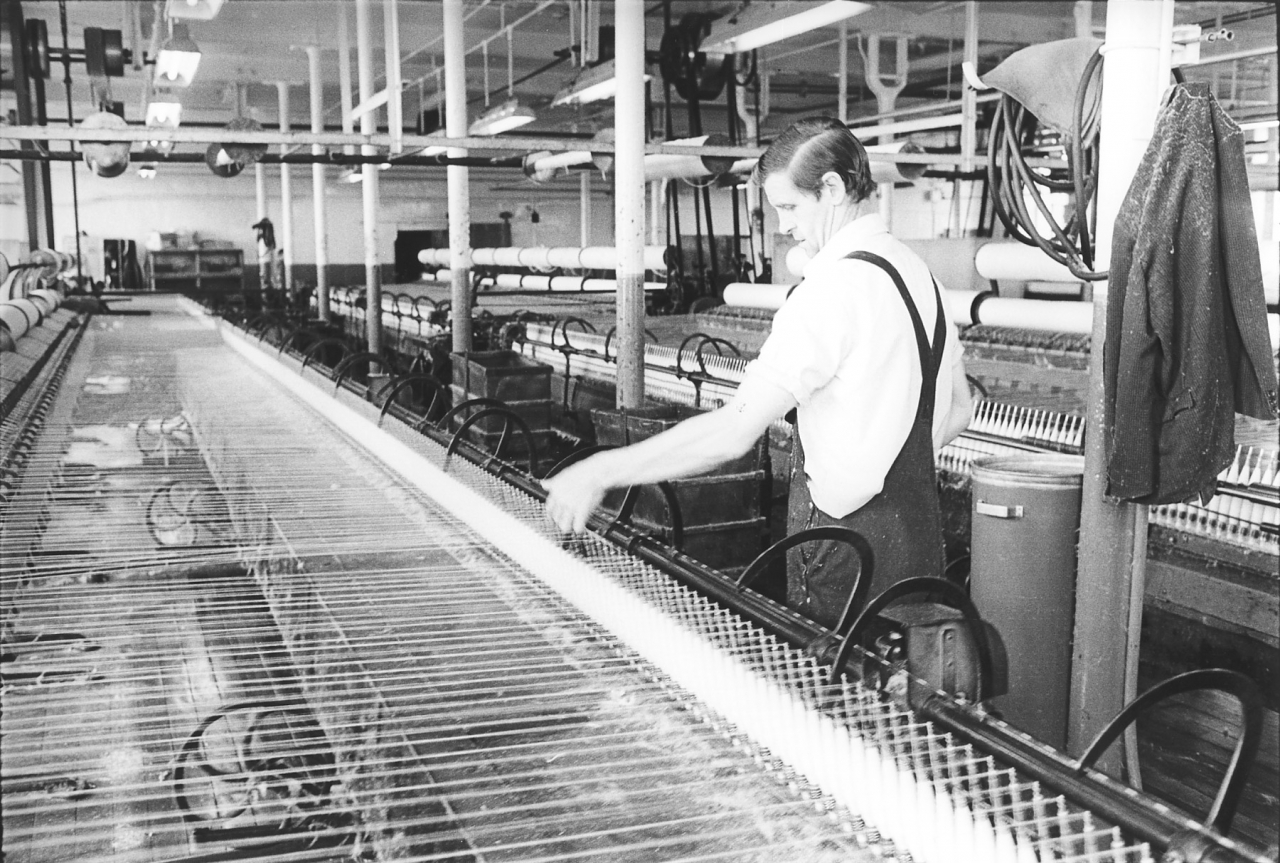
[78]
R – Aye. Yes, now on picture 78. You see what happens is when you have pieced an end up, they do tend to get a little bit tight do the threads and when the fallers come down you know, that little bit of extra tension, it's the last straw that breaks the camel's back and it breaks it. So what he does, he just eases it just a fraction, not supposed to do but he does see?
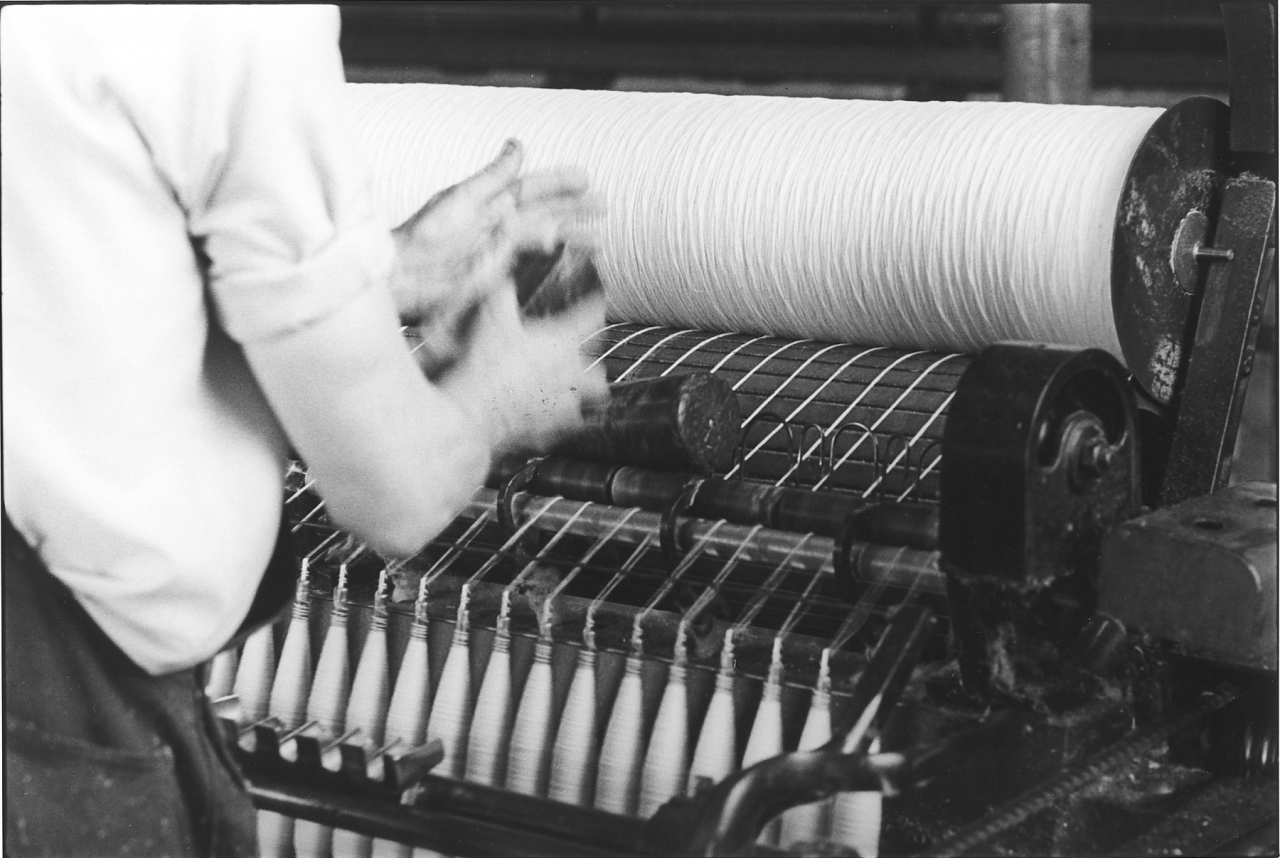
[79]
0079 Now then, the thing is that the rollers themselves consist of two steel rollers and a line of leather rollers. Now, the leather rollers tend to pick up little bits off the yarn as it's going through. And we have what we call a clearer. And the clearer is propelled along by the torpedo shape. You see, by virtue of being a cone, it carries round, and it pushes the block.
It's an amazing idea, amazing idea that John. I love it, I love it.
R- The block has of course a piece felt underneath, and it's cleaning the rollers as it goes along.
Yes. This is picture 80, he's just cleaning the block off with his hand.
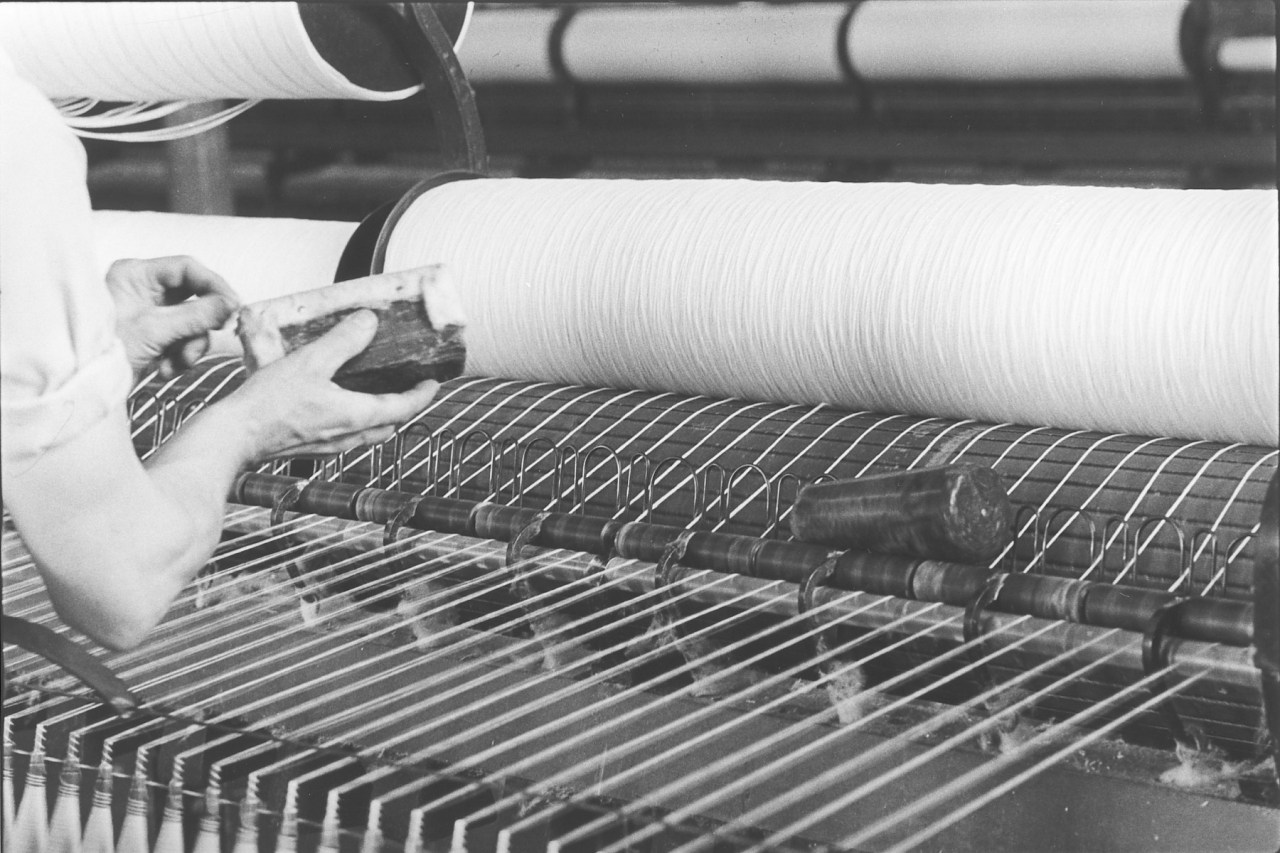
[80]
R- Well. The thing is when it gets to the end you have to reverse them you see. So he's just cleaning the block off now and reversing it. Now then you can see the block on 80 where he is picking the little bits off. Because if he didn’t pick them off when they got so big they'd fall in and be wound in the yarn and make a slub you see.
Yes. And picture number 81?
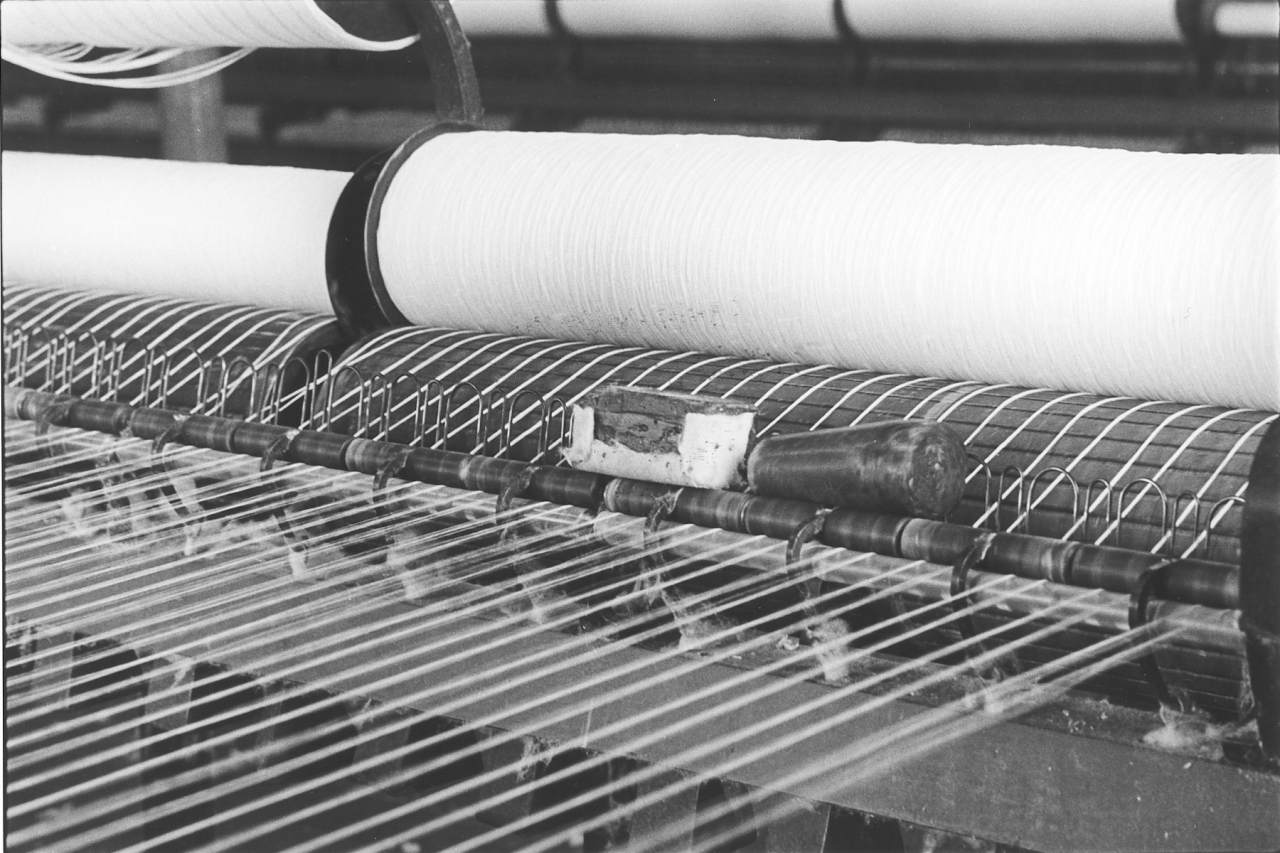
R- And 81 actually shows the clearer in progress.
Tell me something Johnny while we have got a clear picture of the rollers there. Do those rollers actually draft, do they draft?
R – No. The thing is that there's no roller drafting because there are only three rollers. Now, where you have three you can't draft, you must have two pairs you see. Because drafting is one pair going faster than the other. And the thing is in this case there's no draft. But what happens is that the carriage is actually going faster than the delivery rollers. In the normal way of things the delivery rollers will deliver say up to 42-44 inches but the carriage will travel 60.
Yes. Jim was saying, he measured a piece for me specially, and he said it was 41 inches or thereabouts.
R – 41 inches, yes.
And just at that time. But he said that that varied with the different sorts that they would do.
R- Different types and different counts, yes it does. Well I said 42 to 44, you see
Yes, that’s it.
R- But the thing is here you see, that’s the beauty of this system. For instance, Jim. Well, when he's pieced a roving up, when he’s creeled you'll see those 30 pieces come through and you can watch them being drawn out until instead of being double they are more or less reduced to a third of the size by virtue of the drafting of the carriage over the delivery rollers.
SCG/02 September 2003
6,930 words.
LANCASHIRE TEXTILE PROJECT
TAPE 78/SB/13
THIS TAPE HAS BEEN RECORDED ON AUGUST 28TH 1979 AT 13 WHITEHEAD STREET, RAWTENSTALL. THE INFORMANT IS JOHN GREENWOOD, FORMER MANAGER AT SPRING VALE MILL. THE INTERVIEWER IS STANLEY GRAHAM.
So we’ll continue with picture 82.
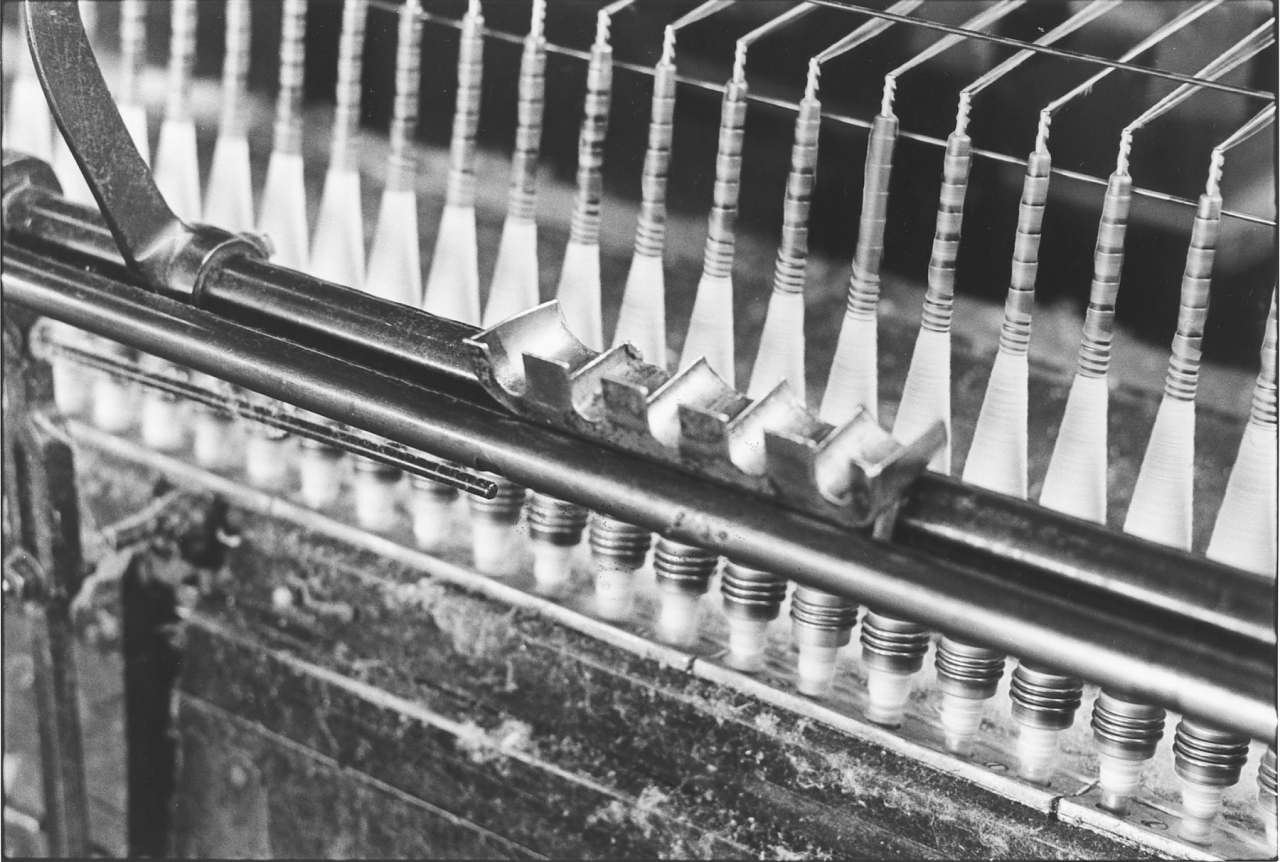
R- This to my mind, you know, is a really remarkable picture, in as much as you have got a close-up of the spindles and you can actually see the vibrations of the threads. You see, the whole thing, as I have said before, about spinning is that the yarn is twisted on its own axis. And you can actually see it happening here in as much as the spindles are not vertical, they are inclined at an angle and that angle is of course specifically measured, it’s not just any haphazard angle, it's specifically measured for the type of material that we are spinning. And it can be altered of course but this particular angle that these are set at has been found to be okay for this type of thing and you can actually see the vibration of the thread as it slips off the end. As the spindle revolves it slips off the end, and you can see the vibration of the thread in the photograph itself and I think it’s a really remarkable photograph. And if you look along the top of the spindles, some of them you can nearly see it slipping off you see with the result that this vibration is set up and this is where you get that ooziness in the thread, in as much as while it’s vibrating like that it's shaking out the ends of the fibres, tie shorter fibres, and you get the fullness. And that’s the secret of [condenser] mule spinning is this fullness of the thread you see.
Yes, that’s it, yes.
R – And I think that’s a remarkable photograph is number 82. Right.
Yes. I’ll see you get one John. No but I’m going to say, you’ll get some of these pictures don't worry.
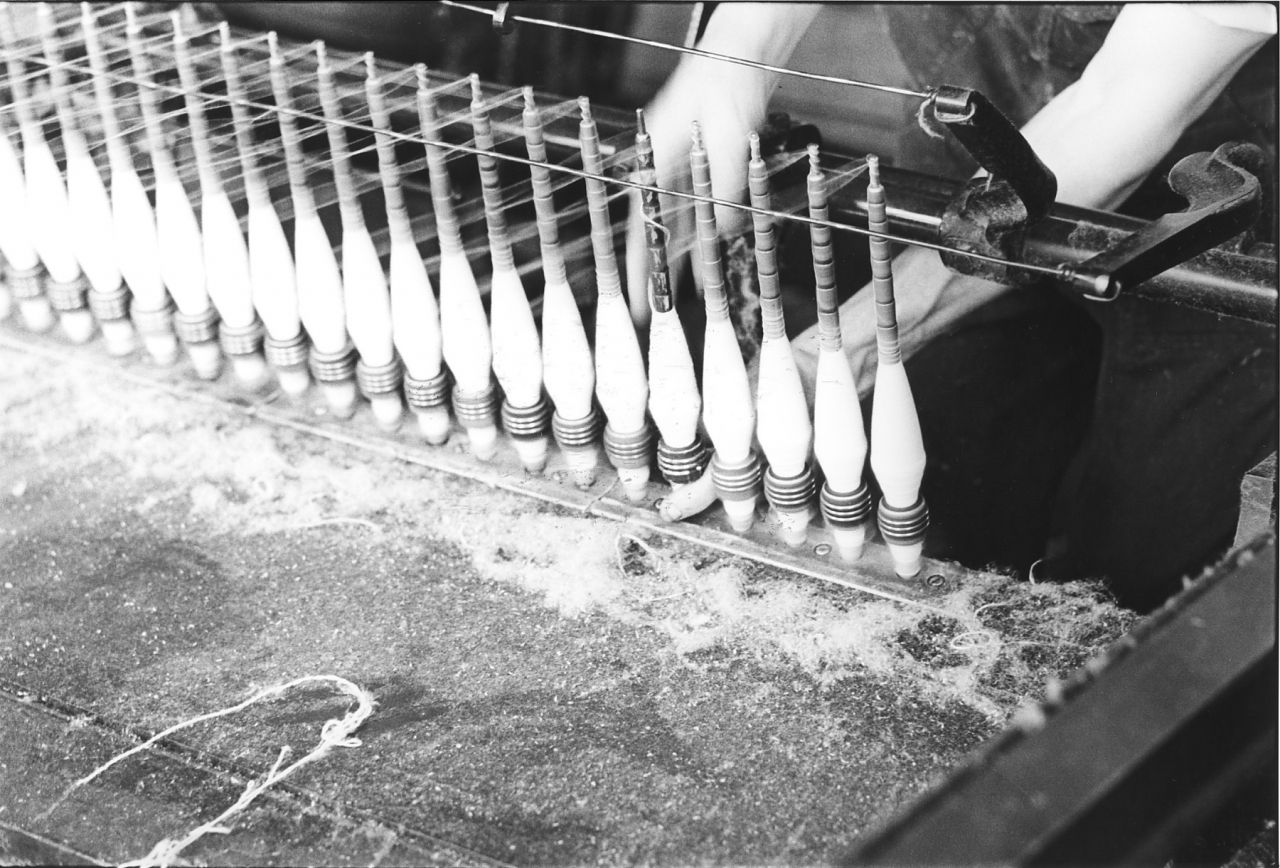
[83]
R - Oh but. And now, picture number 83 shows Jim finding a thread that's been lost. You see, in other words the thread's snapped and it's buried itself into the centre of the cotton that's already on, and you can see him lifting the thread up so that he can piece it up to that which is already hanging on the carriage.
And of course he's got to stop that spindle to be able to do that, hasn't he?
R- Oh yes. Oh he's got to stop it, yes.
So that’s why his finger is at the bottom, he's putting a brake on that and it'll slip underneath, the band was slipping.
R - He is holding it yes. They are driven by string you know from centre of the carriage. In the centre of the carriage there is a tin roller and that tin roller is the driver to the bands that drive the spindle wharves. And of course the point is that there is two ways of putting twist in, there is what we call twist way ‘S’ which is clockwise and there is ‘Z’. No, I'm going the wrong way around aren't I, it’s so long since I was in, there's S and Z now, but it used to be twist way and weft way.
That’s it. (5 min)
R- Now weft way was anti-clockwise, and twist way was clockwise. Because why twist way and weft way? When cotton ripens in the field, I don't know whether you know it or not, but the fibre is solid. And then as the moisture dries out it collapses and by a strange freak of nature the fibres all curl clockwise. In other words instead of being a round cylinder it collapses, it curls and they all curl clockwise. And it's a strange thing is that, and this is why when we talk about twist and weft if you put twist in twist way you see, which is clockwise, in other words the same direction that the fibre itself is twisted, you get a stronger yarn than what you do if you do it anti-clockwise. But on the other wise, on the other hand, if you do it anti-clockwise you get a fuller yarn you see. And this is one of the reasons why in the trade we talk about twist and weft.
Aye, fascinating.
R- Aye. Because twist is the same direction as the natural twist in the fibre. Now by virtue of the bands on this central tin roller being put on in a certain way, the spindles will either go clockwise or anti-clockwise. And if they go clockwise of course the thing is that it gets, it is a stronger yarn.
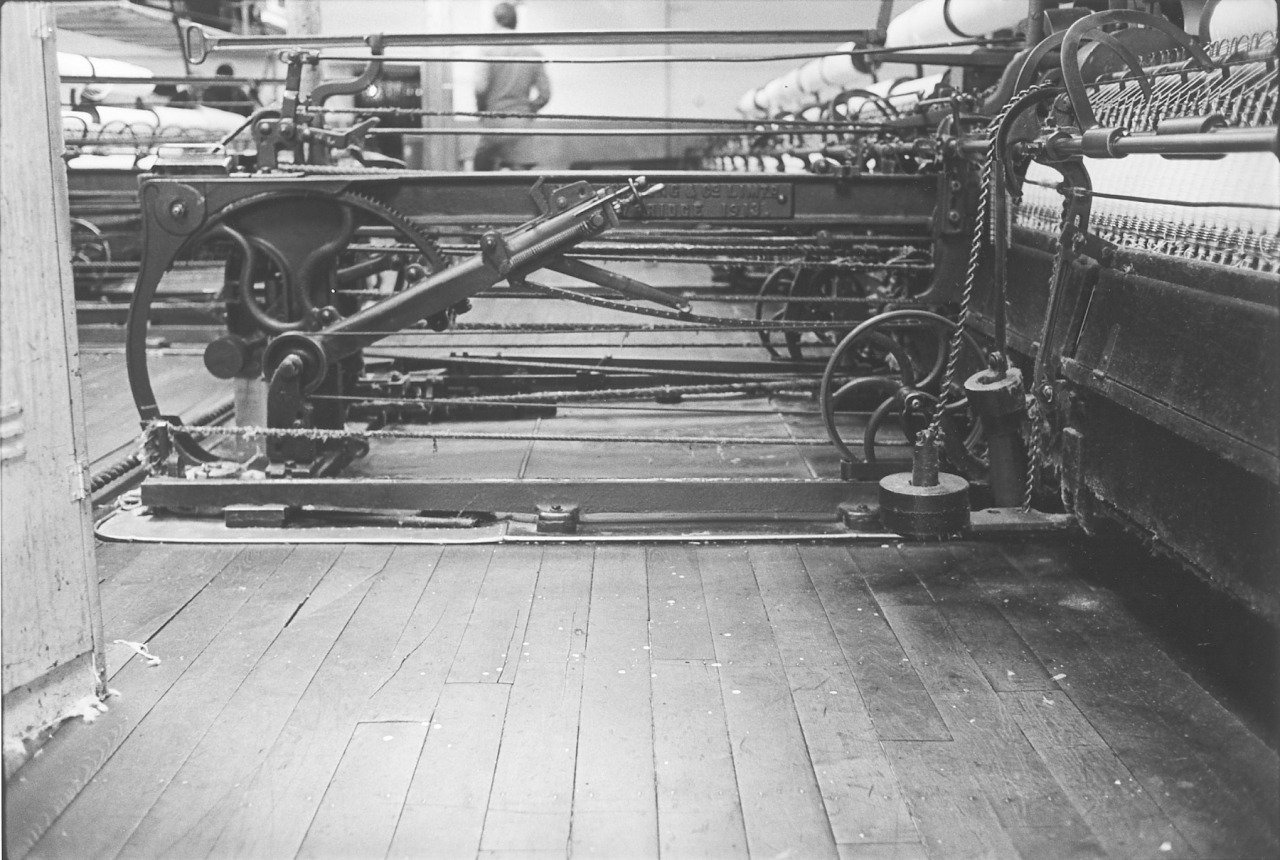
[84]
Now picture number 84 is a photograph of the headstock and on this particular photograph you can see what we call the quadrant. Now the quadrant is the mechanism that does the winding when winding the yarn on to the pirn, when the carriage's running in. Because you can see a chain, you can see a quadrant arc and its arm and then you can see a chain going into the headstock. Now that is actually wound on a drum connected to the tin roller. So, what happens is that, as the mule’s coming out, that chain is wound up you see. Then when the run is complete and the carriage is going in that chain is stationary, held by that arm which of course pulls it up the drum and causes the spindles to reverse into the opposite direction and wind the yarn on you see. And of course the thing is the teeth govern the length of the, shall I say, well the length of take off you see. Because you see again we find out that when you are winding on you have got to wind a little bit tighter on what we call the nose. That's where the yarn meets the pirn. We have got to wind a little bit tighter to stop it slipping off you see. And you'll see this arm protruding which presses down on the chain as it's going in and it just makes it go that little bit tighter. Now 85 is the other side of the headstock which shows what we call the copping plates. In other words you'll see there are two sets of plates here at the front.
Just one thing John. Sorry to interrupt you but later on there in some close up pictures of the copping plates and the builder.
R- Oh well then…
When we get further on and the bootleg as well so that’ll be easier for you to explain.
R- Oh well, I'd better explain, but anyway it's just the other aide of the headstock is 85. Ah Taylor Lang Limited.
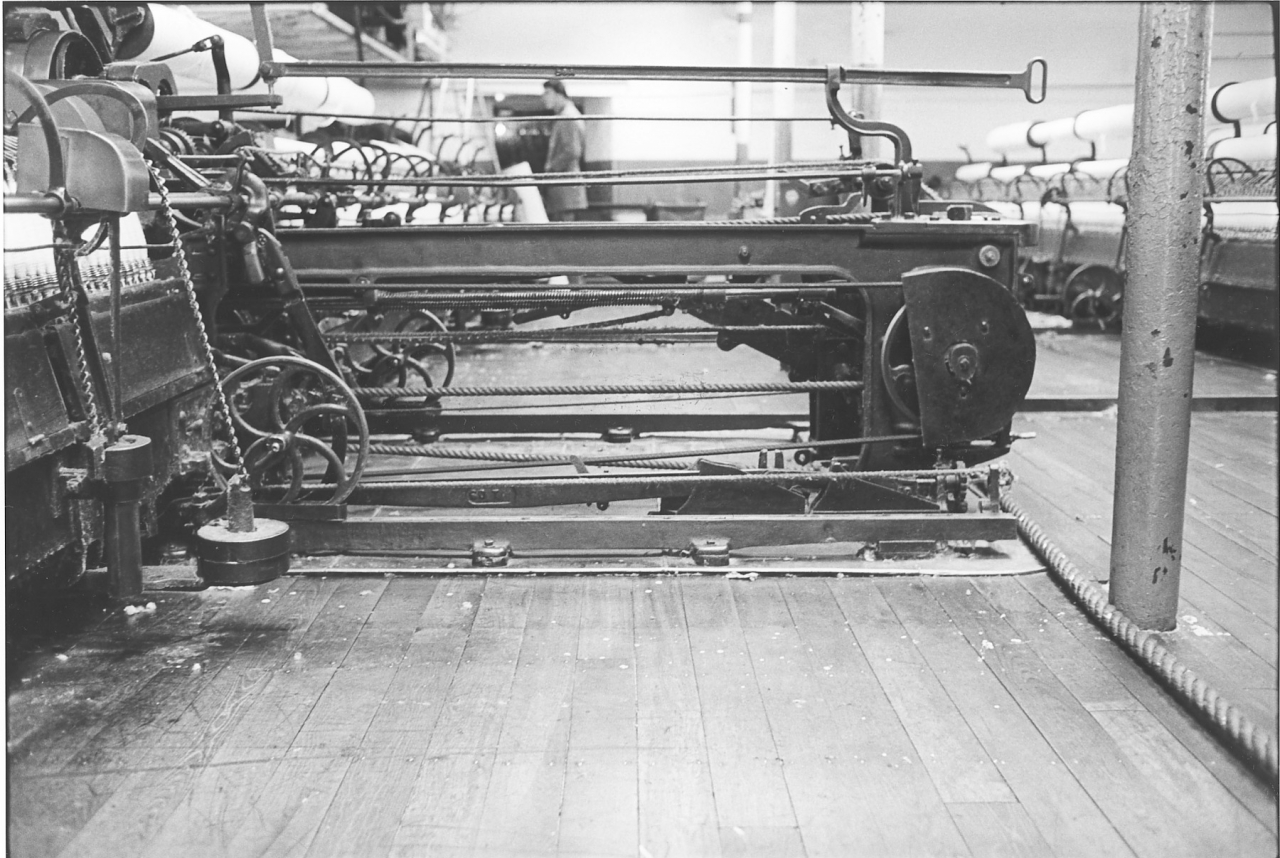
[85]
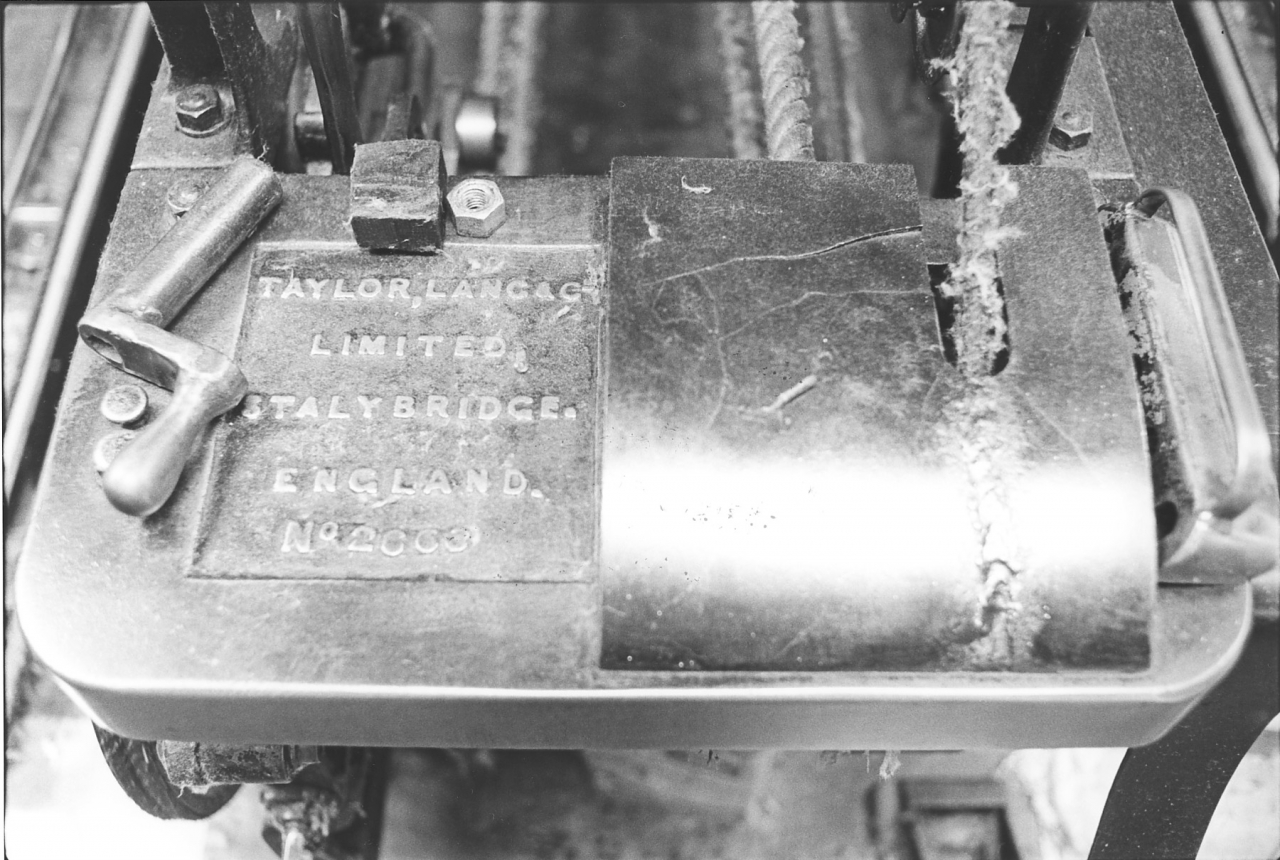
[86]
Picture number 86 is just a nameplate although the date is not shown on these. But if you, the date is usually on the end of the machine and if you looked at them you'd find out they are about 1903.
Yes. Well these actually, this one isn't Jim’s mule, it's on the top floor and this one actually I think is 1919. Yes I think one of them's a bit later up there
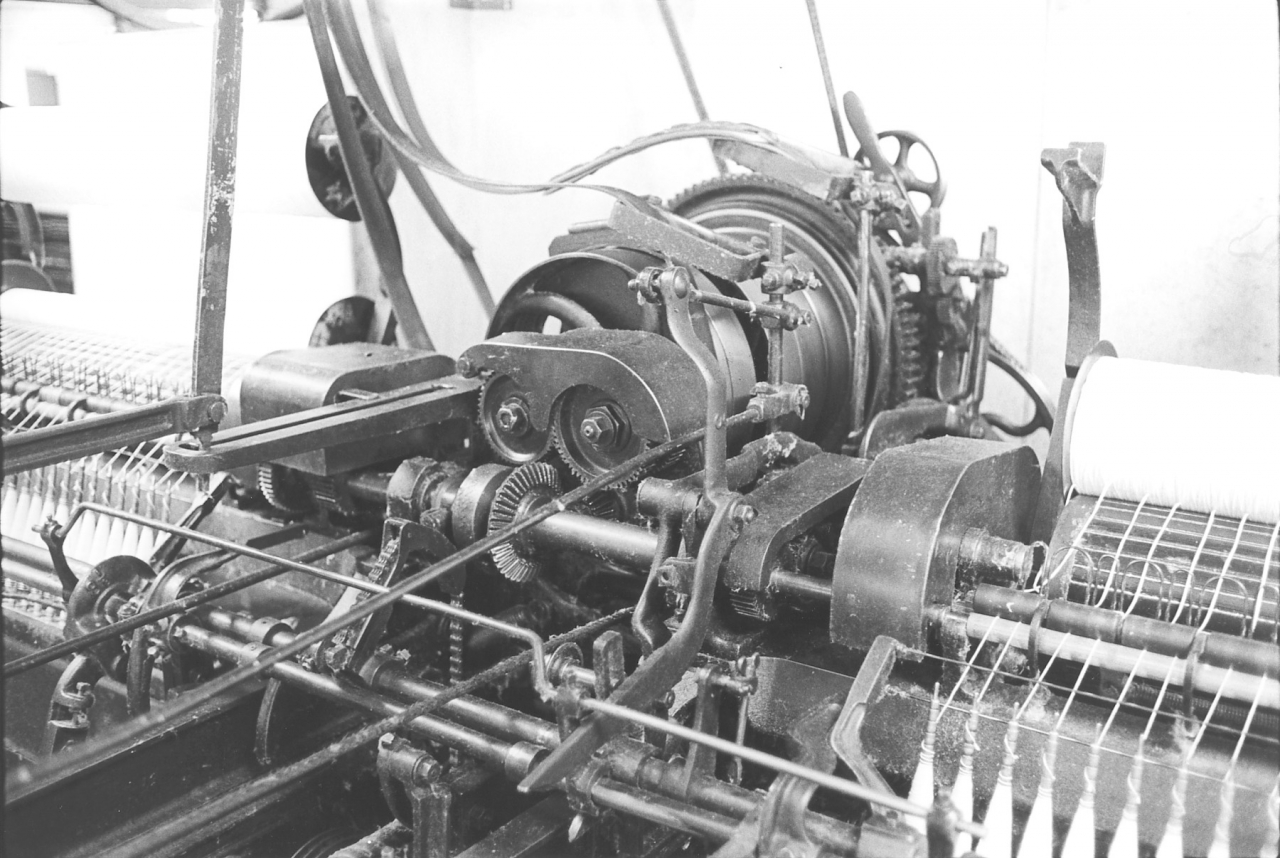
[87]
R- Oh aye, yes. Ah well then, picture number 87. Oh I could tell you a story about these. I mean, you know…
Well yes, I mean where do you stop with picture number 87?
R- There it's, it's the real picture of mechanism there, you have got the first pair of pulleys which are the carriage pulleys, that narrow strap I have mentioned previously and then you get the three pulleys for the twist strap which is an inch wider than the carriage strap.
Yes. Of course one thing that I should point out, this was taken during the holidays and that's why the straps have been knocked off to let then take up again.
R- That’s right.
Yes because it was the only time when the mules were stopped and I could get in close enough to them. But, the thing is I don’t think that you really need to go too deeply into all the mechanism John because I mean there are good books like Catling’s ‘The Spinning Mule’ which can tell anybody who is really interested in the mechanism. But in't it, is that fine spinning? (250)(10 min)
R- Yes. No, this is condenser spinning which is a trade on its own.
Ah, it’s a different headstock altogether.
R- Oh yes, definitely. They only have two pulleys.
Oh. Yes now, if somebody wanted to know all about this is there a standard work on them? There isn't ?
R- No there isn’t. No there isn't a standard work at all you see. This is a …
Aye. Oh we are going, I can see there’s going to be a bit of a job for you somewhere then.
R- Ah well, there isn't a standard work on it at all, only mine in my notes and those are written.
Is that right? Aye.
R - No there isn't a standard work.
Oh, I shall have to talk to you about that, the only…
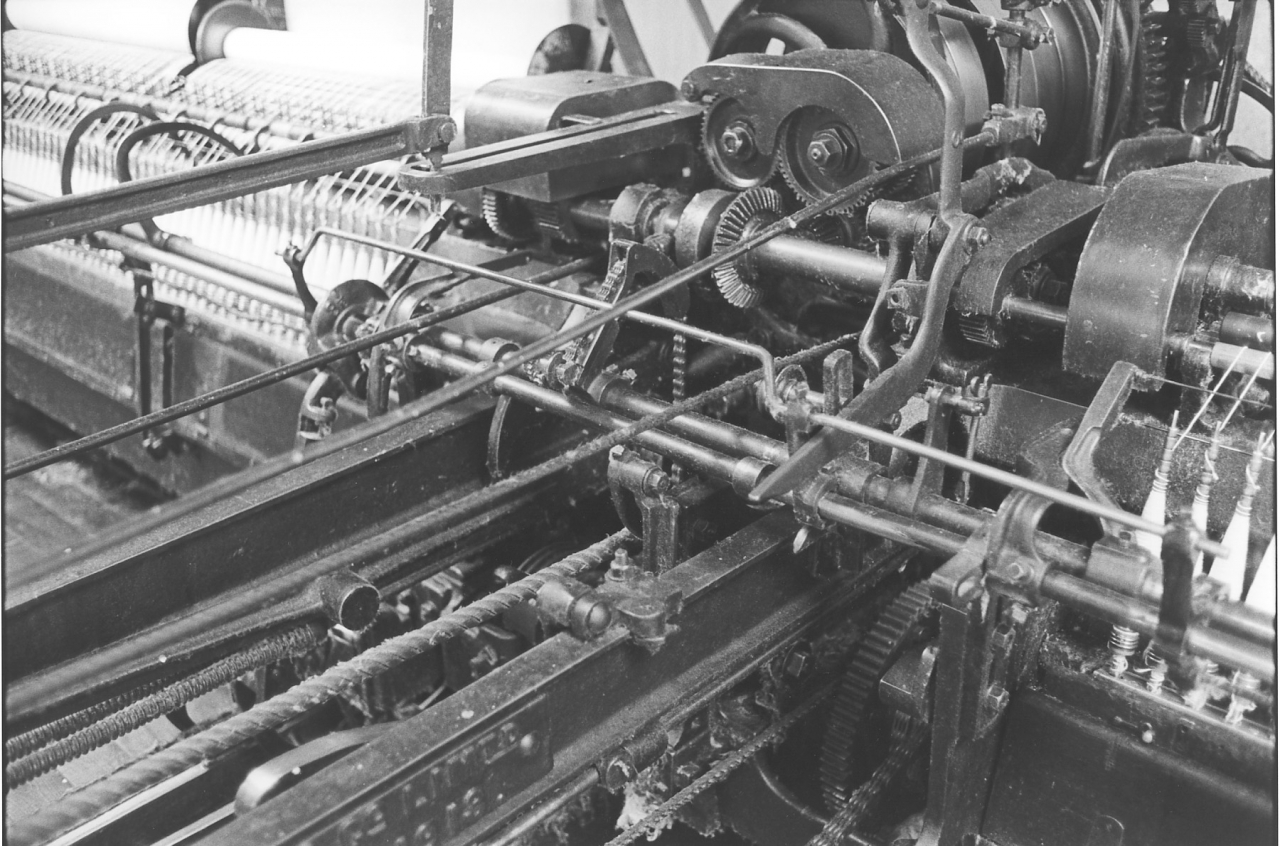
[88]
R- Well now, picture 88. Again this shows further mechanisms on these. You see this long rod that you can see here is to stop the mule at any part of the length. They extends the whole length at both sides so that by virtue of pulling the rod they can either start the mule or stop it. Because through the levers it causes the straps to go on to the fast pulley and so on.
Yes. Tell me something John, do you know whether it's true or not, I have heard it said that the headstock of a mule contains every mechanical motion known to engineering, and it seems to me that it could very well be right. Because I mean there's everything in there isn't there. You know levers, chains.
R- Well if you are going to, aye if you are going to say that you have got the whole lot, you have got clutches you have got spur wheels, bevel wheels, clutch wheels, friction clutches, tooth clutches ...
Scrolls, shafts and levers.
R- Oh, there is a thousand and one levers. Because you see that's what I say, the point is that even on the carriage run out you've got to a point where certain levers come into operation to bring in the second speed. And then when it's gone so much further certain other levers come into play to bring in the third speed. And then when you get to the back, that’s when the carriage is to the [full] extent all these levers have got to be neutralised to bring in the big friction wheel that you can see at the back which is called the backing up friction you see. And levers bring that into being which causes the fallers to come down you see and get into the winding position. Then that's immediately thrown out, and there's another clutch down here what we call the drawing up friction which is a dish clutch. You see that pulls a mule in you see. But by virtue of what is pulling the mule in of course that chain, as I have already said is unwinding from the drum and causing the spindles to wind. Oh yes, it's a very complicated piece of machinery, oh there is the copping plates. There are the copping plates. Now what happens is that every time the mule comes out you see, there is a little what we call the pig tail in a lever and it comes out and every time it comes round it catches a catch, which causes that worm wheel you see, that pawl and ratchet to turn one tooth or two teeth as the case may be.
Yes, that’s the builder isn’t it. [090]
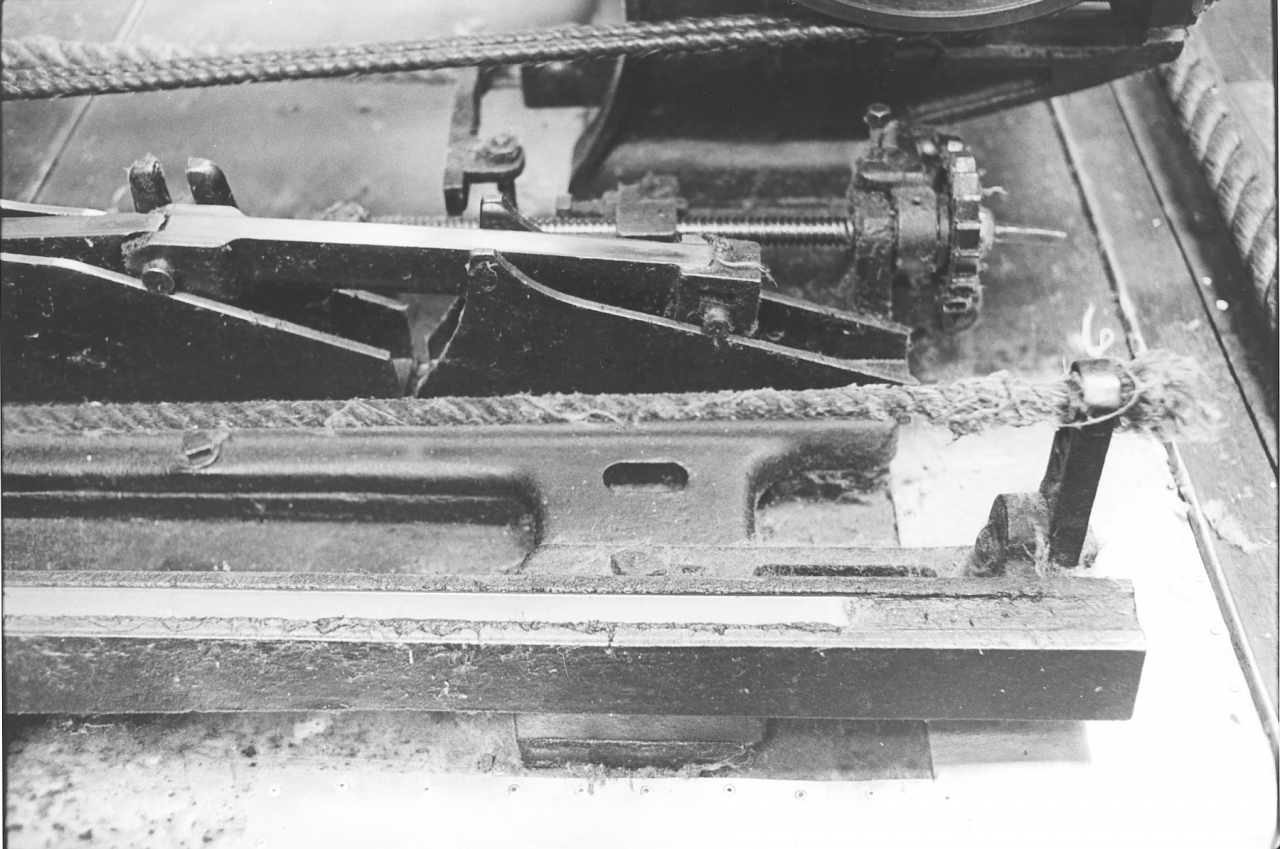
[90]
R- And when that turns, that worm, it causes that block to travel. Now attached to that block in the shaper plate is the rail, shaper rail. Now the shaper rail end rests on the shaper plate so as that block moves it causes that shaper rail to move up the shaper plate and that is actually the profile of your cop you see. But you can see and it's specially planed you know to specific limits. Now this is what we call the winding-on section. In other words those are the binding turns. When it’s going down they are coarse turns you see that bind the yarn on itself. And then you get the long trailer, long trail which is the ordinary winding on. In other words, these, the short plate are the locking turns so that you can build up a solid cop. Because they are coarse and go down quickly, whereas this layers it, kind of layer on layer.
Yes, that’s it. And as the carriage come back - tell me if I'm right or not - the profile of this rod, this shaper.
R - Shaper plate.
Shaper plate. Well shaping rod, the rod itself or the copping rod as Jim calls it controls the position of that bootleg doesn't it?
R- Well, the bootleg rests on there.
Runs on that.
It actually runs on there and according to the profile of that
Yes, the bootleg.
R- The shape is transmitted to the fallers.
That's it, yes,
R- In other words the fallers rise according to the bootleg, and as the bootleg travels up that profile of course that motion then is transmitted to the actual winding on ...
Yes, to the actual, yes for winding.
R- You see, and as that’s altered of course every draw, The position of that shaper plate alters.
Yes. That's it, aye.
R - And again, you have got one that, I think that it's this one, this one forms the base of the cop.
Yes that's right.
R - In other word you know, how it tapers at the bottom. And then comes parallel. Well now, this forms the base of the Cop.
Yes, that's what Jim said.
R- And then when the base of the cop is formed and you're starting to build the cop, that comes out of action because…
So that’s the shaper plate that’s nearest to the right hand side on pictures 90 and 91?

[91]
(400)
R- That's it. Because what happens is that that stud apparently gets to a position where it ceases to function beyond a holder because this then takes over you see because it's higher than that. So that the angle you know is…
Yes, that’s it, yes. Immensely complicated.
R- Aye. Oh it is. Ah, there you are, there that’s they that's picture 92, that shows the shaper mechanism.
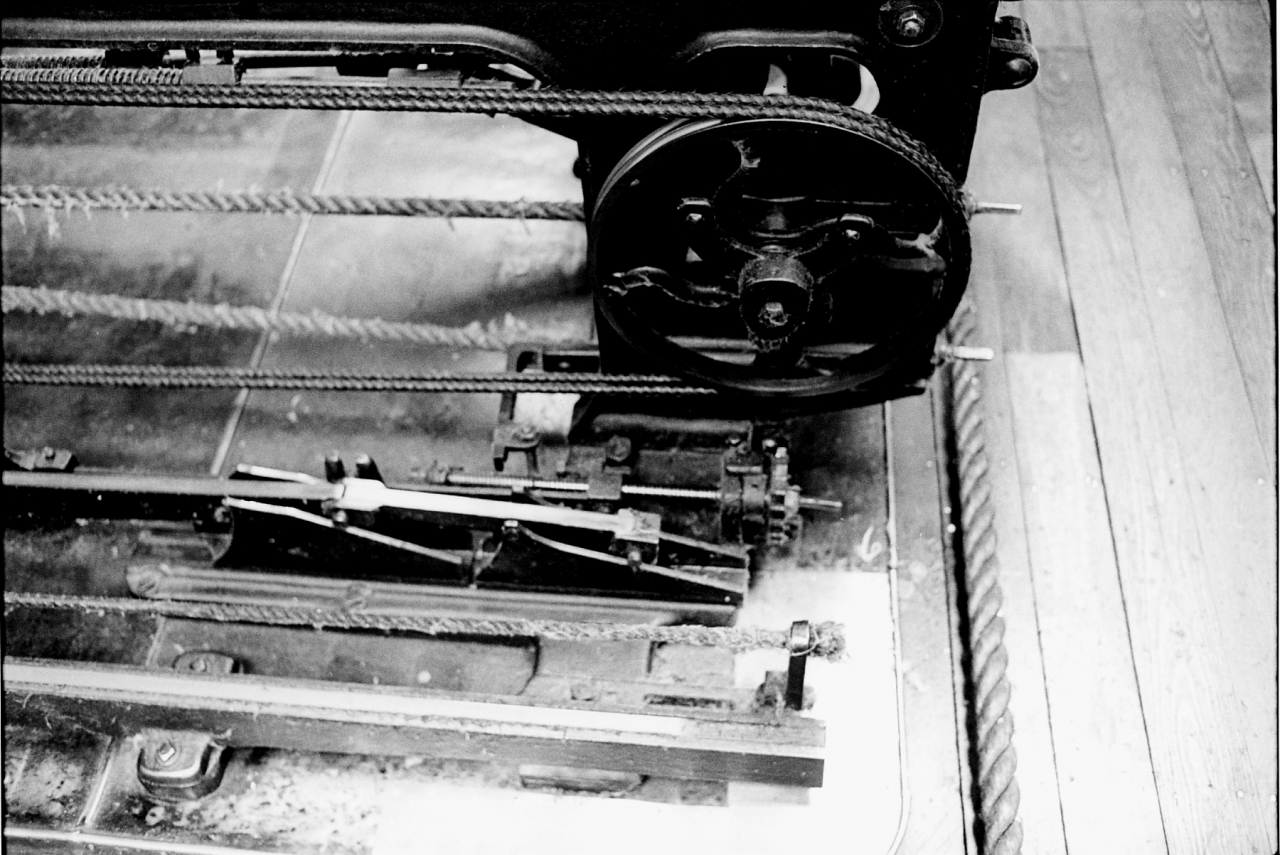
[92]
Once again, John, I should just point out, I mean this isn't for you obviously, this is for the anybody that’s listening to this tape, that the thick rope on the floor that you can see is nothing to do with the mules, it's a rope which was being stretched by the rope splicers between two pillars. So it's nothing to do with the mule. Because ropes do play a big part in the operation of the mule don't they?
R- Oh they do indeed. Because you can see the pulley, now this is the rim band
Yes. That's the double rope we can see on picture 92.
R – Yes, that drives your spindles.
Yes, on picture 92.
R- Picture 92. It drives your spindles. Actually it goes round the tin roller you see. It goes round the tin roller. But like I said when the chain is driving the spindles for winding on purposes this is running free on a clutch, you see.
Yes. And that's going to be put in and out of gear each time, yes aye.
R- Yes. But that rim band of course, they reckon if a rim band lasts six months it's done a long time. But you see you can't afford to let that slip, because if you do you see the twist per inch in the yarn is governed. Now, if your twist band is slipping you are not getting the twist that you should have.
Yes. I think Jim said that if you have a tight rim band it's worth an extra tooth on your builder ratchet.
R- Yes, aye.
He did say that and I think he said that an old spinner once told him, and he has always done it, never to have the rim band too tight, but rather to put a, have a tooth less on the builder ratchet. Because he said it’s very easy to tighten it very, very tight but he said if you do your bands don't last as long and he said it's better to balance it out between the two. (450)(20 min)
R- There's another point too, that if you have your rim band too tight it can affect your spinning. Because you see, the thing is that these types of mules have what we call twist on the head. In other words, when it's finished its drawing out the mule remains stationary until the necessary number of turns have gone in which is controlled by cams you see. So it’s twisting on the head. Now you get it very tight and you'll hear it buzz you know, giving a loud hissing noise which means that the vibration, if the quality of your material is not so good it'll just snap off. And I've seen it happen dozens and dozens of times.
Yes. And another thing that Jim said about that was something that you were talking about then, when it does that winding on the head. He said occasionally, and I've forgotten what he said caused it, he said "It'll go over and wind again''. And, because he said to me “There is one thing you haven't got yet, a picture of a sawney.” And I said I'd like a picture of one but I don’t want to be there when it happens. And he said we have them quite regularly. But he said one thing that can cause it, when the twist mechanisms can sometimes go over a second time. And he said there is nothing you can do to stop it once it’s done it, he said you just stand there and watch them all pop out and he said it's a rotten feeling to watch them all pop out all the way down.
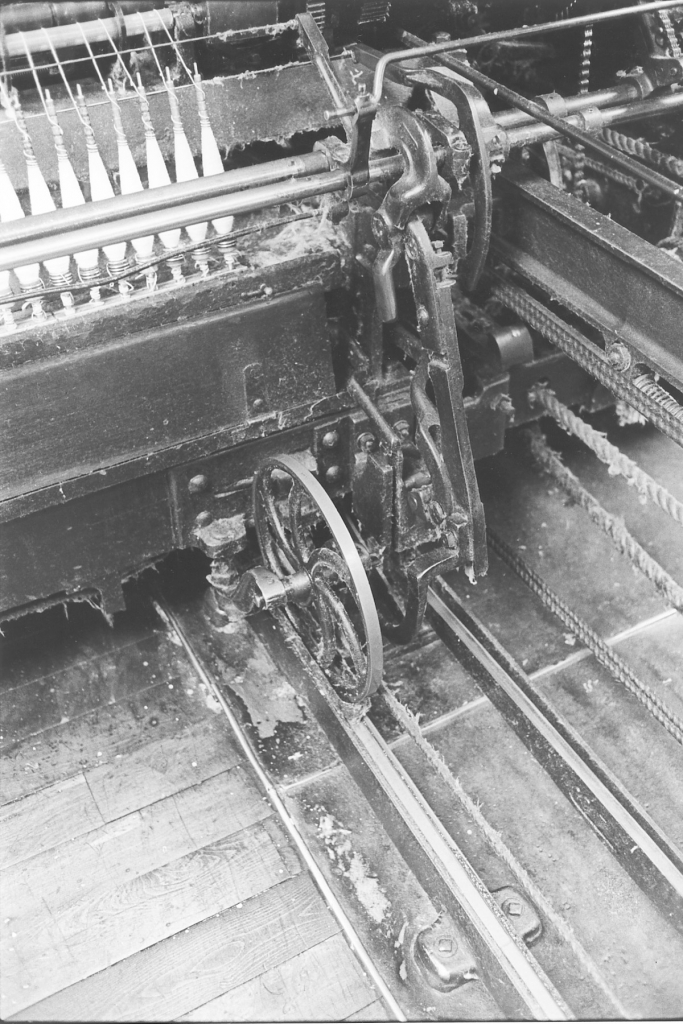
[93]
R- Well, number 93 is a good picture of the boot leg. Now the boot leg is attached to the fallers as you can see and it actually rests on the copping plate, the shaper plate, the shaper rail. It actually rests on, you can see that the profile of that shaper rail is transmitted to the fallers you see which guide the yarn. Picture 94 is just the mule at rest. You can see the slack bits of yarn on the pirns because the thing is it takes those up. If we hadn't those, when that mule started out it would break all the ends down you see because that just gives it that little bit of shall I say slackness before it starts drawing out. Otherwise if you started to try to draw or spin yarn, it would snap you see?
Yes. It backs off a little bit doesn't it up there? When it gets into the carriage, all the spindles stop, and just turn backwards a little bit to give you that little bit of slack before it comes away doesn't it?
R – Aye. That’s it yes.
And then 95 was just with the door open to show the spindles.
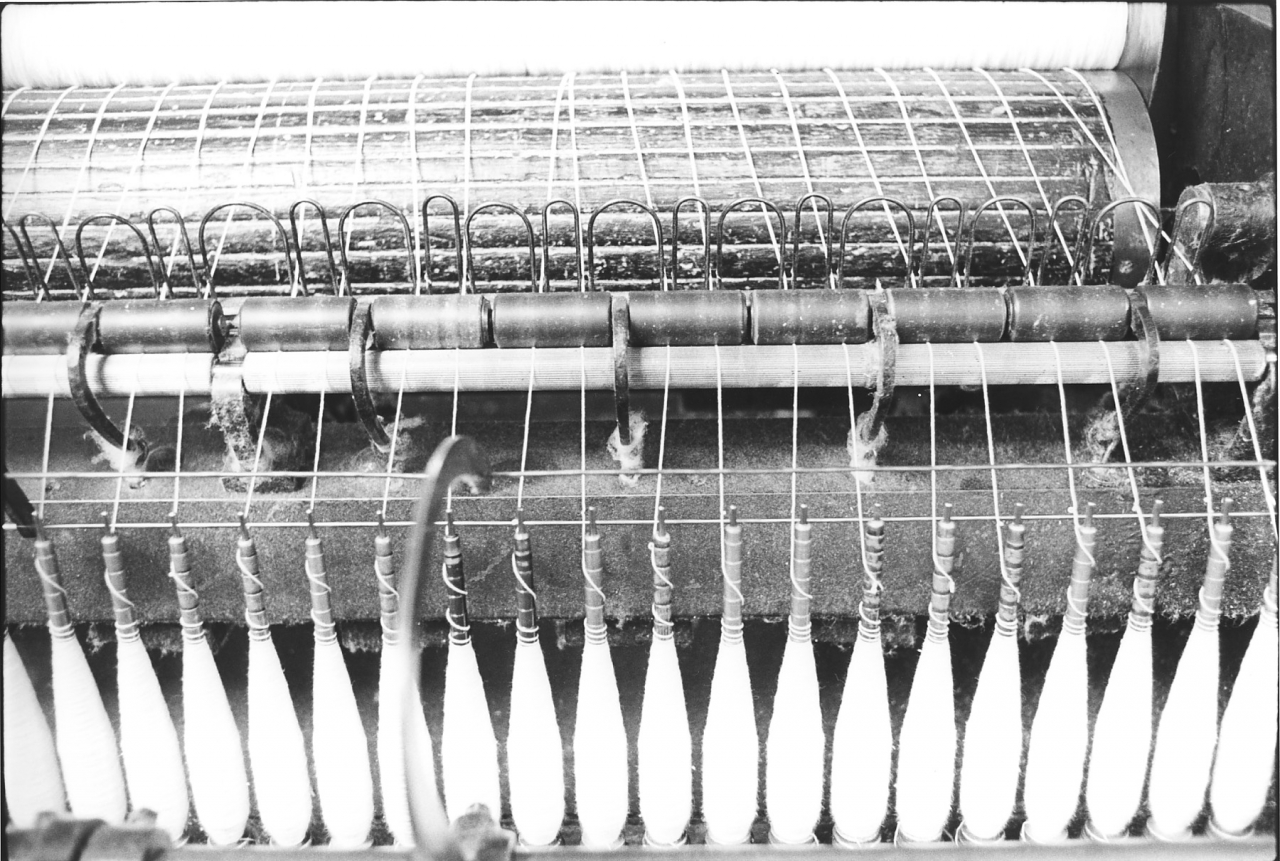
[94]
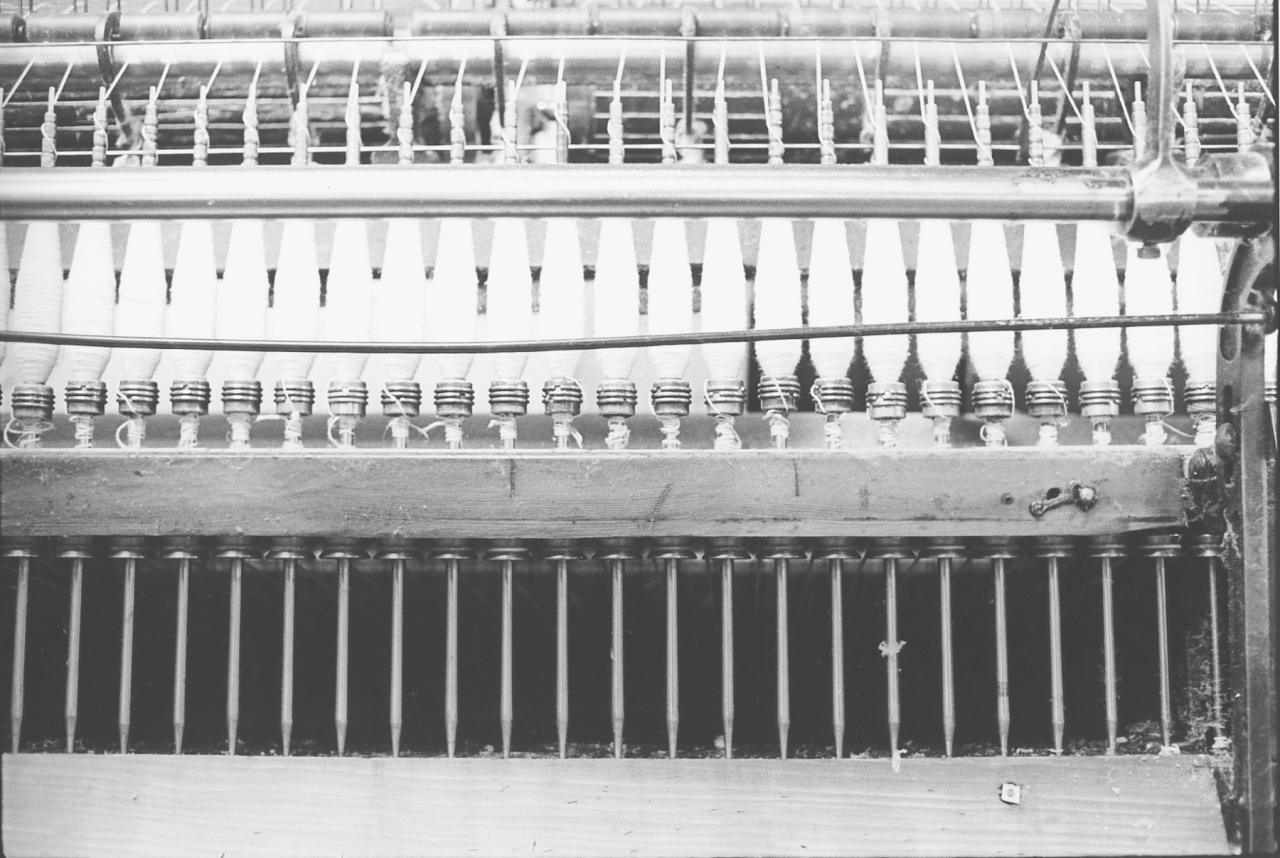
[95]
R- To show the spindle wharves, yes. That’s where the band goes. Or whorls, some call them whorls but we call them wharves. Now your spindles notice are held at two places, that’s the footstep and the bolster. Yes, that’s the bolster. That's where all the strain is in as much as you can see that when the pirn gets full there's a fair pull, and it's whirling round there's a fair pull on there. And there's the footsteps, they have to be oiled at least once a day.
And the last picture 96 is an extremely dull and uninteresting picture after that of well there, you tell me what it is now.
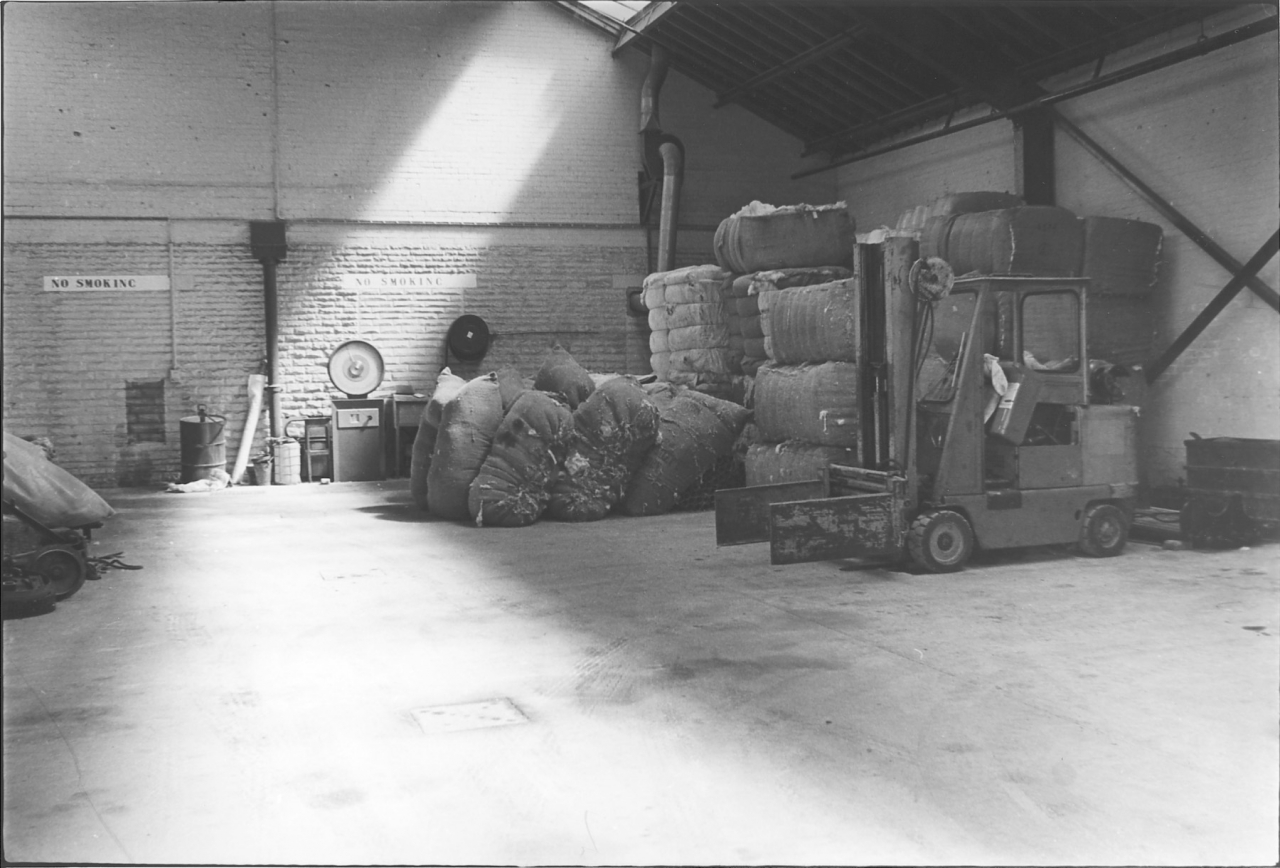
R- Well, that’s the bale store.
Bale store.
R- And at one time, which I believe doesn’t happen these days I've had a thousand bales in there, I've had a thousand bales in from all over the world, Russia, China, Switzerland, Brazil, America, Peru, Italian, French, and Russian. In point of fact those are nearly Russian bales.
There were some Russian bales about.
R - Aye, those are ...
Yes those bales that are just behind the store, where the fork lift is there. Yes, there were some Russian bales about. Now tell me John, do Whitakers send some out you know, for other people to process when they have blended it? Does some go out.
R- Well it's a line that never really caught on in as much as we used to do. And several people have tried our material, but you see we were always too costly, in as much as, although I say it, it was good stuff that went in. You see at one time I can remember the time, oh it used to be a real nightmare did this blending because I mean it were your responsibility. And of course, the thing is they expected a good spin with good efficiency from the mill. And of course you know the Lancashire saying, “You can’t make a silk purse out of a sow’s ear.” Well they used to expect it and it took years and years to educate the powers that be that they didn’t know everything about waste. And I was very happy in the later years to be consulted in as much as I used to get the complaints. I mean, so often the directors would come to me and say I wasn’t using enough of so and so’s waste or not enough of this quality or that. Until I took it into my head towards one of them and told him that if he’d give the word in writing I’d put it in with pleasure. But I wouldn’t accept for one minute any responsibility for how it spun. And of course it was the usual blah, blah and I told them quite straight, the quality isn’t good enough to spin what they expected me to get out of it. They told me it cost to much and I said well you can’t spin cost.
That wouldn’t be allowed for. That’s a good one, You can’t spin cost, yes.
R- Gradually they were educated and I mean educated into consulting the chap on the shop floor and it got to be that in, oh I should say the last 10 to 15 years of my time there I had one chap over me. I mean I wasn’t always the factotum who used to do this job, and he got other duties. But you see he never did the buying, the directors always did the buying and it got to the point where they used to send me the samples you see. They’d send a sample over to me or call me in to the central office. “Will you come across, we have got some samples, we want your opinion.” And do you know we romped on afterwards although I say it. I mean I'm not boasting but the thing is now it gives me great satisfaction when I go in as I do, “When the hell are you coming back!” You know what I mean? Because well it was in my own interest. You kept your spinners happy, you got your production you see.
Well, that’s the name of the game isn’t it. You earn it off the looms.
R- The point is that there is no good putting rubbish in because it's cheap you see. And if you put cheap stuff in, let’s say for argument sake it's 2p a pound cheaper than a better quality. But your production drops by 10%. And your finished product is 80 pence a pound. You’re losing 8 pence to save 2 pence.
Which is had business apart from anything else.
R- Oh it is bad business. And not only that you see, there is dissatisfaction right through the mill because it won’t card properly, it won't spin properly, bad spinning's bad weaving and bad weaving's bad cloth and bad cloth's a dissatisfied customer.
One thing, tell me about one thing if you will please John. What interested me when I was talking to Jim. And he said that, I asked him, the question I asked him was tell me Jimmy, sometimes when I go up your creel is full of bobbins all the way down and other times when I go up there are very few bobbins on. And he started smiling, he said well, that all depends on what sort of bobbins are coming round on the rack. And he said that at one time they had what he thought was a very good system. He said every three months they used to reverse the direction of the bobbin rack. because that meant that the people who had been getting the mucky end of the sticky after they had all been picked over got the clean end of the stick. But he said they don't do that now. Now do you know who instituted that, it seemed to me to be such a good idea you know, you know to even things out for them. Because human nature is human nature, and you can see them taking the good bobbins you know if they are there. And who instituted that idea John, is it a general practice?
R- That’s lovely! I did.
Well, I didn’t know but I thought it might be.
R- I did.
Now tell me about it because that seemed sensible to me.
R- Well, it’s like this you see, that if you get a bobbin that's had three ends down and it's been readied as we've afore mentioned, it can be a small bobbin which might be a third full, it might be a half full or it might be two thirds full. But you see as a bobbin builds up, the diameter increases, so that the thing is that instead of say taking two half size bobbins to make a full one it actually takes about four due to the full ones increased diameter. And you see, so that the chappie who has to have all the, what we used to call bits or small bobbins, he is putting four bobbins in his mule to the other chappie’s one. Which means that his mule is stopped four times more often than the chappie who is putting the big ones in. (650)(30 min)
Yes, he’s losing draws on his clock.
R- And he is losing draws, because they are on piece work and this was a point. And so, every so often when I was manager, I used to go to the mule overlooker Arnold. “Arnold, clean all those bits off.” And he would go round those small bobbins, and held take say so many to every mule until there were none at all on that rack, and we’d start from scratch you see. And then everybody got some because there were bits on that nobody would take, and I've seen then be going round for a couple of months until I would have to go and see Arnold. But he didn’t like doing this because it brought him into disfavour with the spinners. But this was it you see, but it was a system that worked and then again I used to get the thing reversed. About every three months I used to get the mechanic across to turn it round and then the chappie who was last became first you see.
That’s it yes. Well as I say it seemed to me to be a sensible idea but he said that they don't do it now and when he enquired about it somebody told him that there was something wrong with one of the bearings but it sounds to me like a bit of a tale.
R- Ah well.
I thought that but it seemed such a sensible idea you know to reverse it so that…
R- Well it’s what it used to be. And because I used to have it turned round. But I mean, you tried to be fair with everybody, I mean they are all there to make a make a wage you know.
Yes, and apart from that wouldn't you say a satisfied man, you've more chances to get a good job out of him?
R- Oh yes.
And as I say, that is the thing which strikes me over and over again about both weaving and spinning, in that everybody relies on everybody else.
R- Well they do, they do. Because let's look at it this way, that right from the very beginning on the scutcher. Where the laps have to be a specified weight, you see, I mean I need to make a point of going round and I had, I mean you can automatically in your mind’s eye tell when one lap is suspicious. And I’ve gone round many a time, “Put that lap on the scales.” And it’ll be out and of course the chap got a rollicking. What’s the good of us having a system if you were going to please yourself? Now look, either do the job right you see and then everything's gone all right for a time. But you see, if it’s wrong at the beginning, you can't right it right through.
(700)
That’s it yes.
R - And again you see the thing is that the cards particularly were what we called wrapped every day, in other words you took a specified length and it had to be a specified weight. Now those were done meticulously every day, if one was varying a bit, for instance if the chappie on the scutcher had been a little bit lax you had a chance of catching up with him you see. But if you didn't do it, only once a week…
Yes. A lot of bad stuff would go through.
R- It would have gone through and then they’d come across, they'd come on the phone from the other mill “What’s your wrappings like, we’re getting thick and thin places.” Then when you go across there you found out they had put some wrong cops in you see. Instead of being sixes they'd put fours in you know?
Aye. I know something that, one of the things that impressed me when I was talking to Jim in particular was the fact that when he was talking about getting the bits off the bobbin rack, the reason he gave, the first reason he gave - and quite obviously to him the most important - was that he said “If you get a very short bit, it's all right but many a time they have to be readied down that much they are very, very short. And he said that is bad card tenting. Because if they’d watch the card they wouldn’t get that. And he gave the reason why he didn’t like the short bobbins was the fact that he said that means that you can have sometimes two piecings in one cop.
R- Oh yes, quite easy.
And that’s in thirty cops. And he said those piecings are the bits that give trouble to the weaver. And he said that's like sixty mistakes you've given sixty chances of a break to the weaver. Whereas with luck he says you can get a lot of cops off with no piecings in at all. Or at the most one, but if you have got a very short bit that you have got to put on your creel and run off it's quite possible if you've just changed it at the beginning of, say shortly after doffing, you can have two of those in the cop. And if you are going to get mistakes, those are the most likely places to get them.
R- Oh they are. Yes.
Where you’ve pieced on the creel.
R- Yes, right. (750)(35 min)
And it impressed me that that was the first reason he gave. Not the reason that it meant stopping and creeling up again because as he said, we know it takes longer but really it doesn't take long to creel a bobbin up. That's not the main thing, the thing is that the longer it lasts the more cops you can send through without piecings.
R- Well, you look at it this way, we used to have one particular spinner and he used to say when the bobbins are full just cross the ends over the two side sides and let it run and let it build up into like, not a cone shape I don’t mean acorn shape but run over the flanges you see. Well, if you did that it took it in and it made it so that you’re getting the bobbin about…
Like built up warps, yes well we used to have built up warps. Yes.
R- Yes, like a built up warp. That’s it. And he used to say that if he got a good set of these he could forget about that mule for that day you see. And so we used to make them specifically for him. But the whole thing was you see that when the other spinners saw this you see, they wanted to jump on the band wagon and then the thing is that there was some dispute again about bits you see and we had to stop it. But I thought it was a good idea because it gave the card tenter less creeling, it made less piecings In the weft and so long as they were happy the bobbins ran all right you know.
Were they any more liable to damage?
R- Oh certainly, yes. Aye in the handling because after all when you’re lifting them up you see, some people will grab the flange. Well, if you press your thumb into the end threads it's liable when it's unwinding to constantly be a source of trouble.
Yes. Anyway John, I think you have been a complete gentleman with me this afternoon as usual, and I think we'll stop this tape there and thank you very much, once more.
SCG/02 September 2003
5,820 words.
